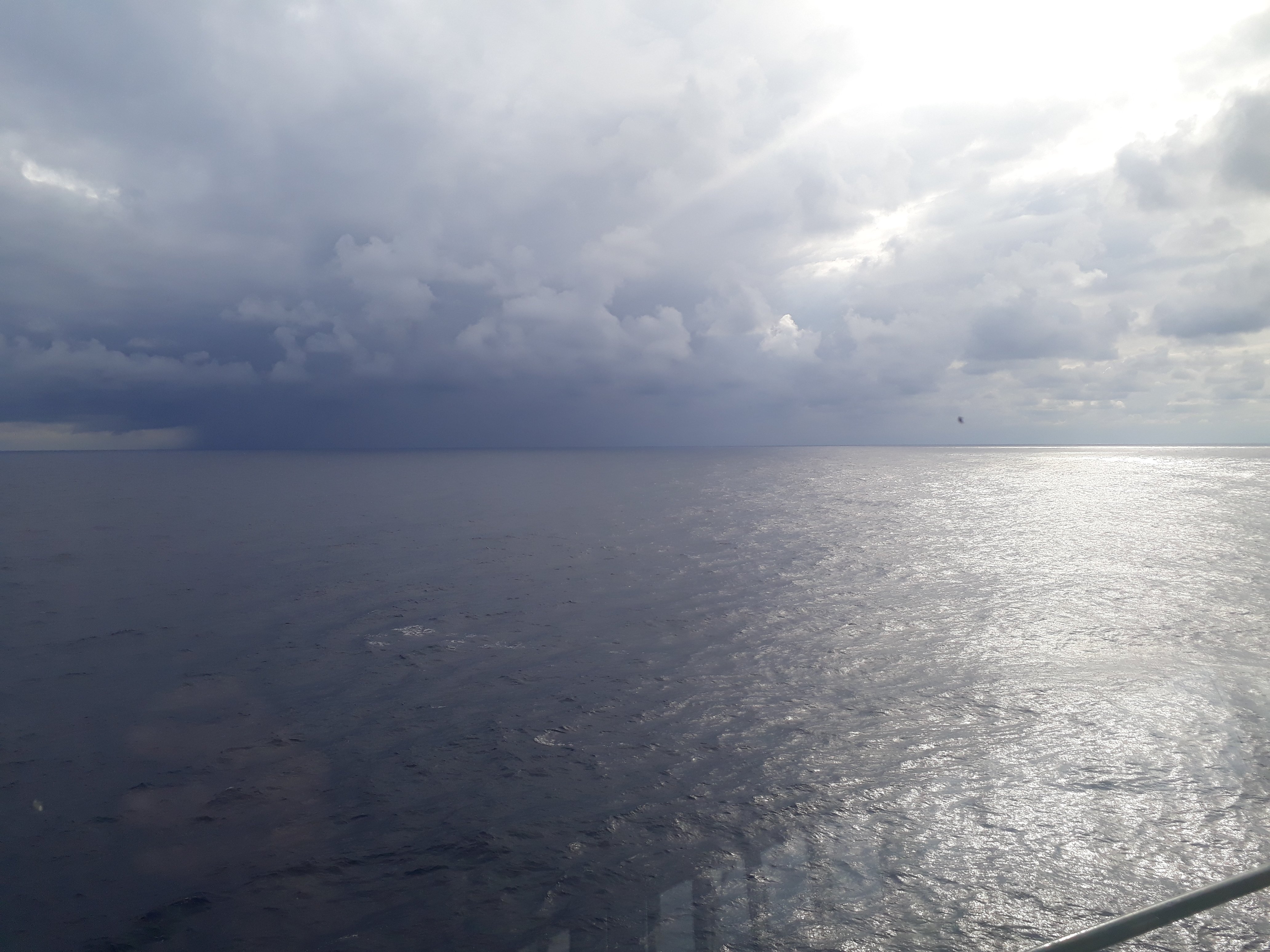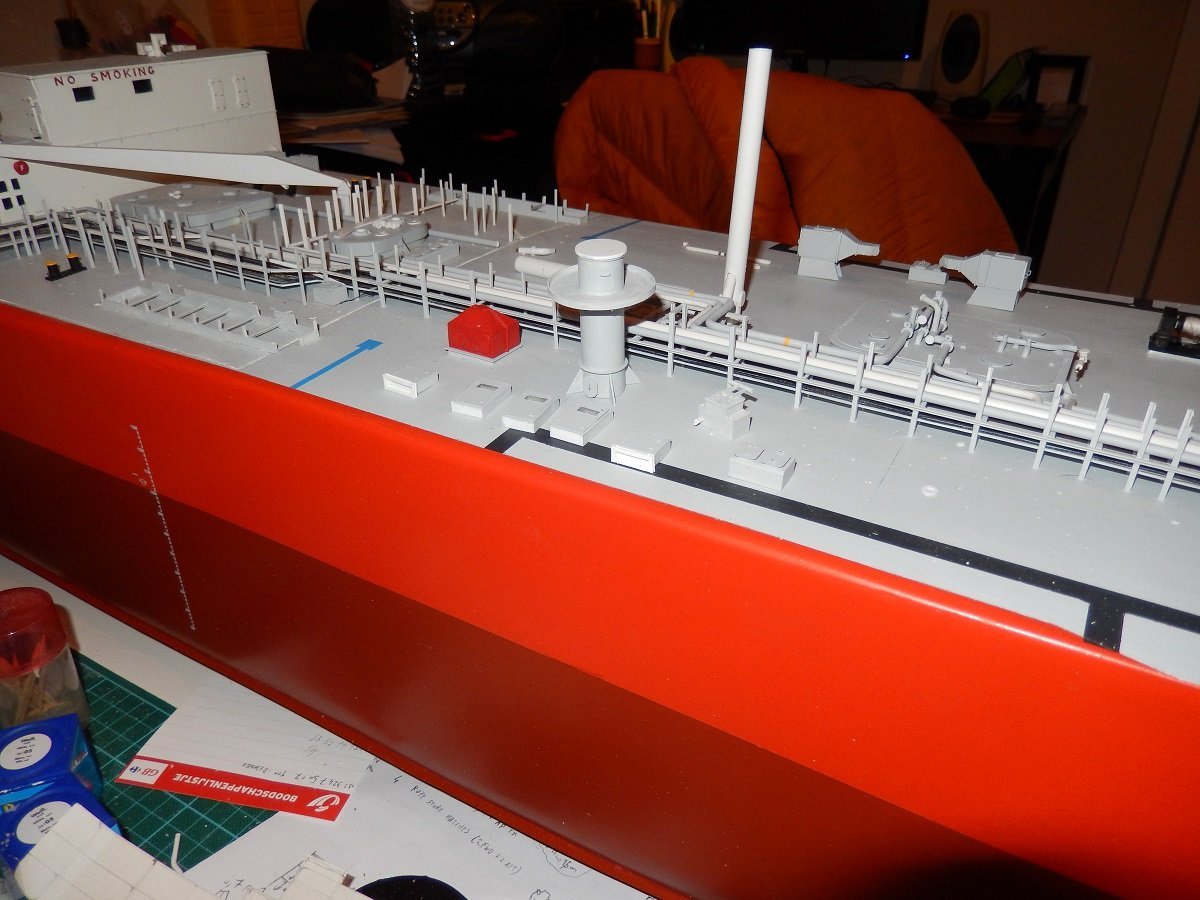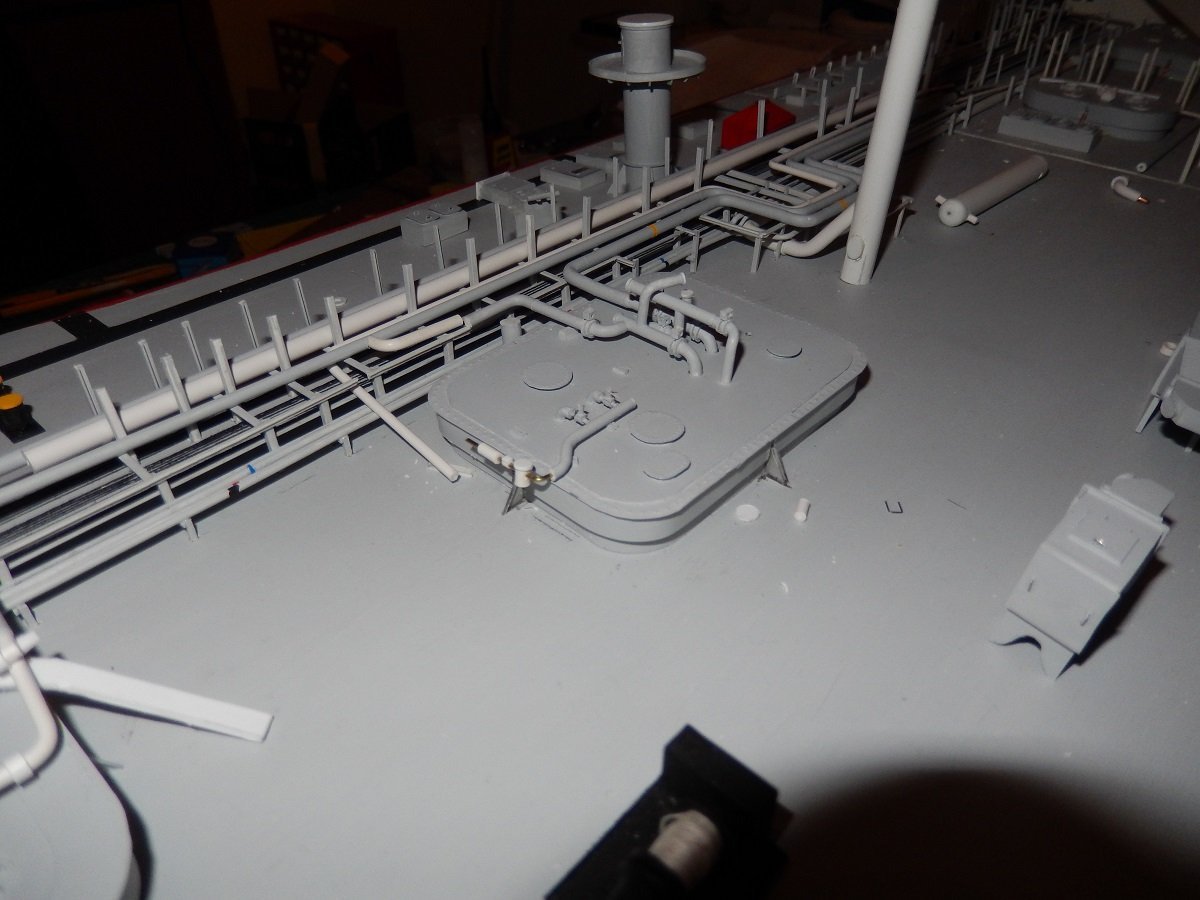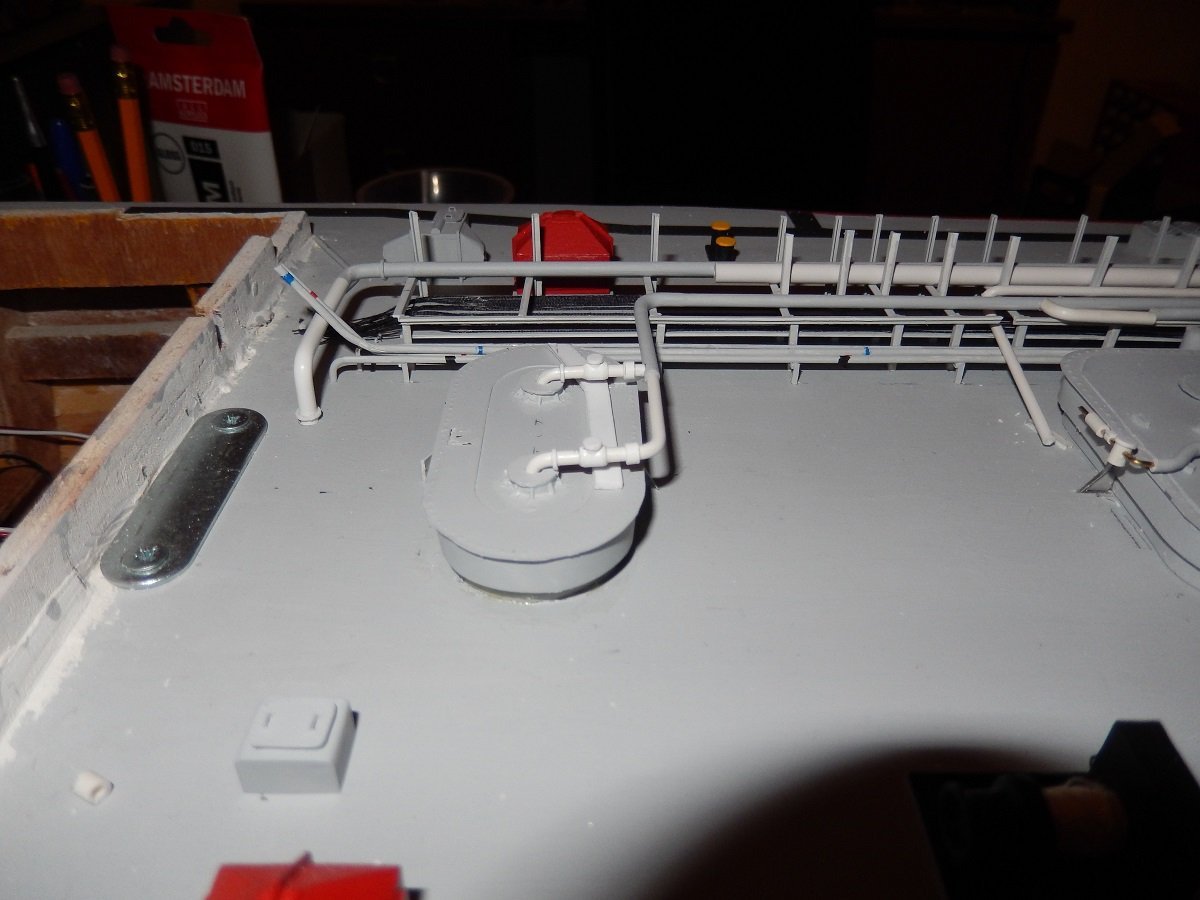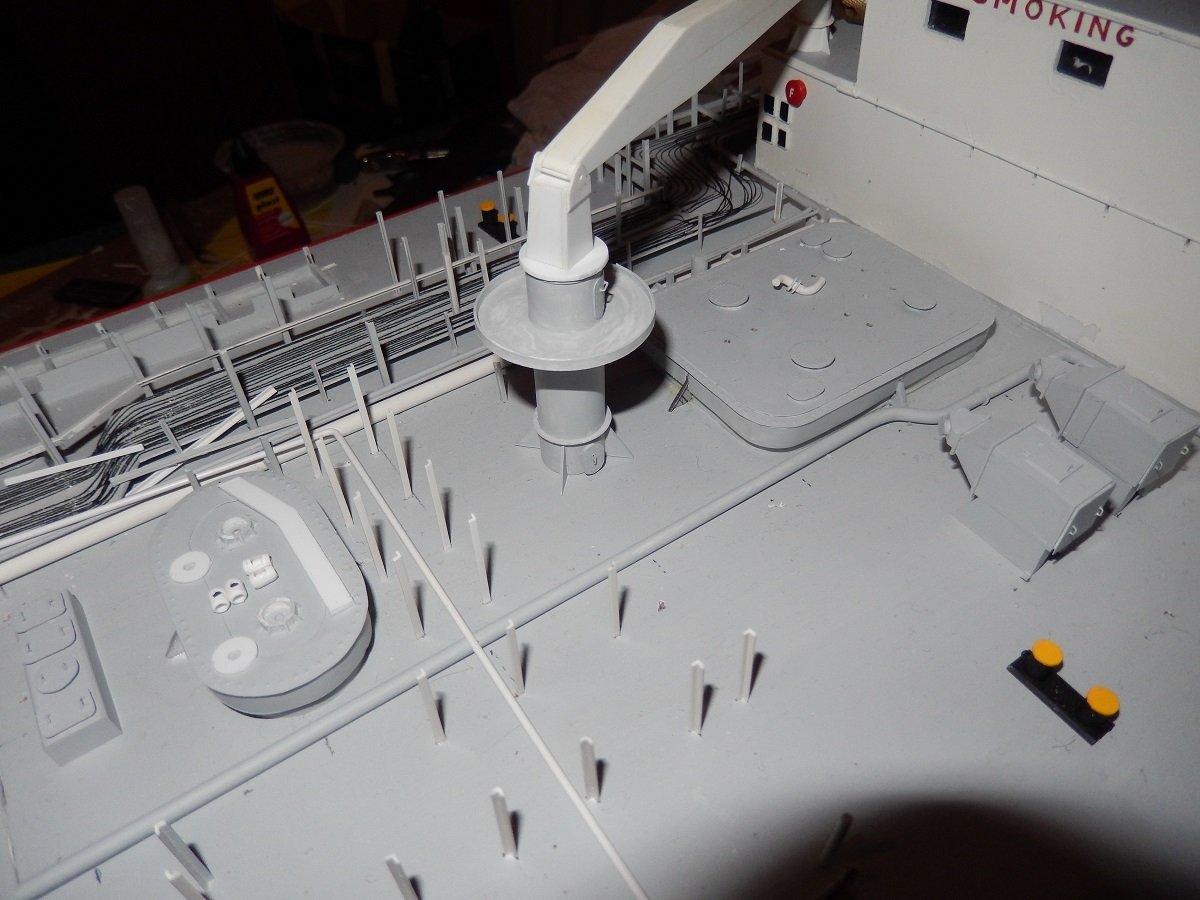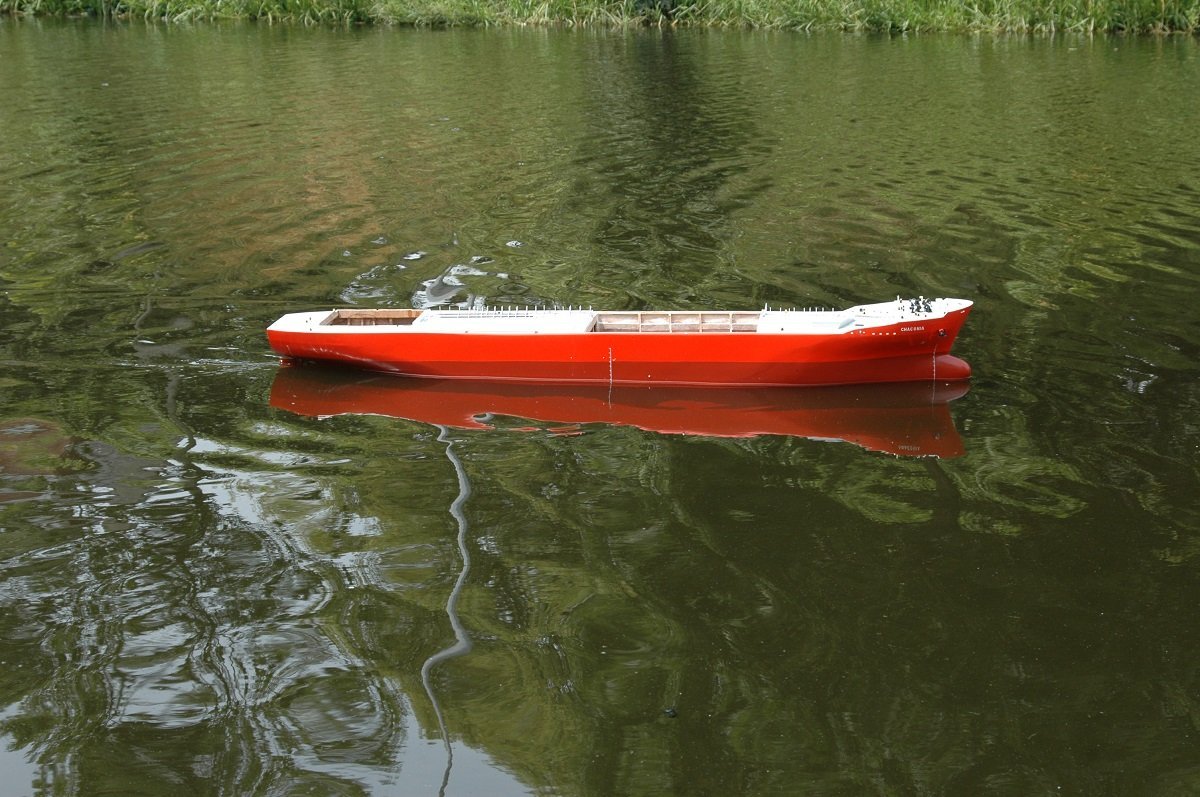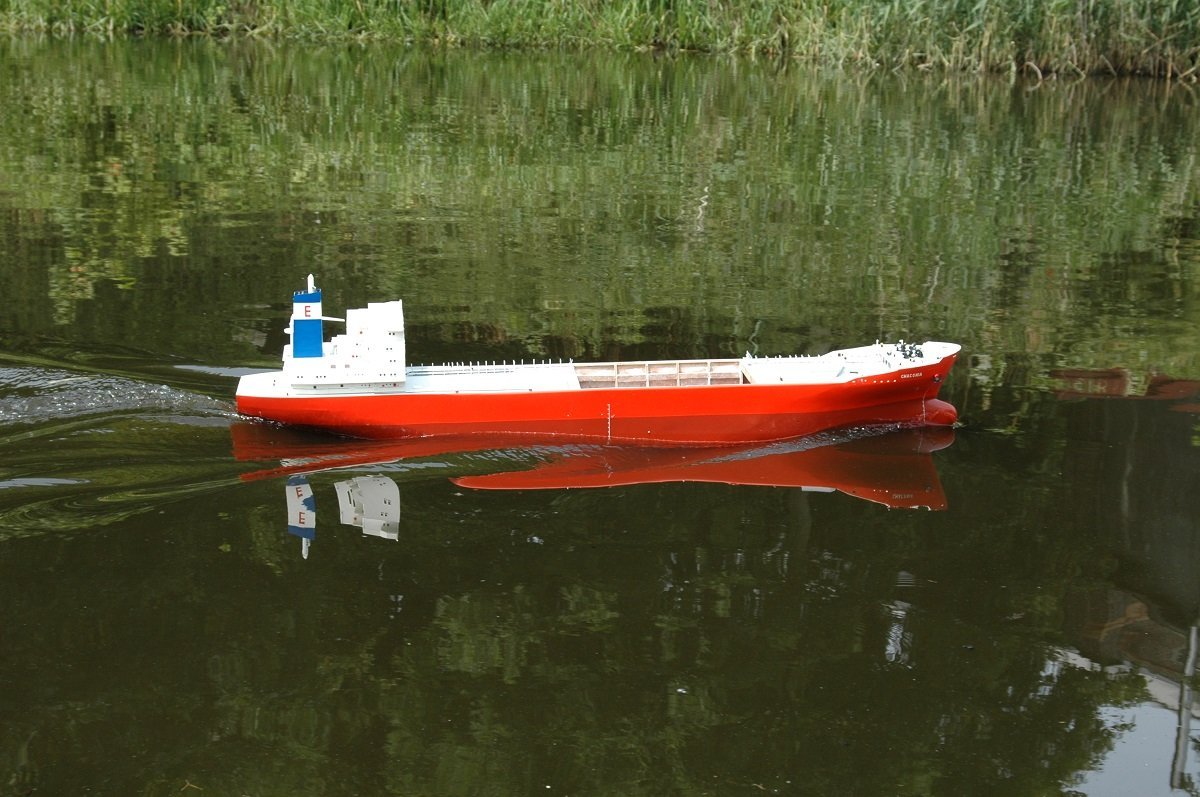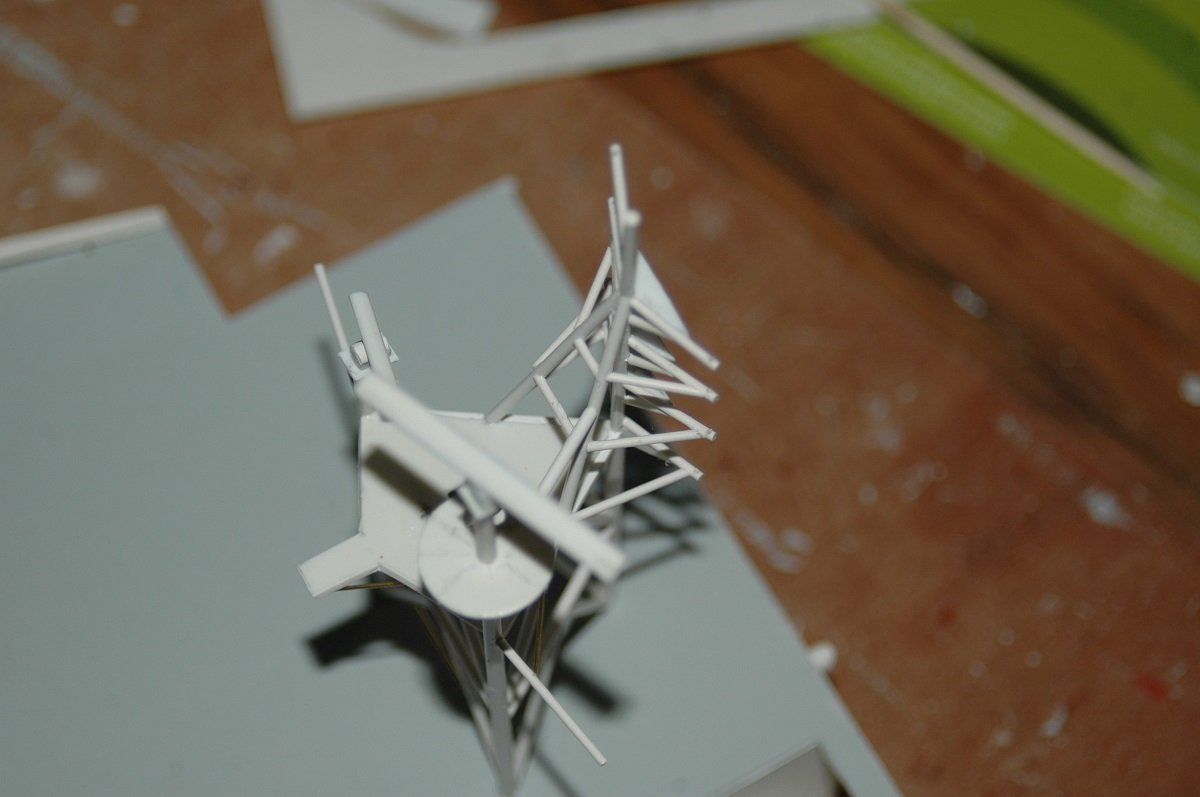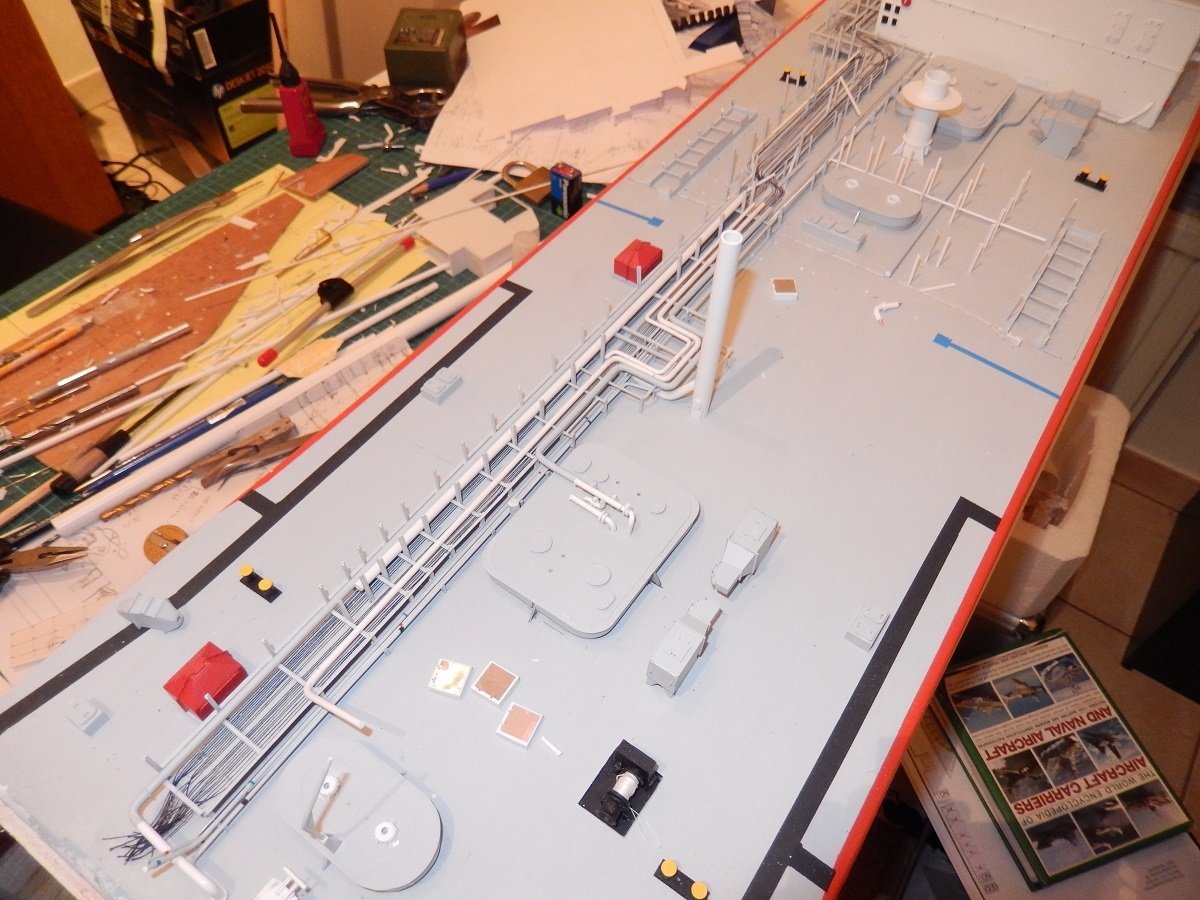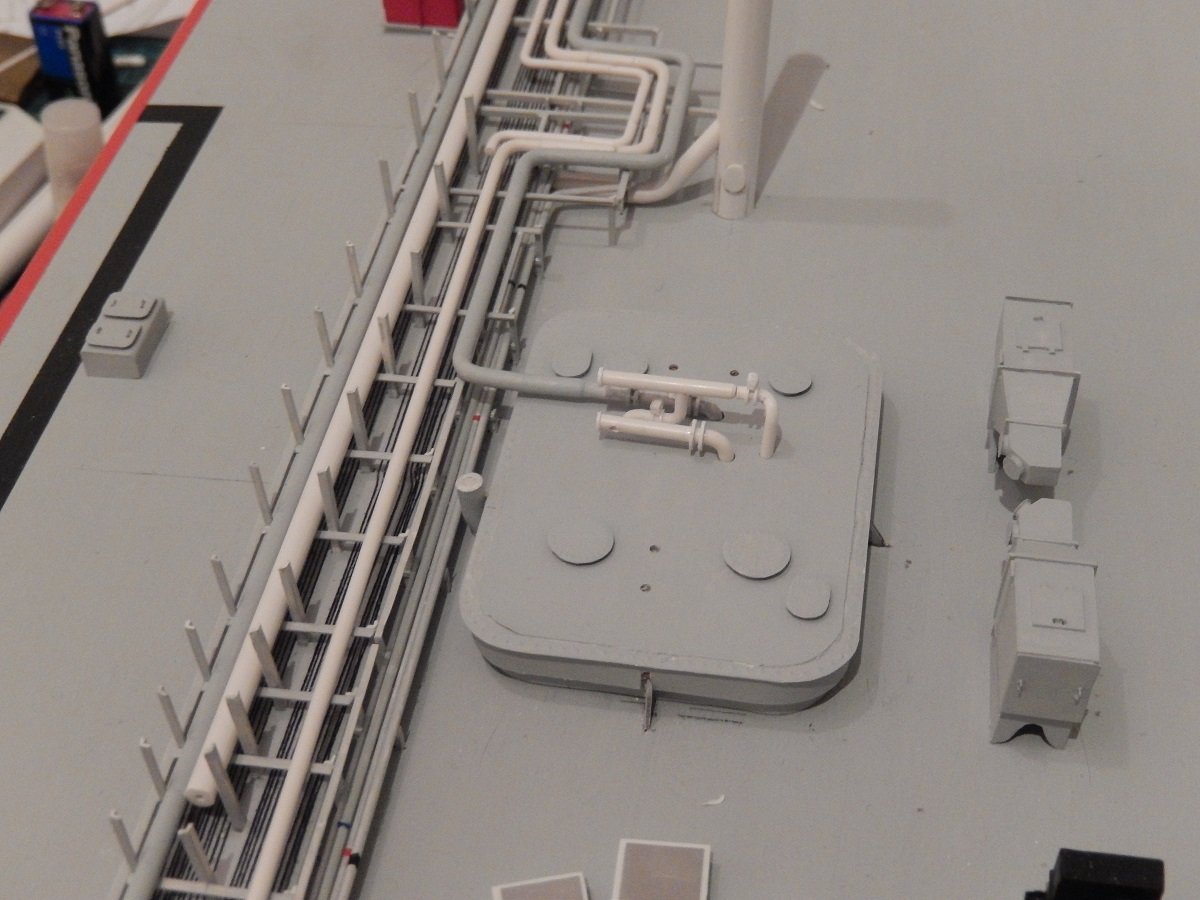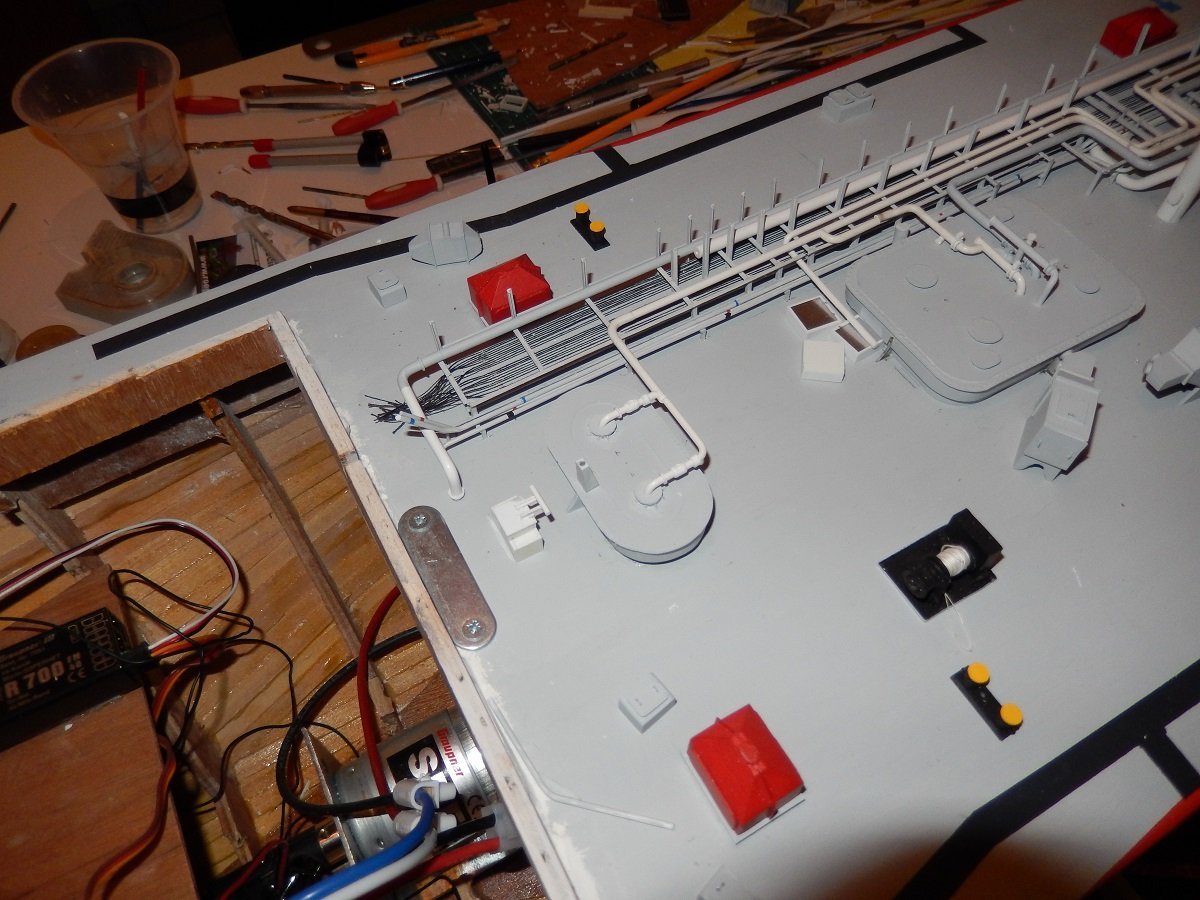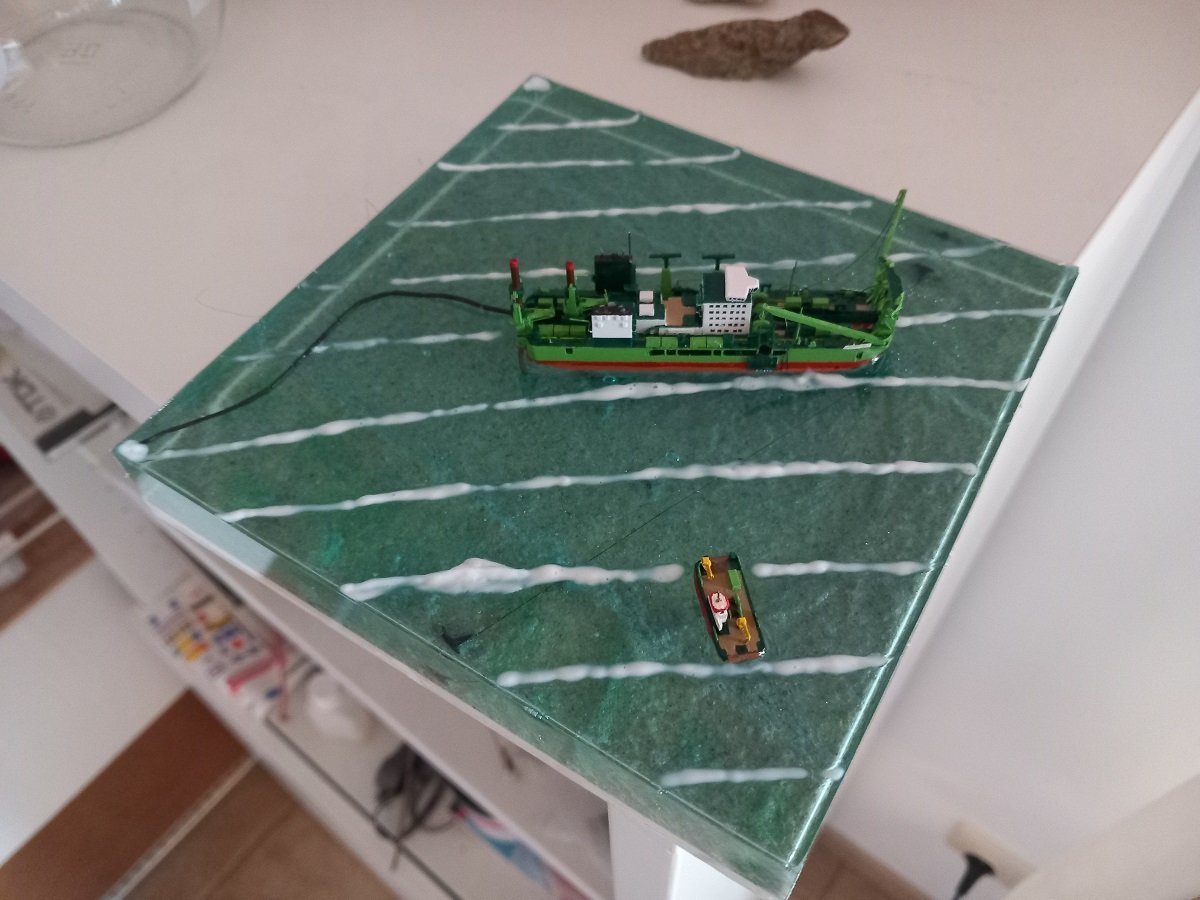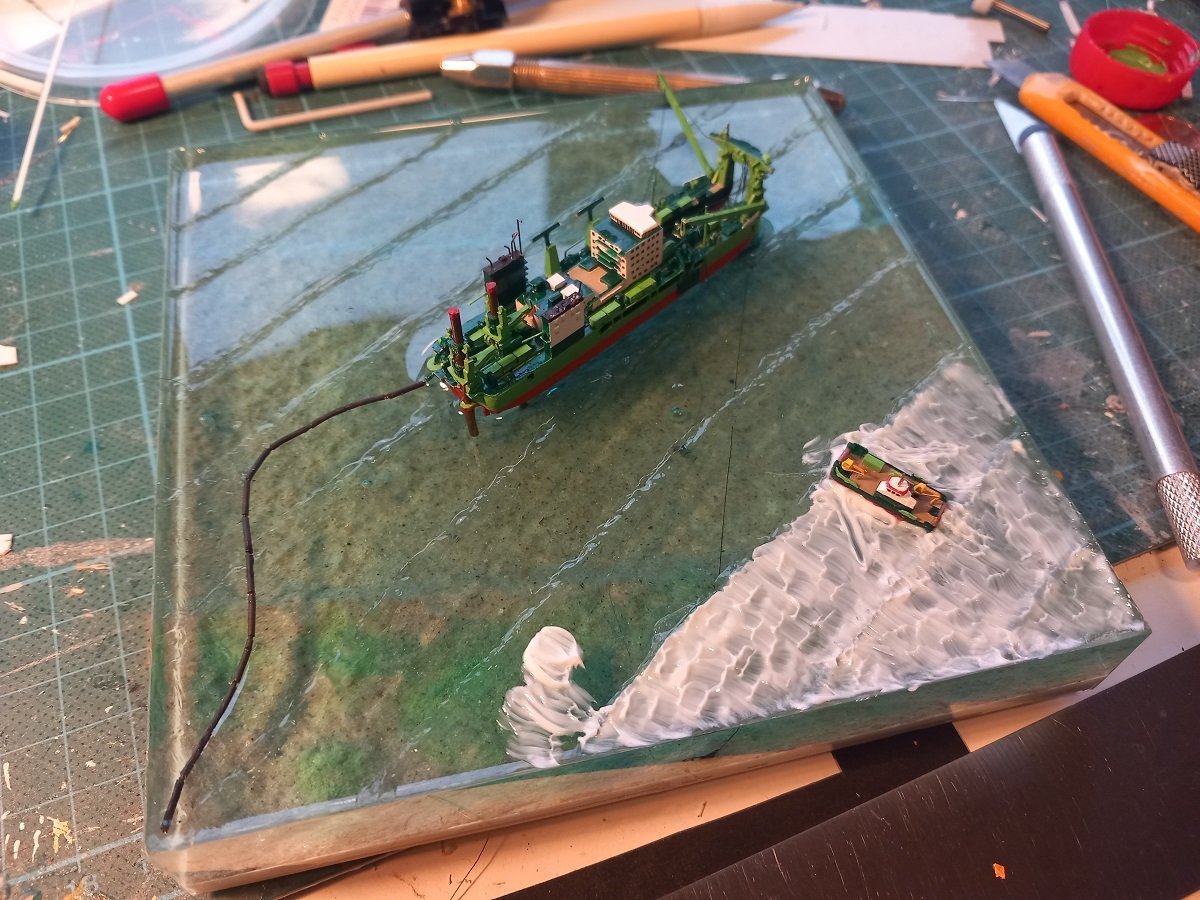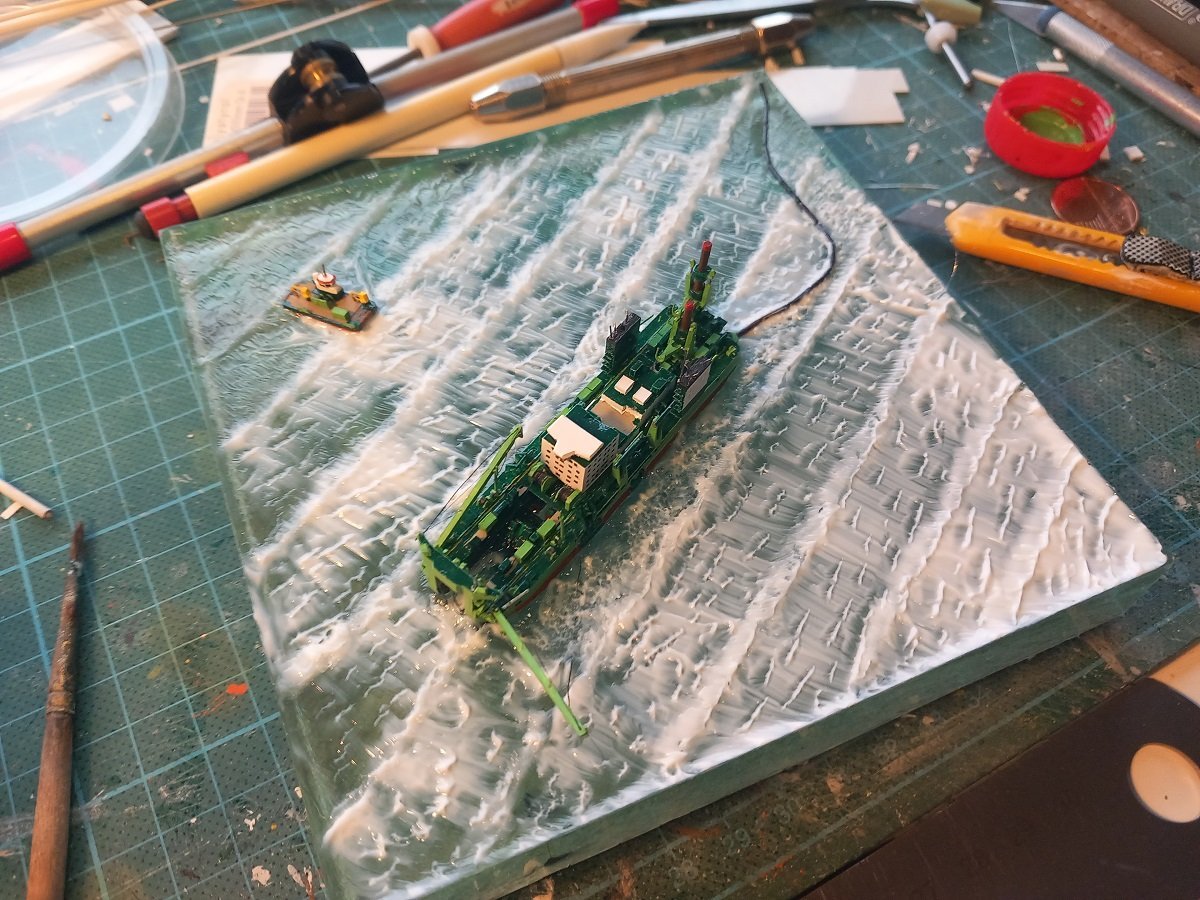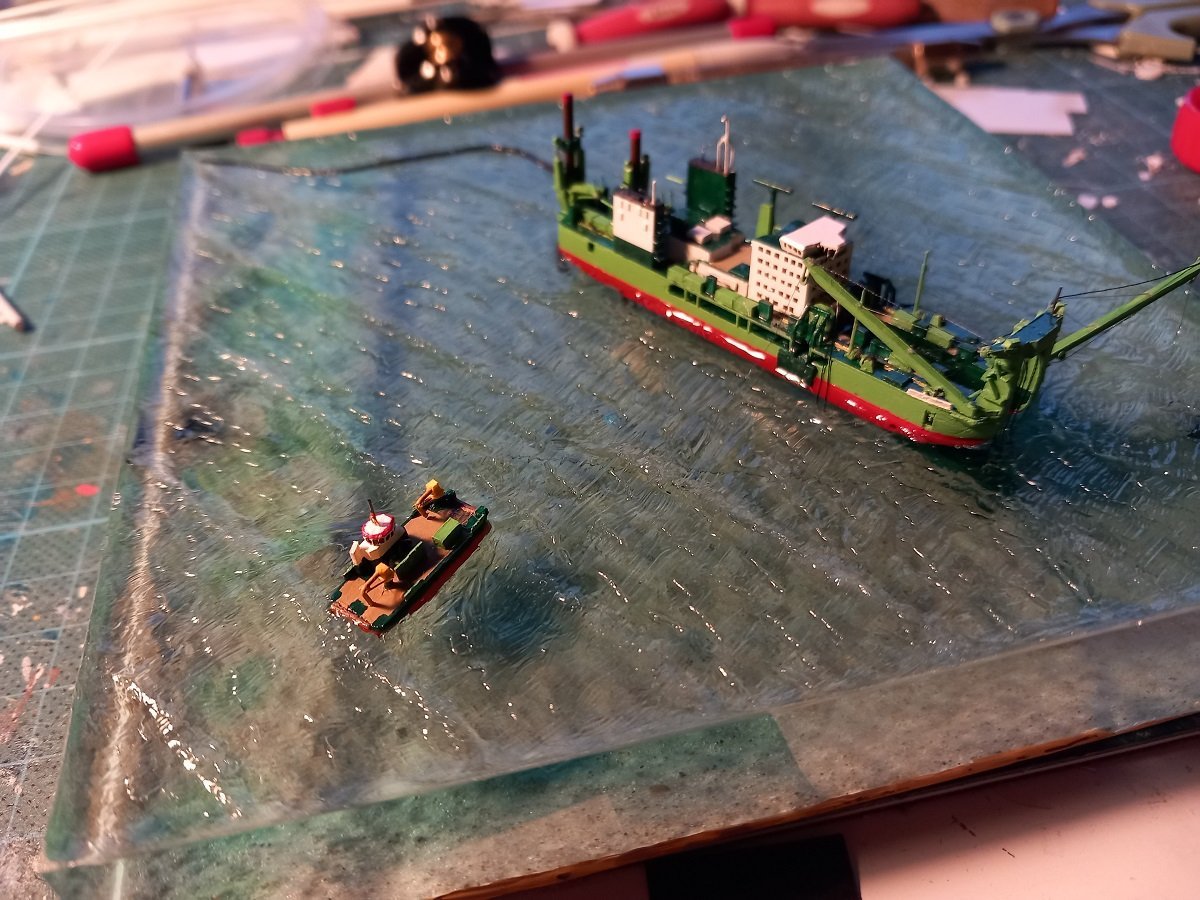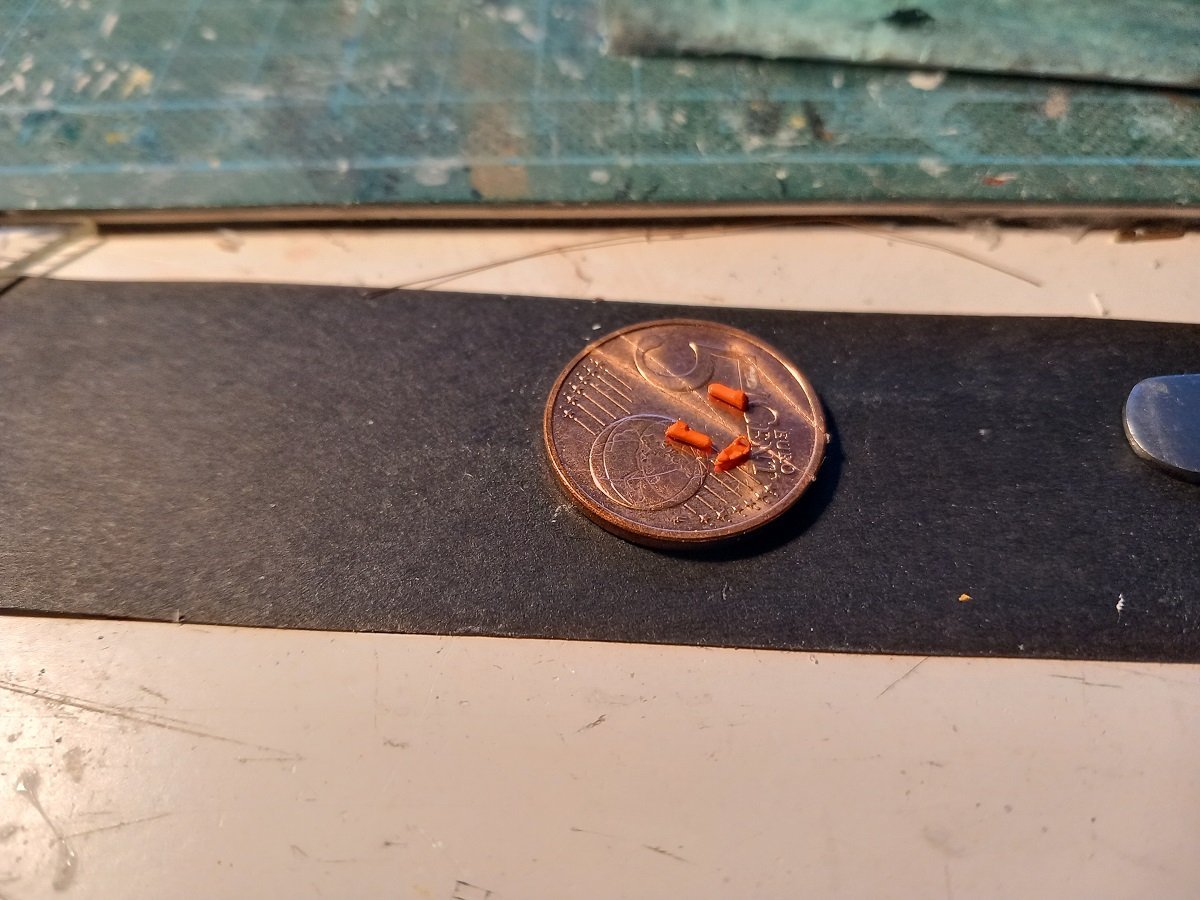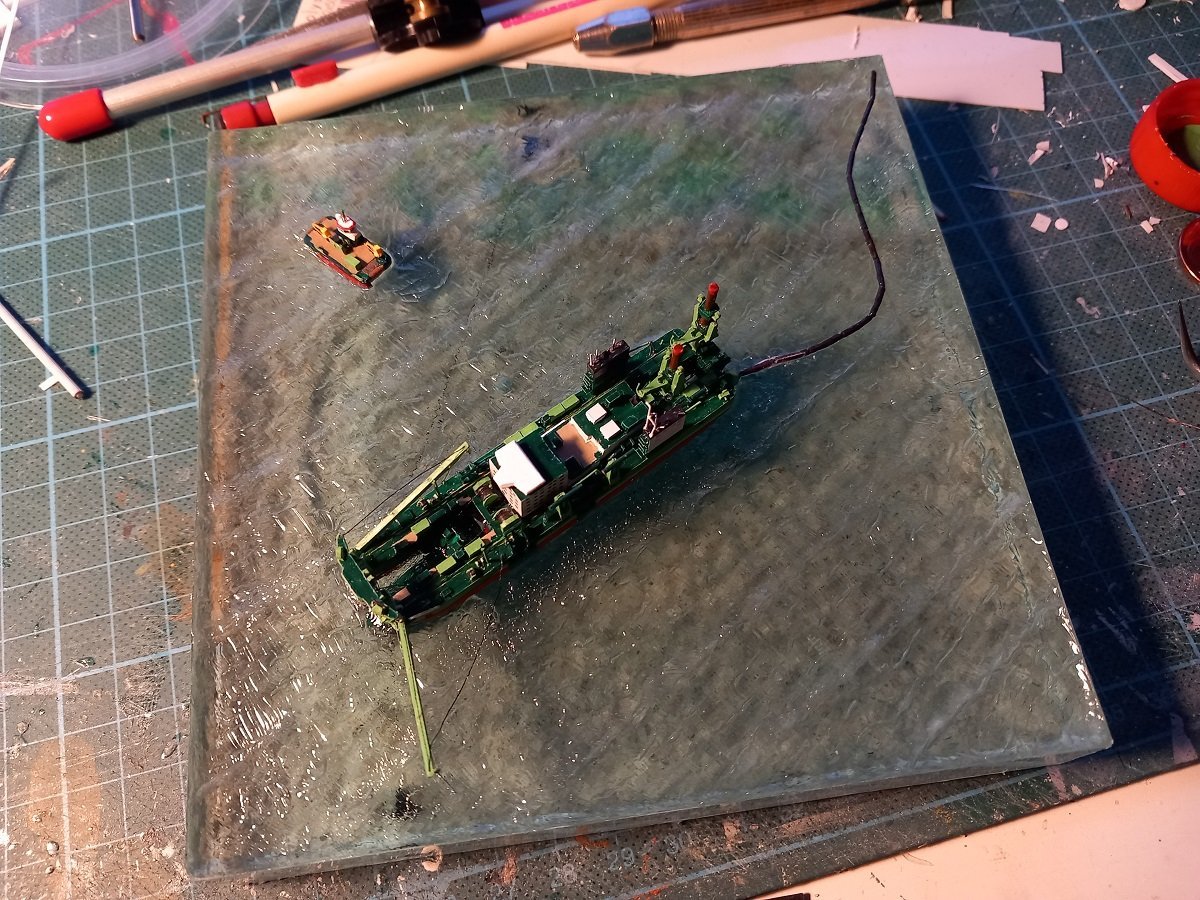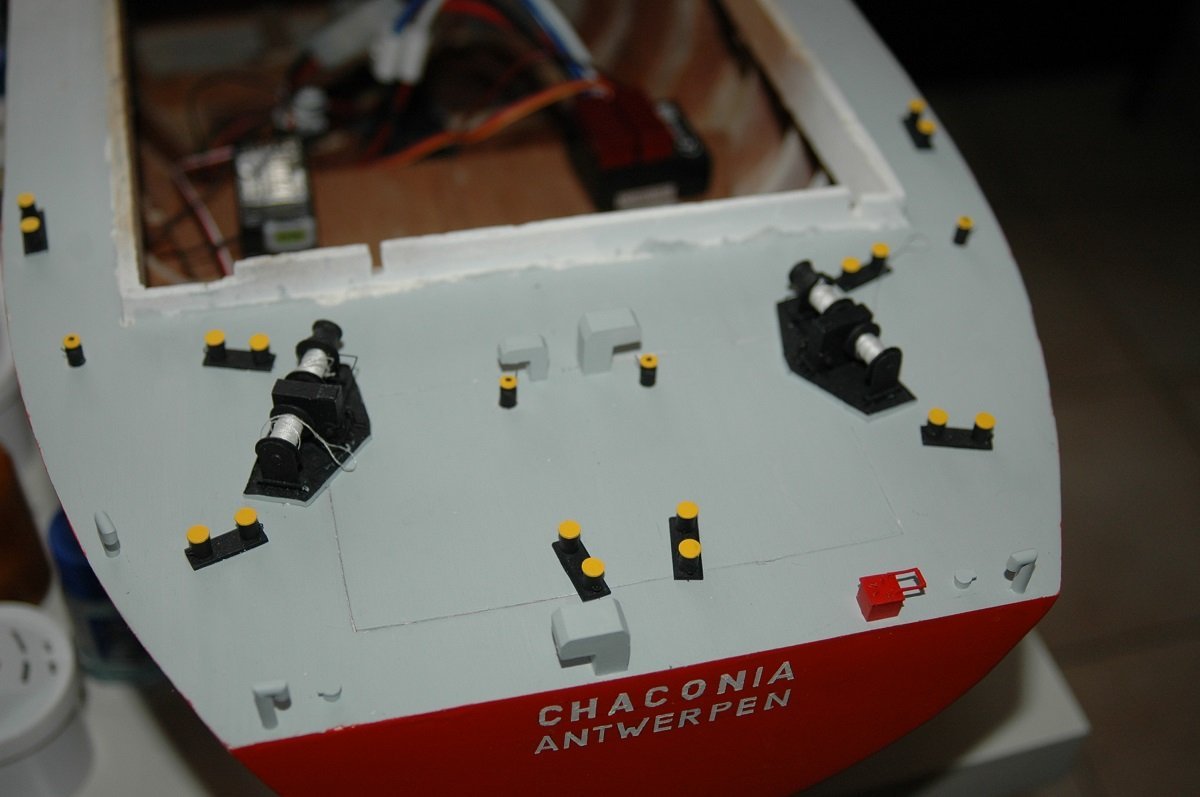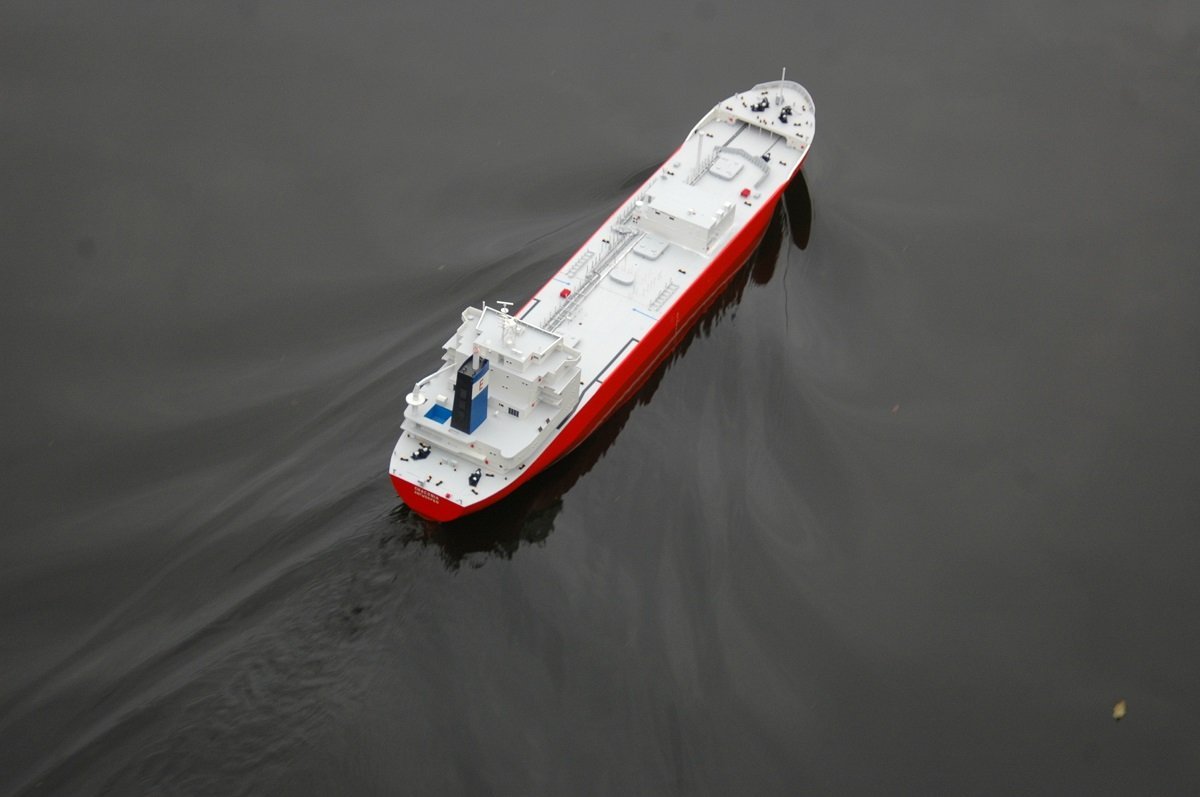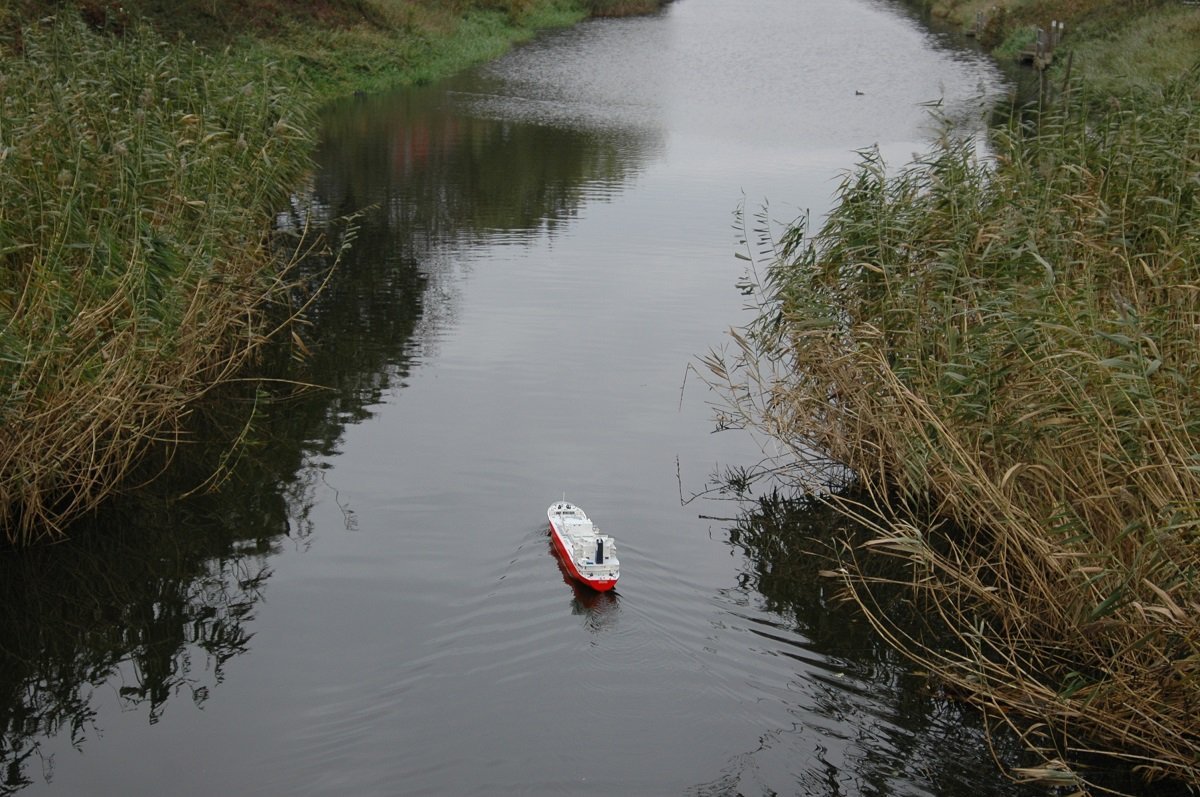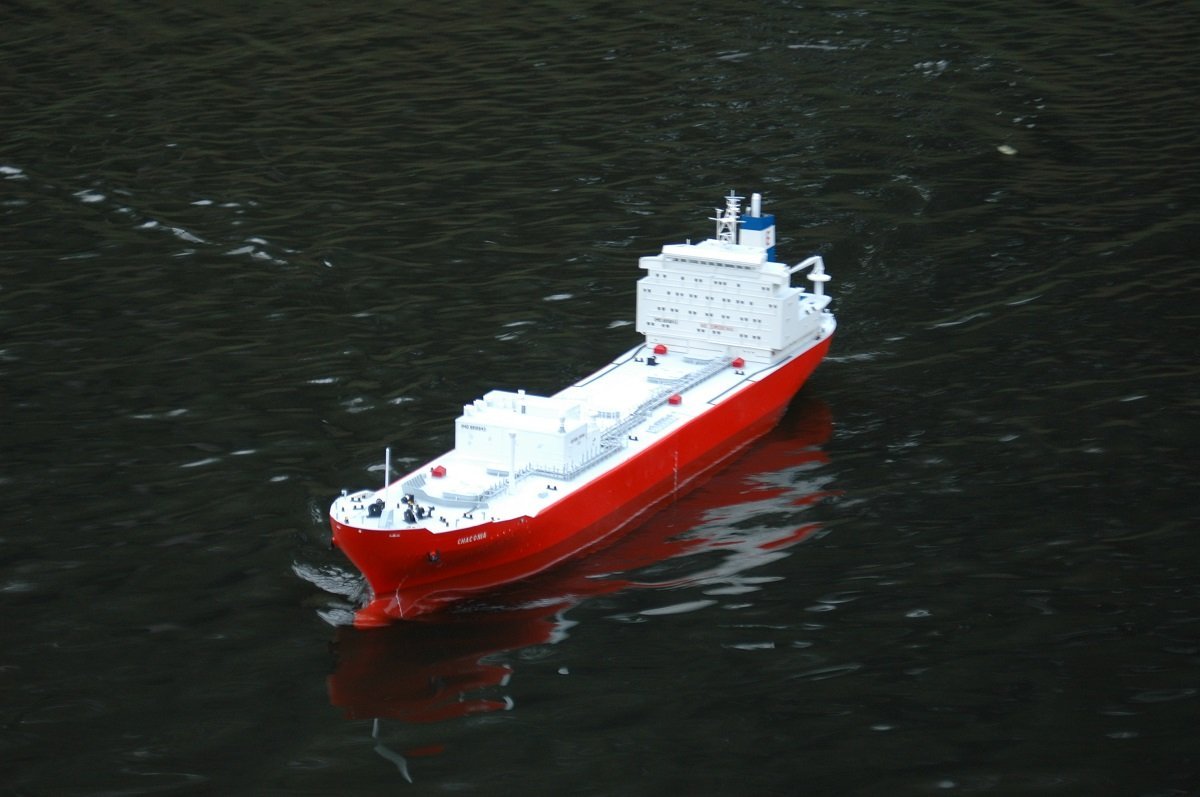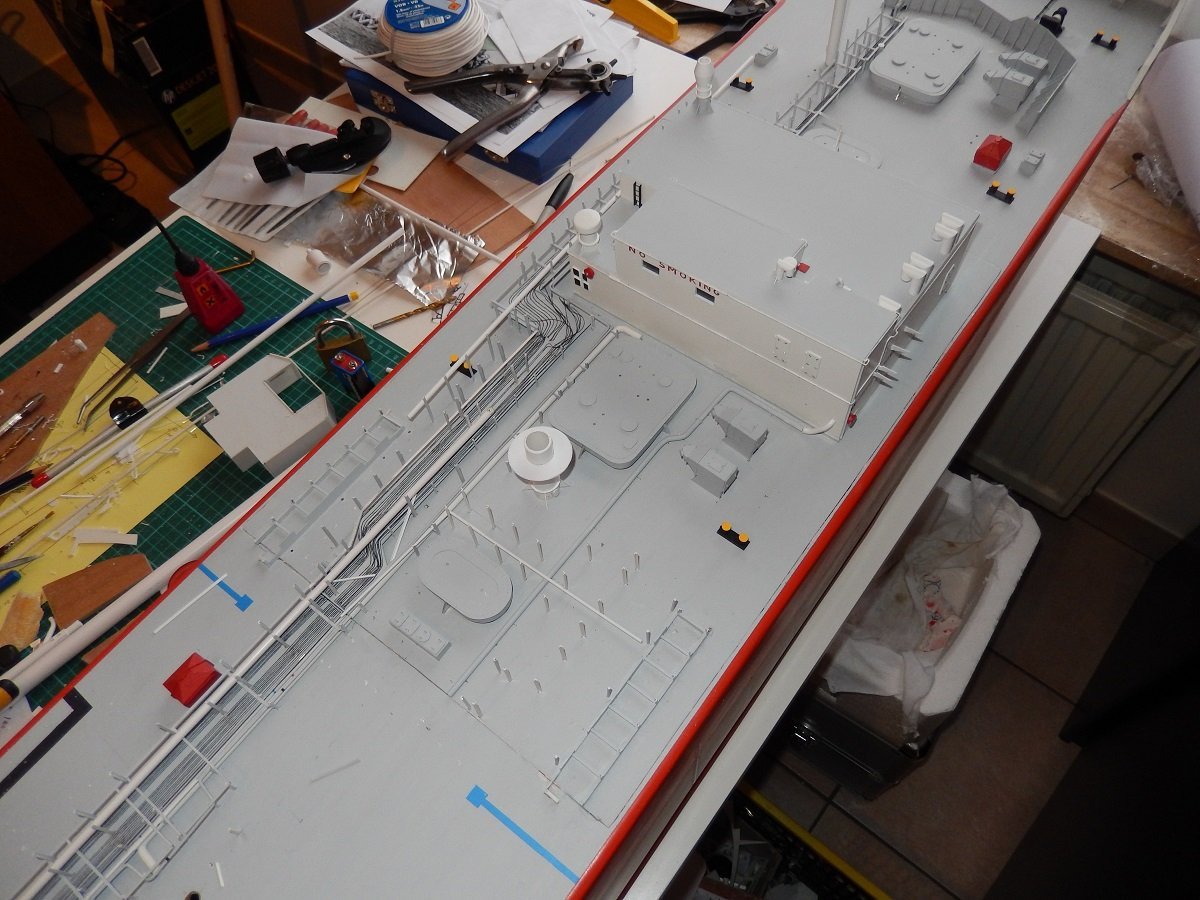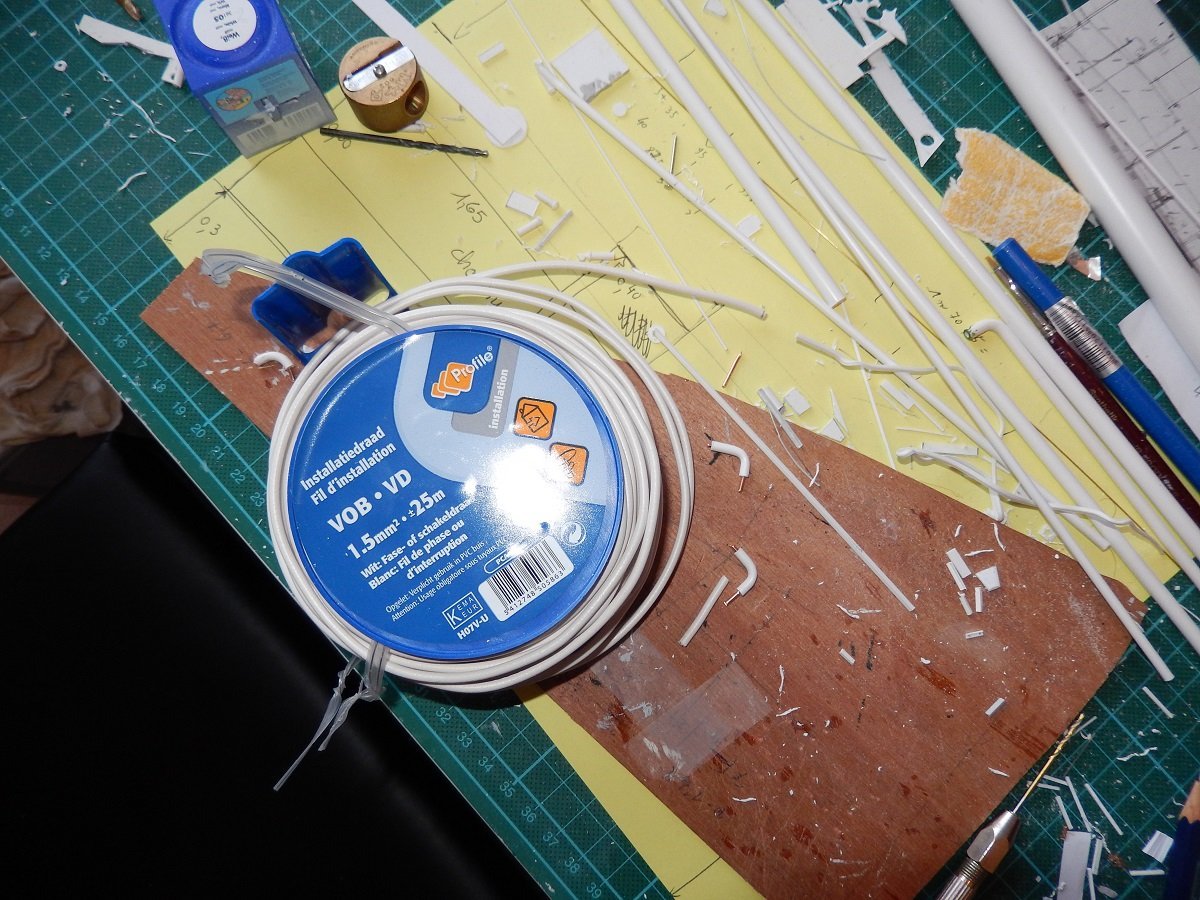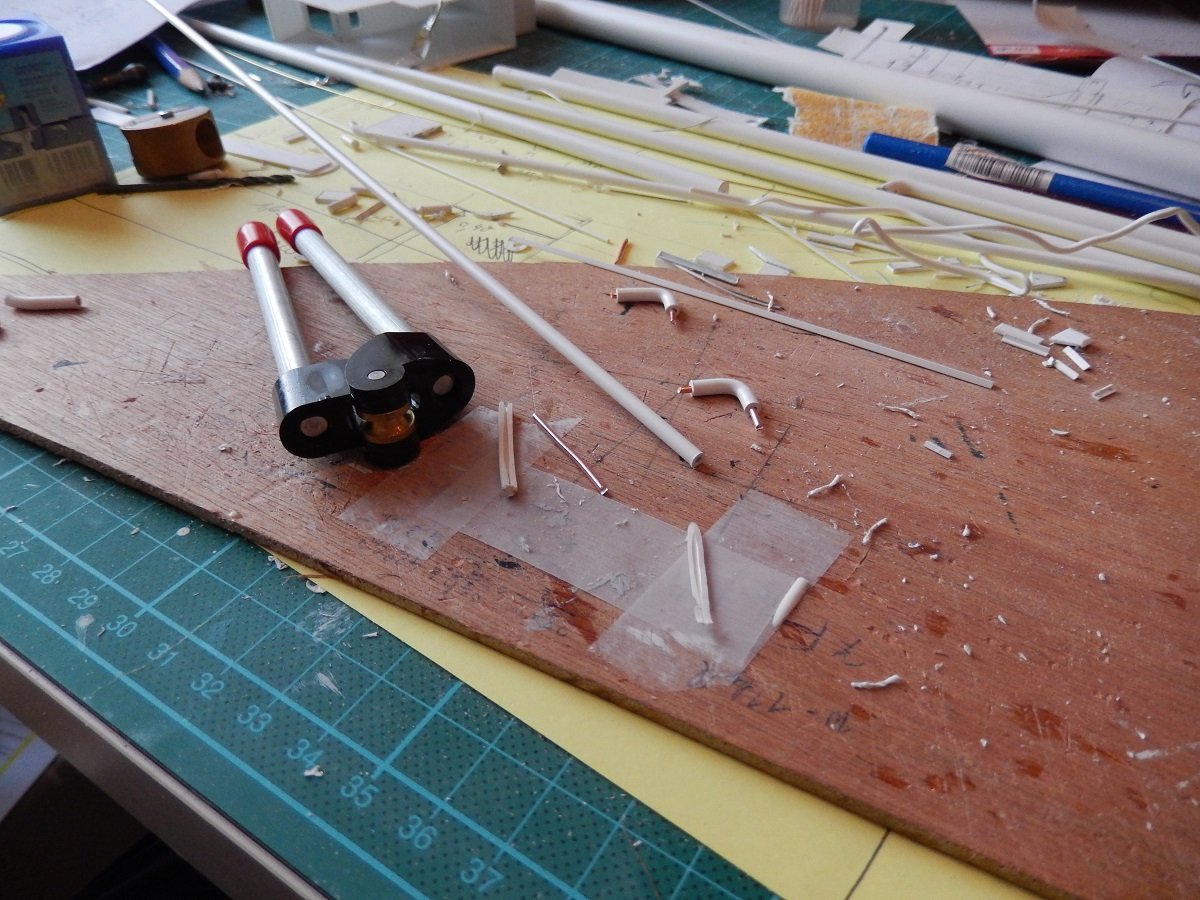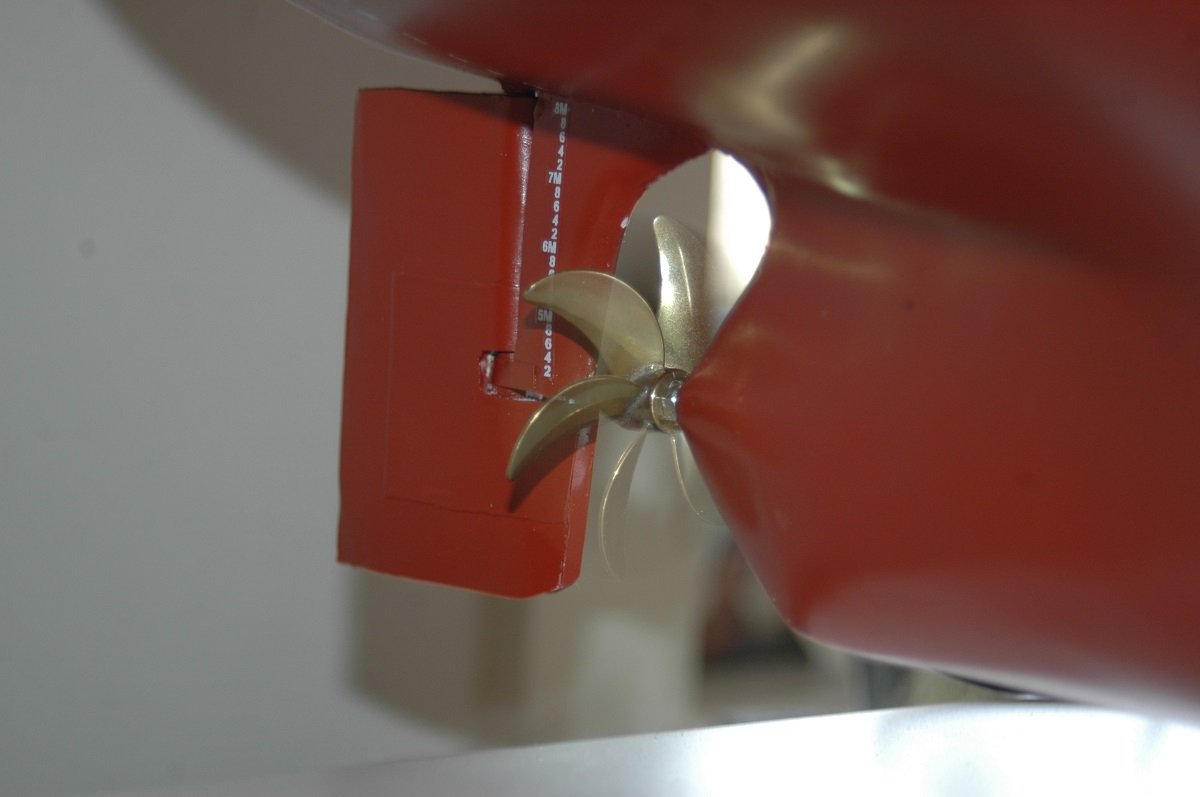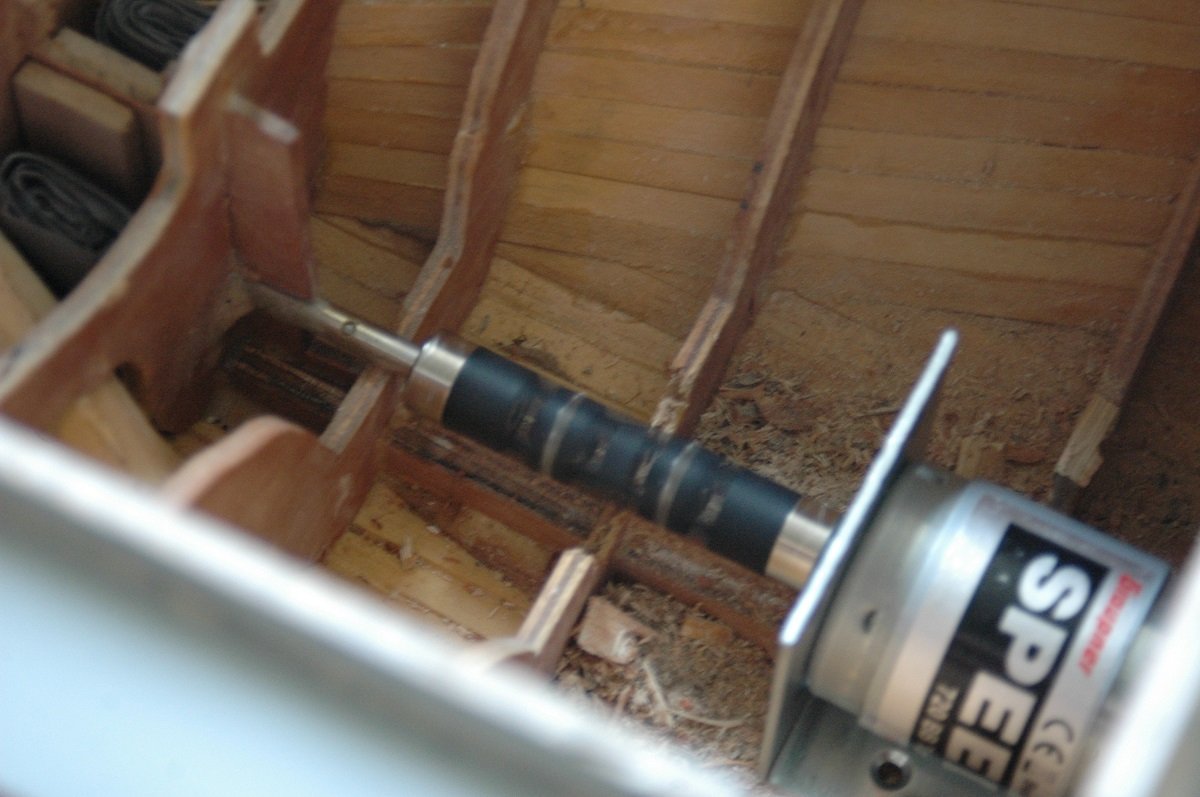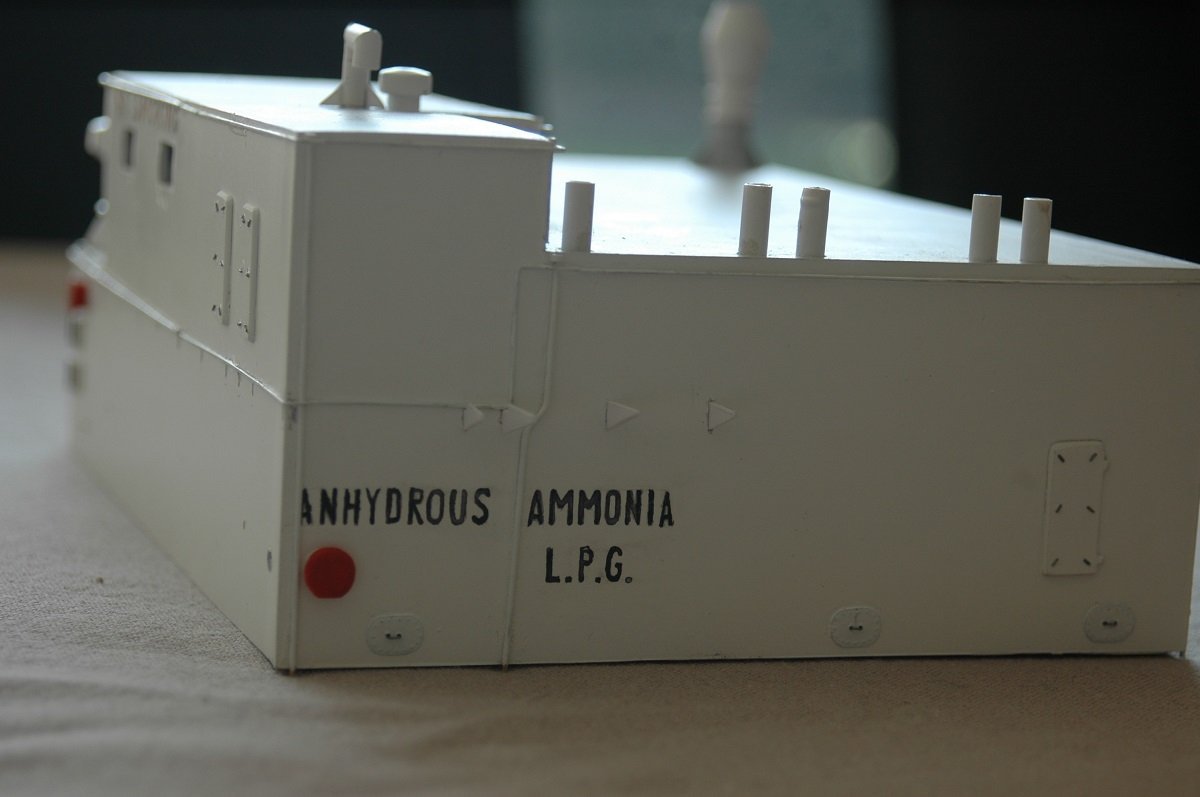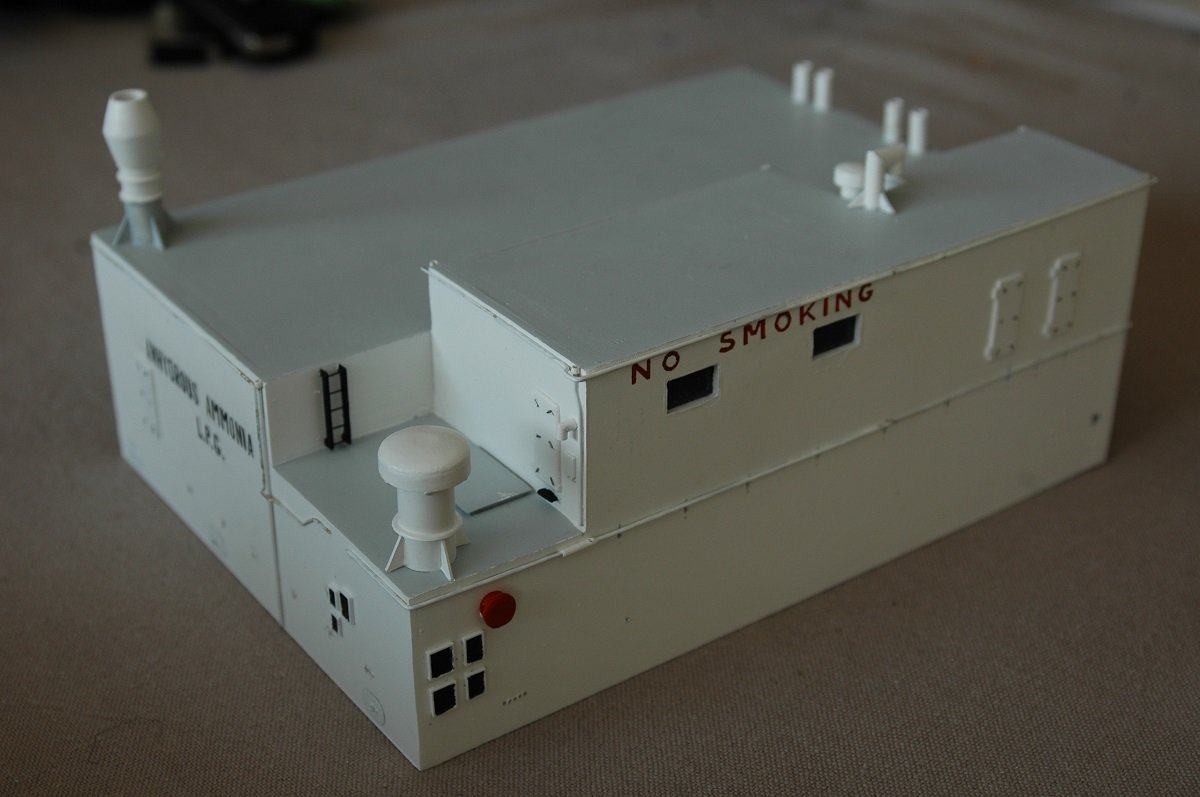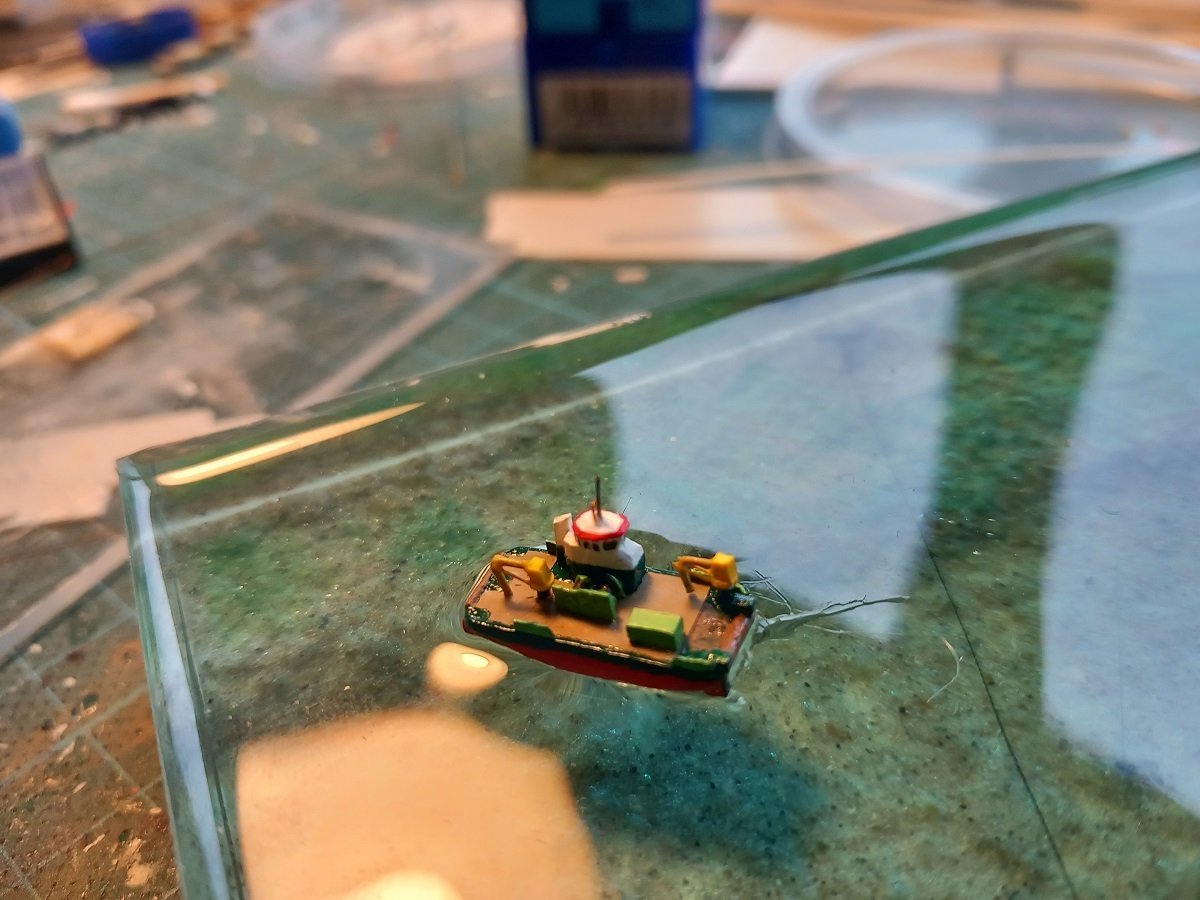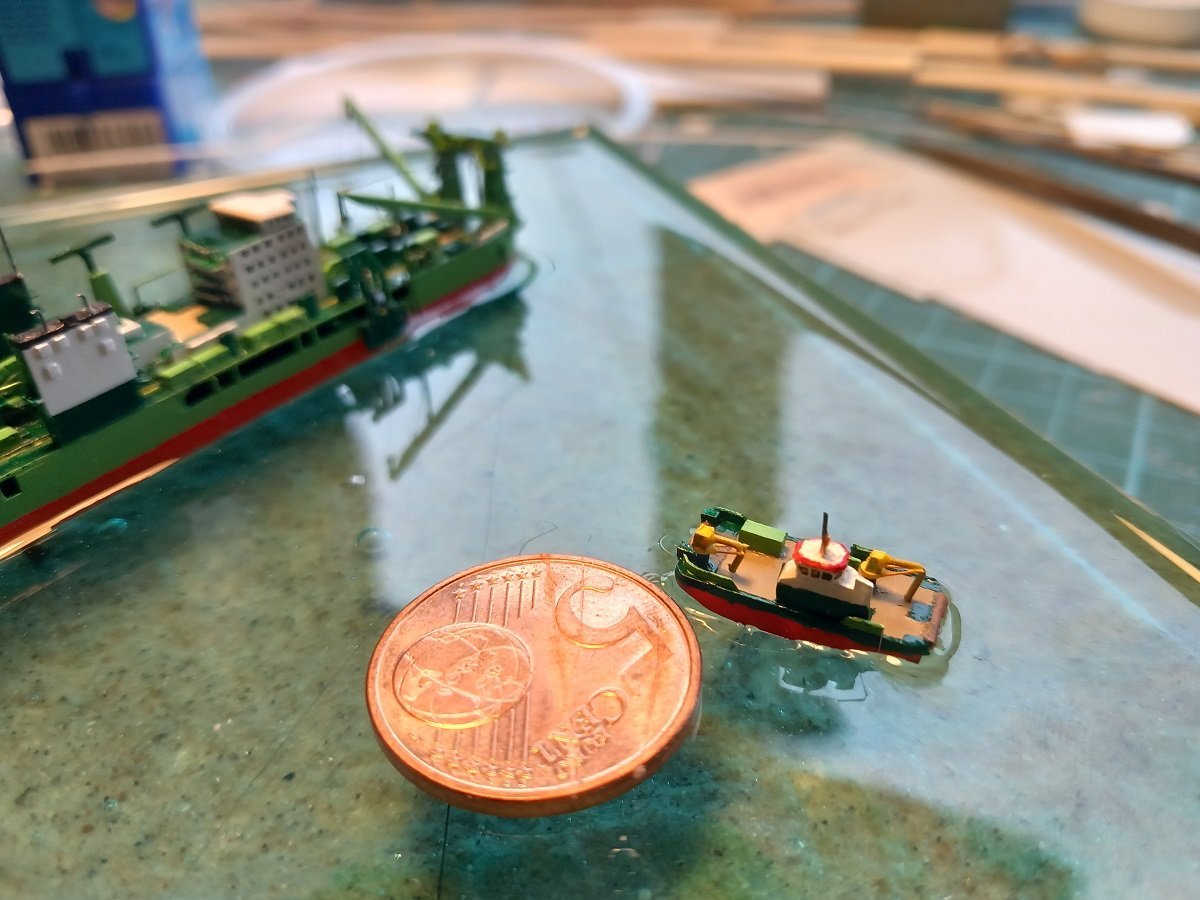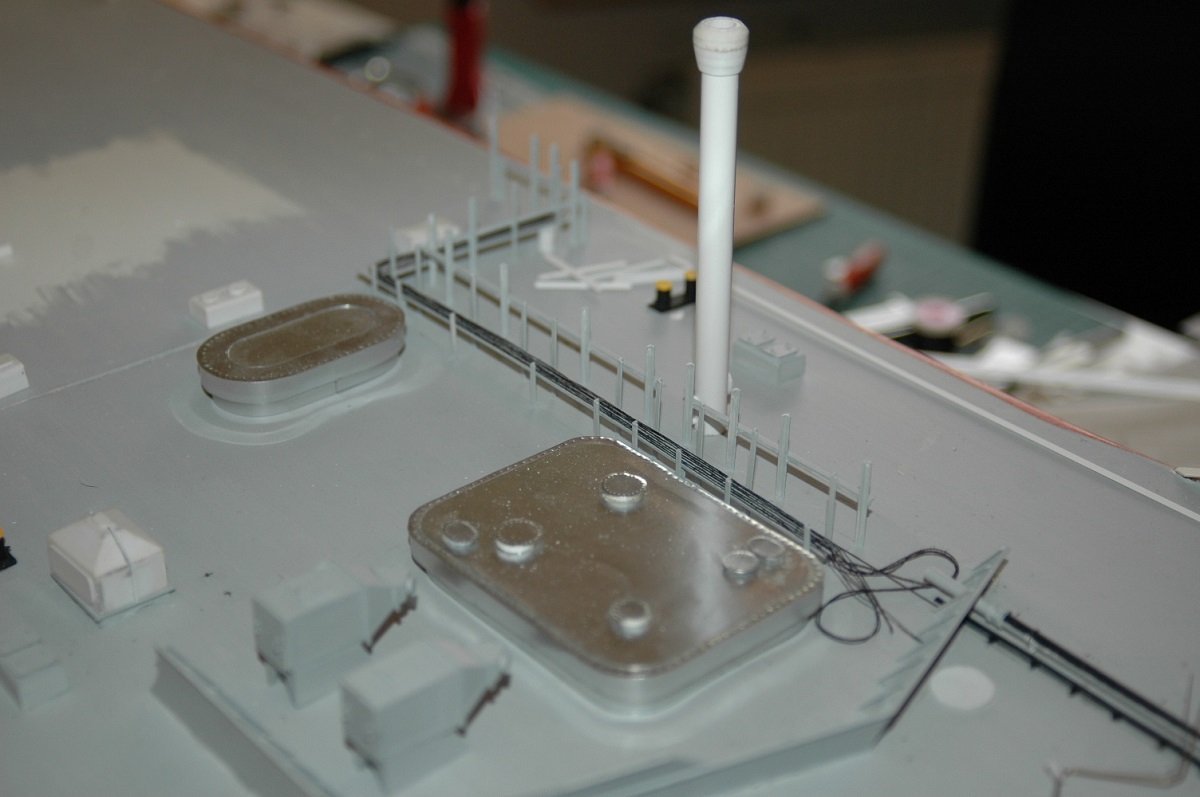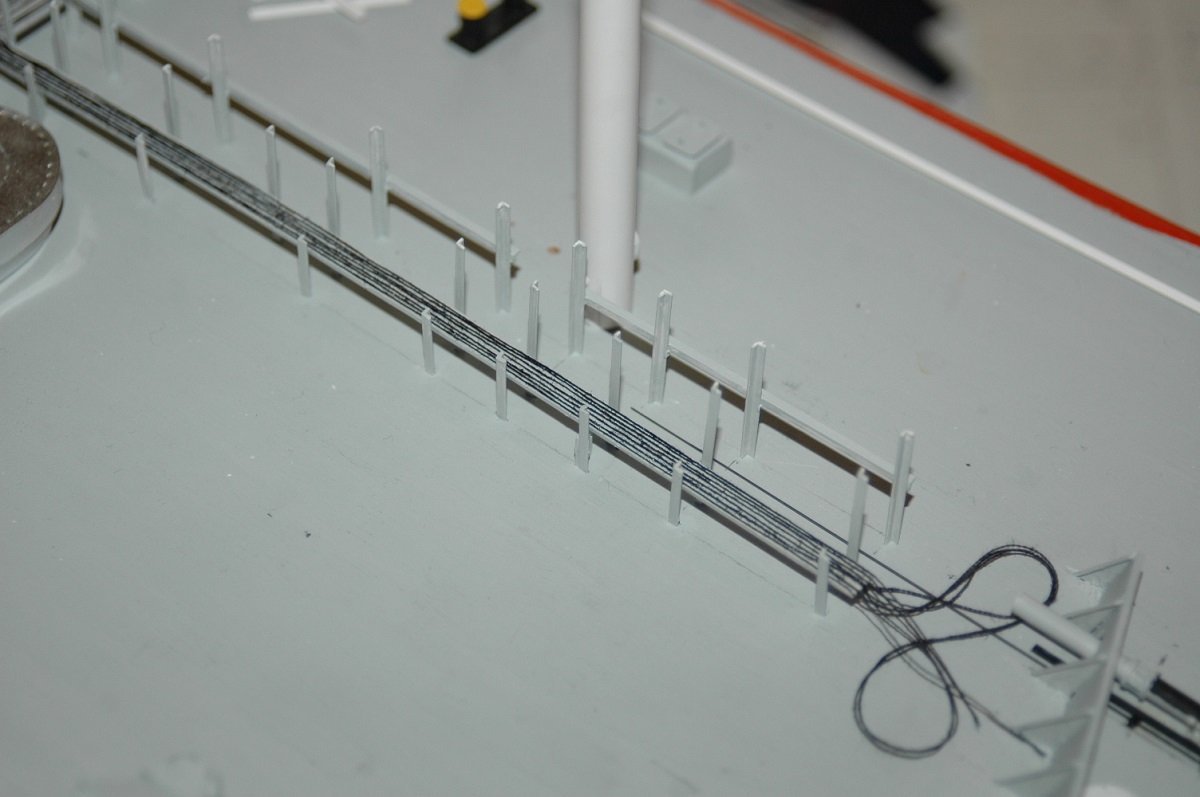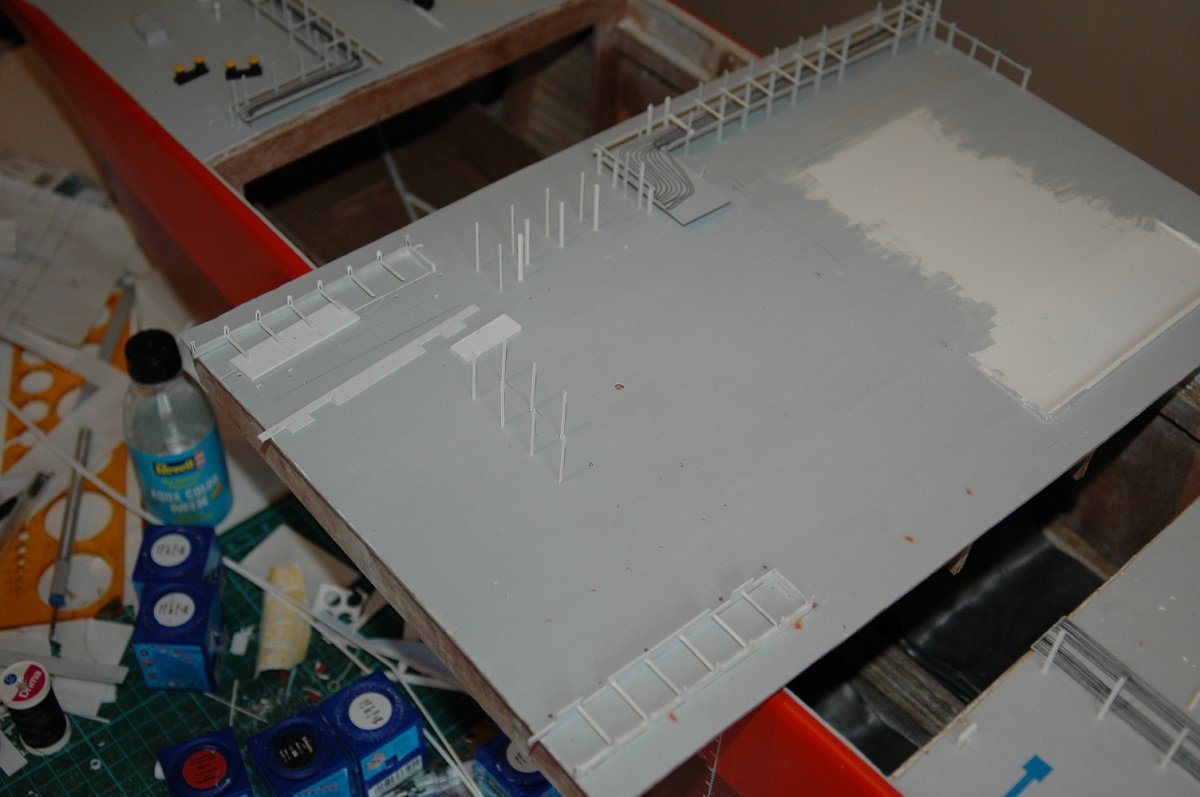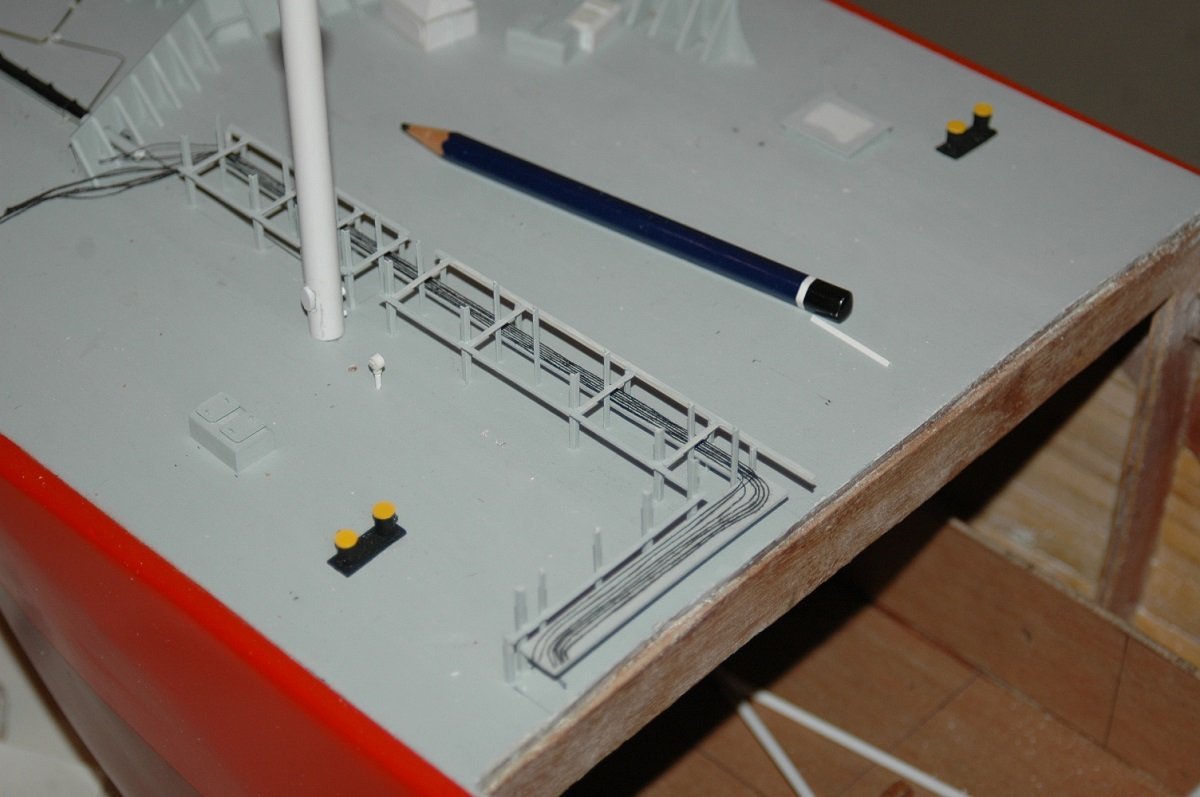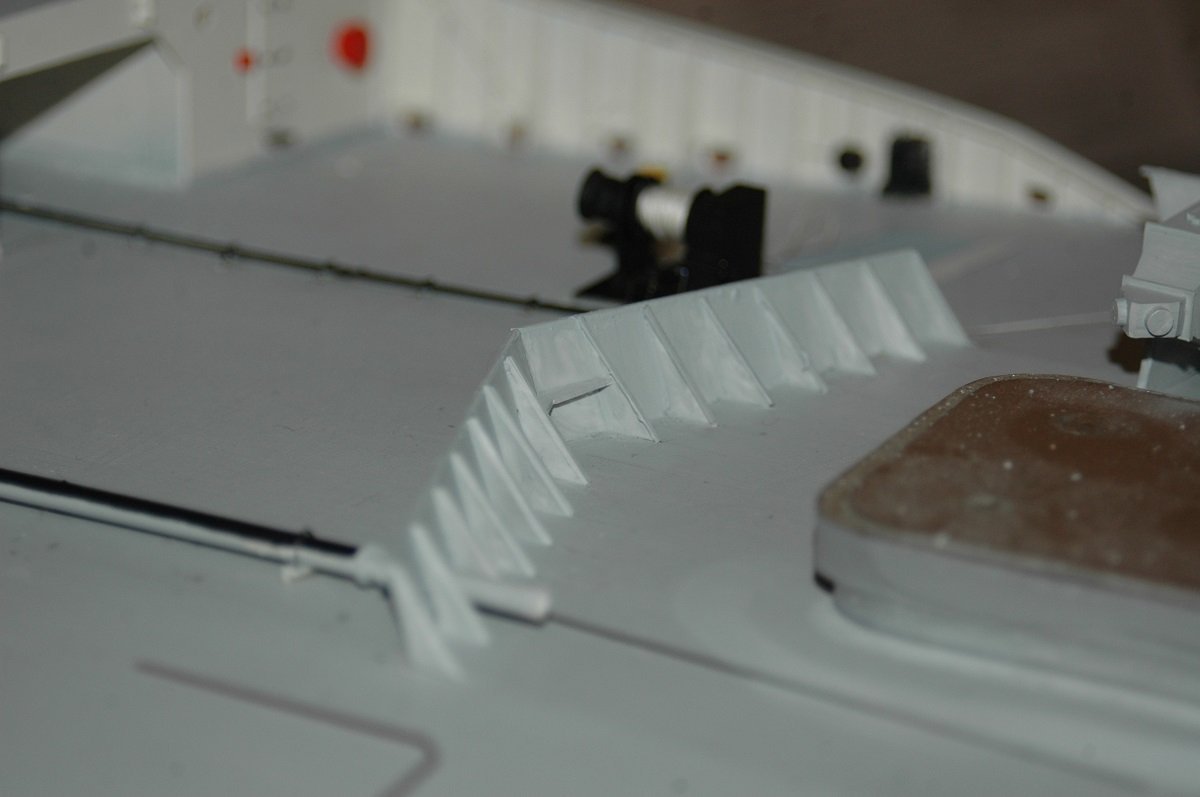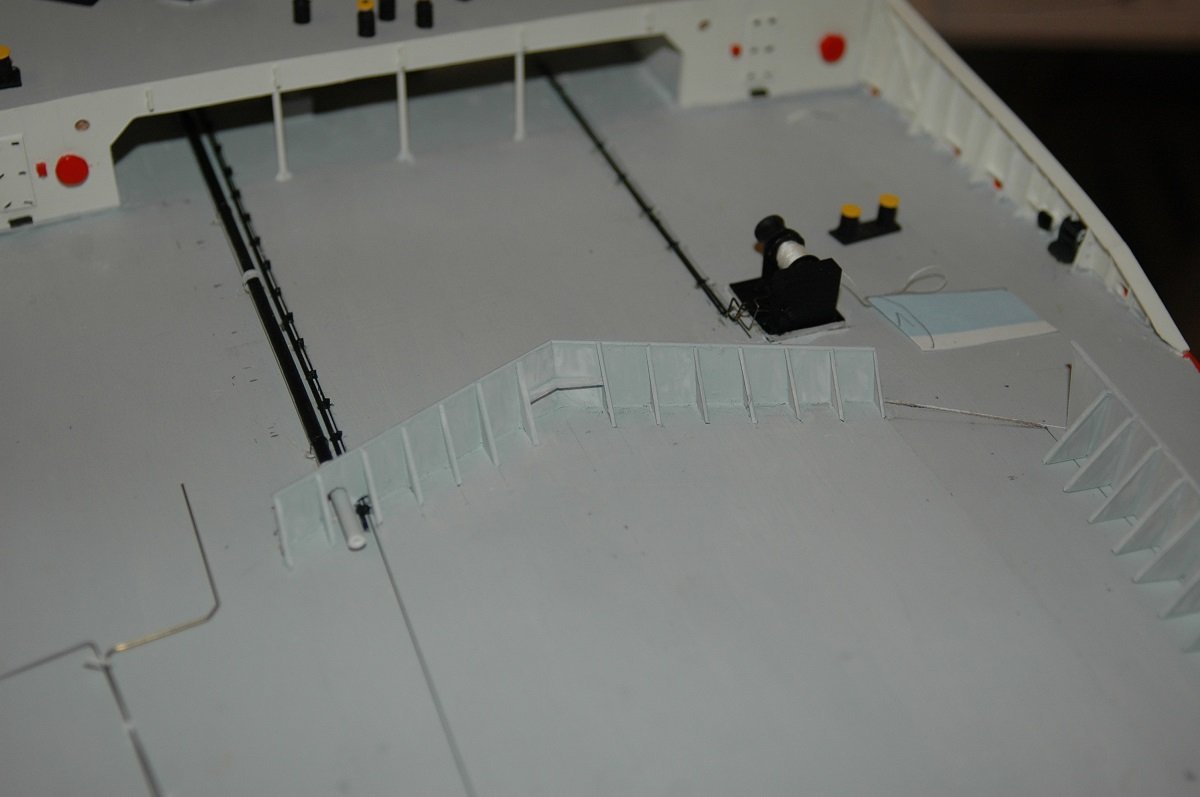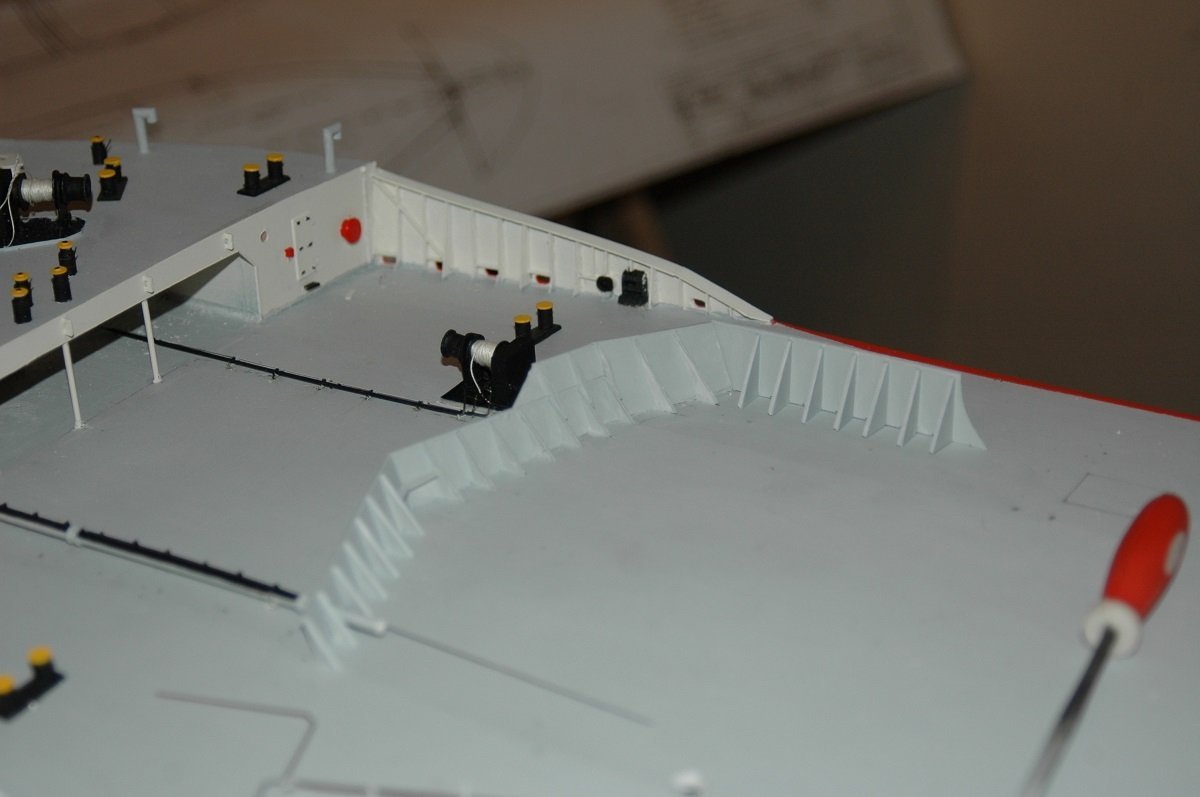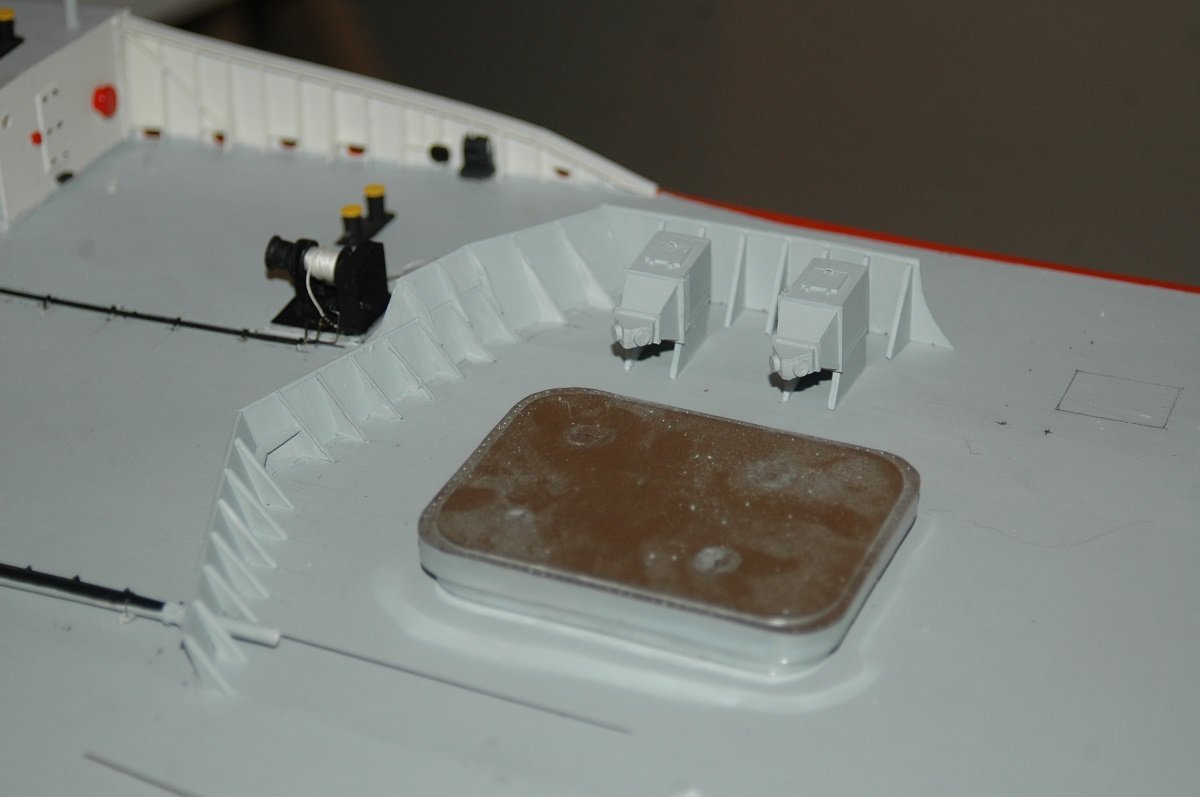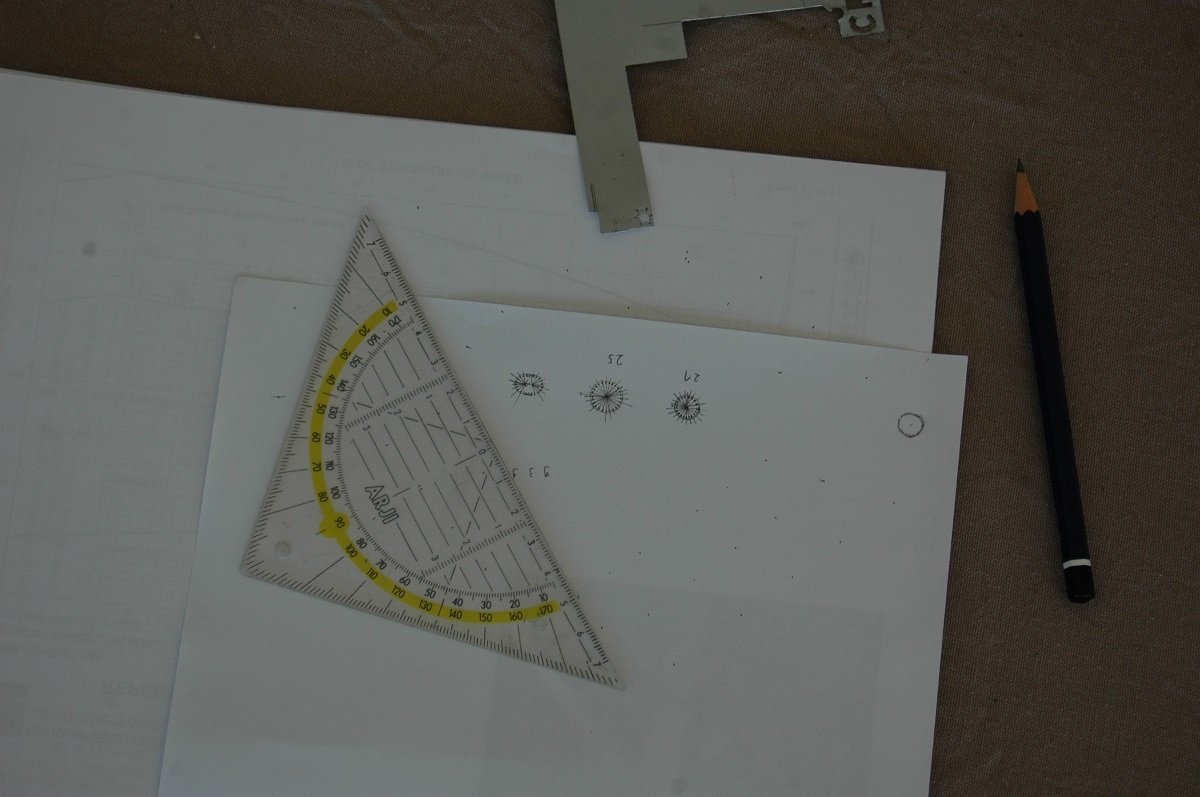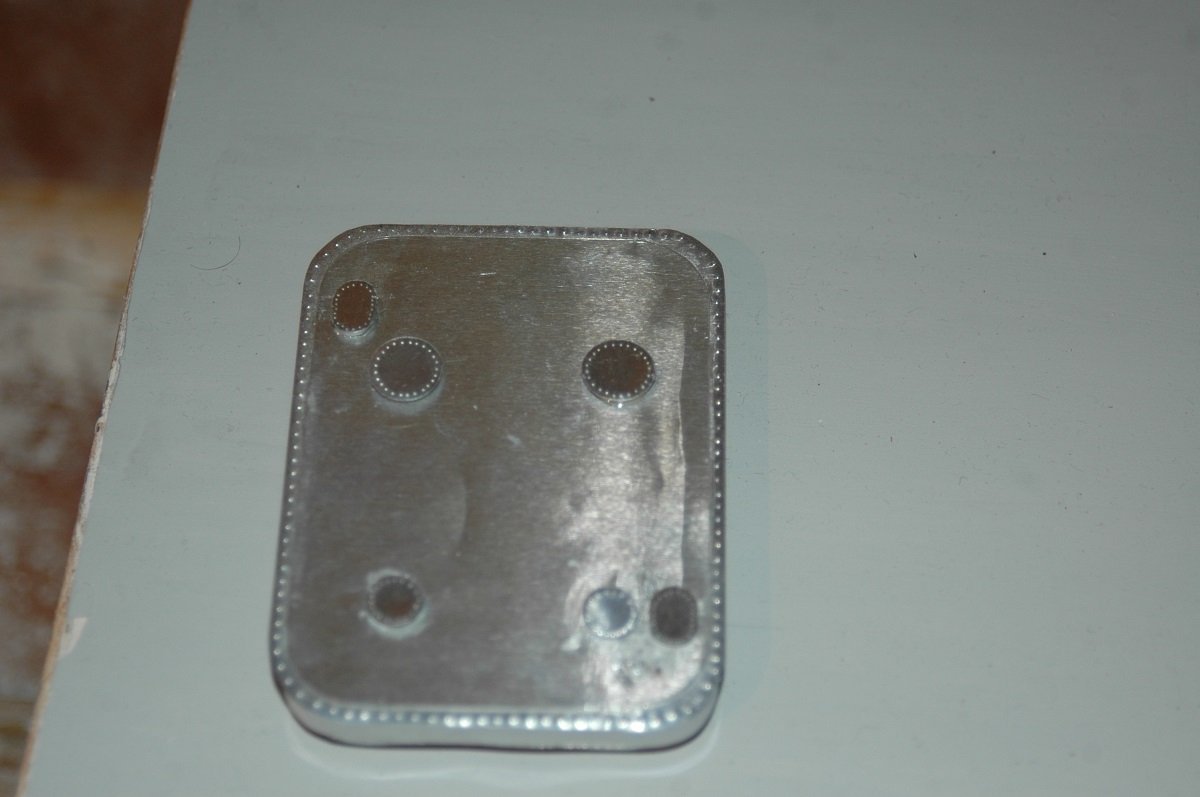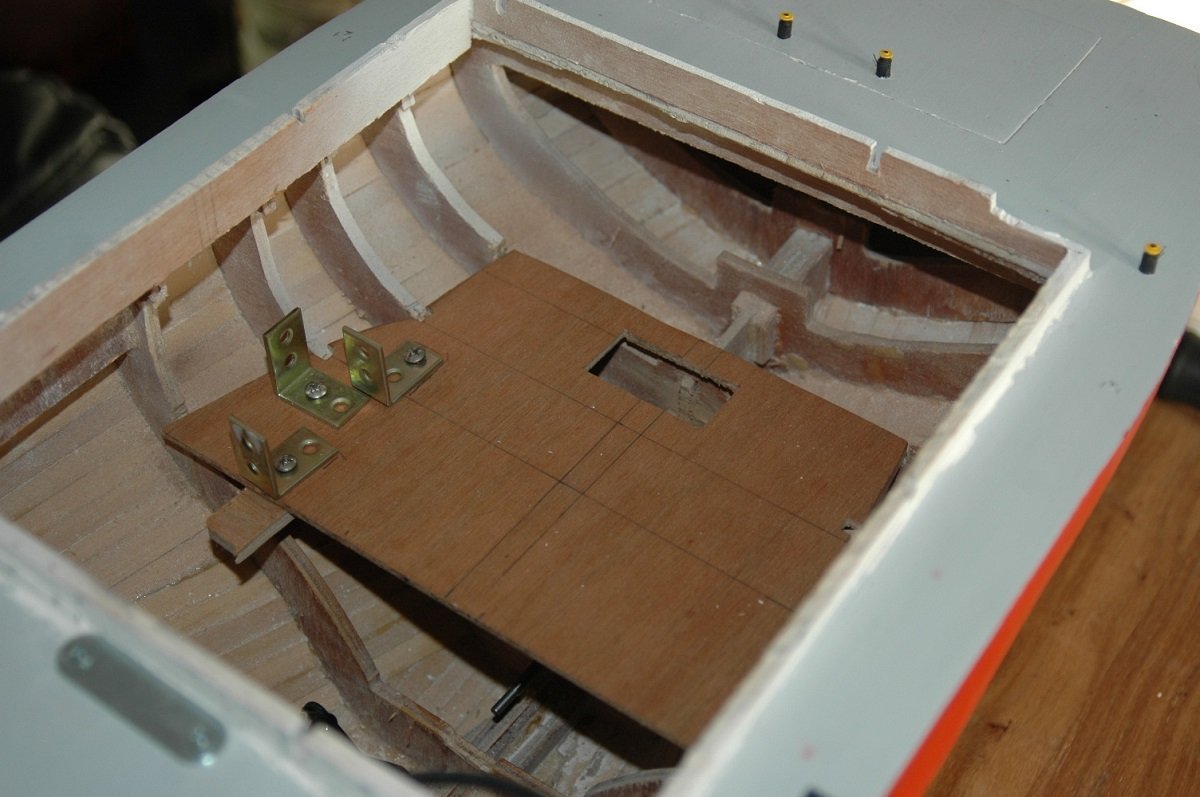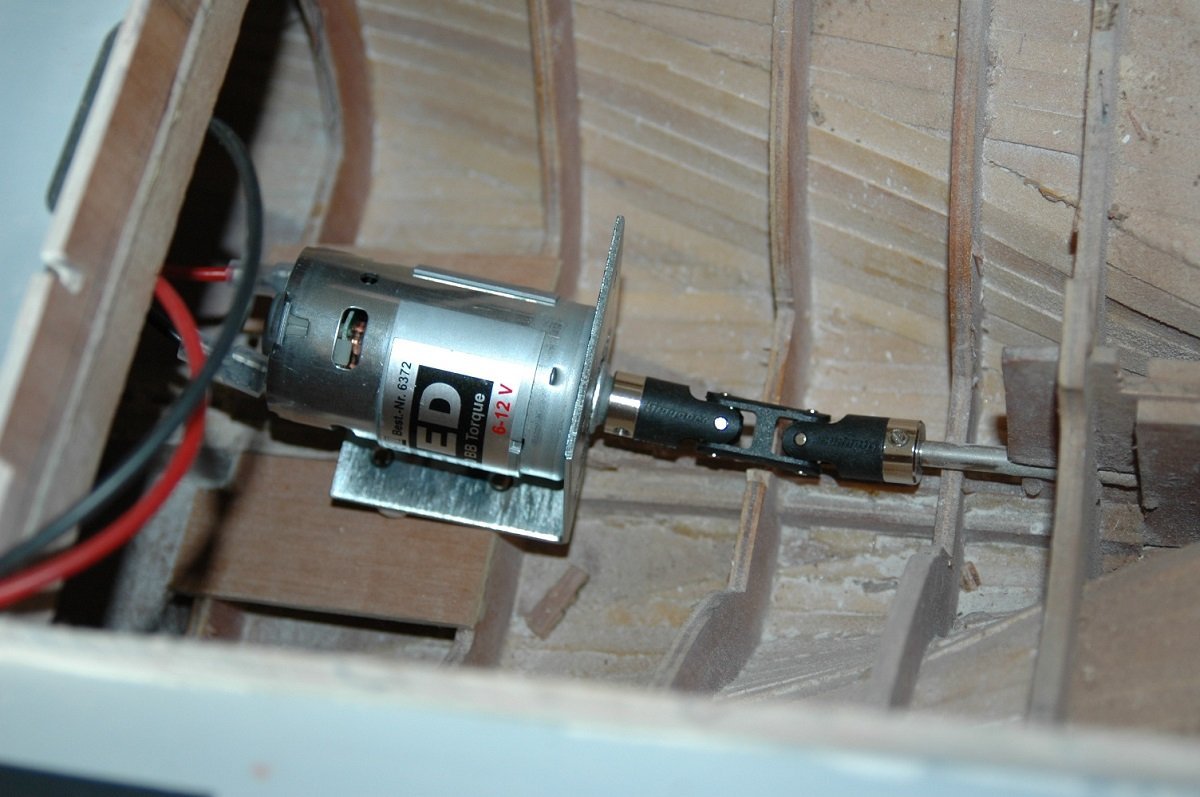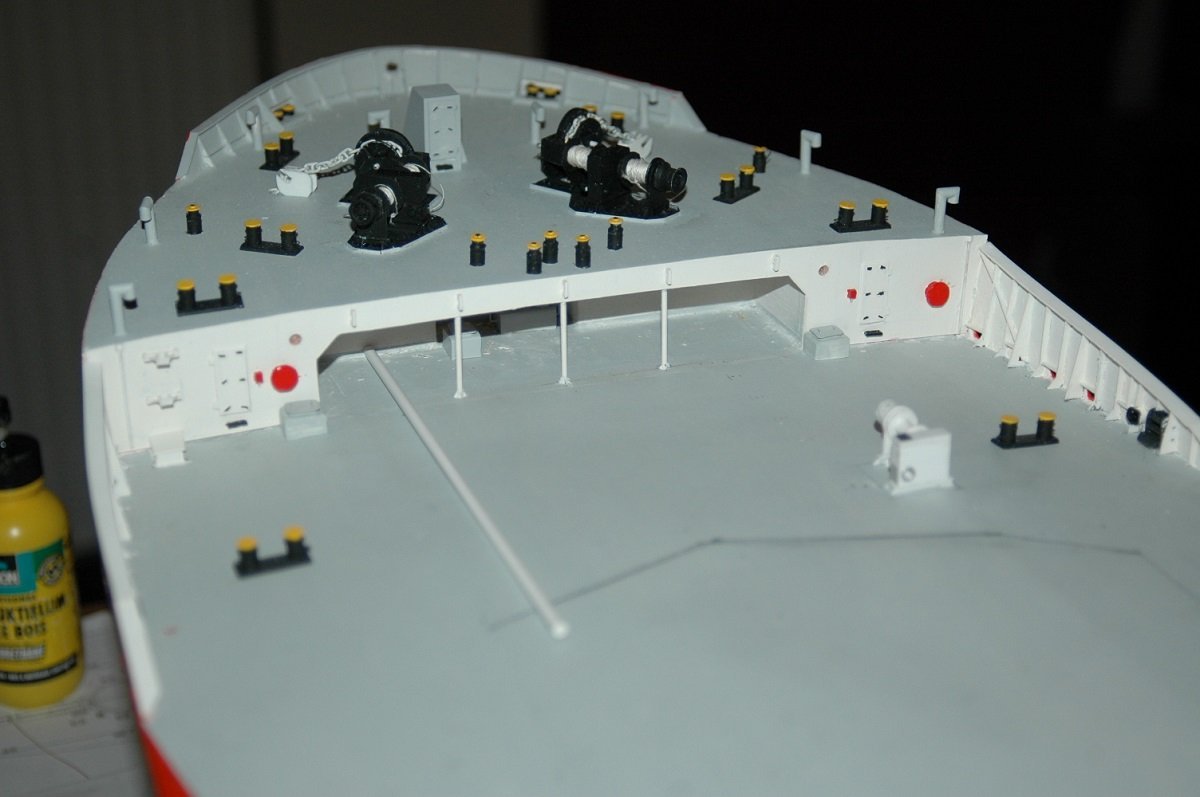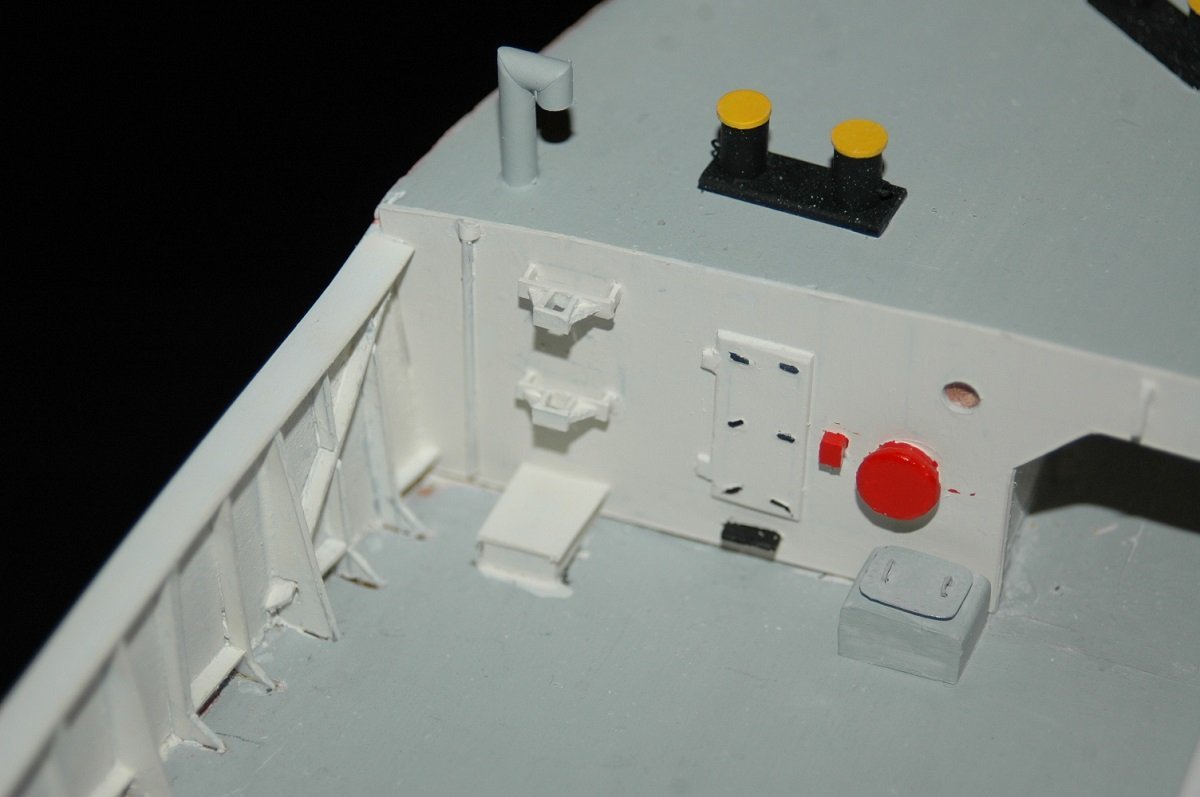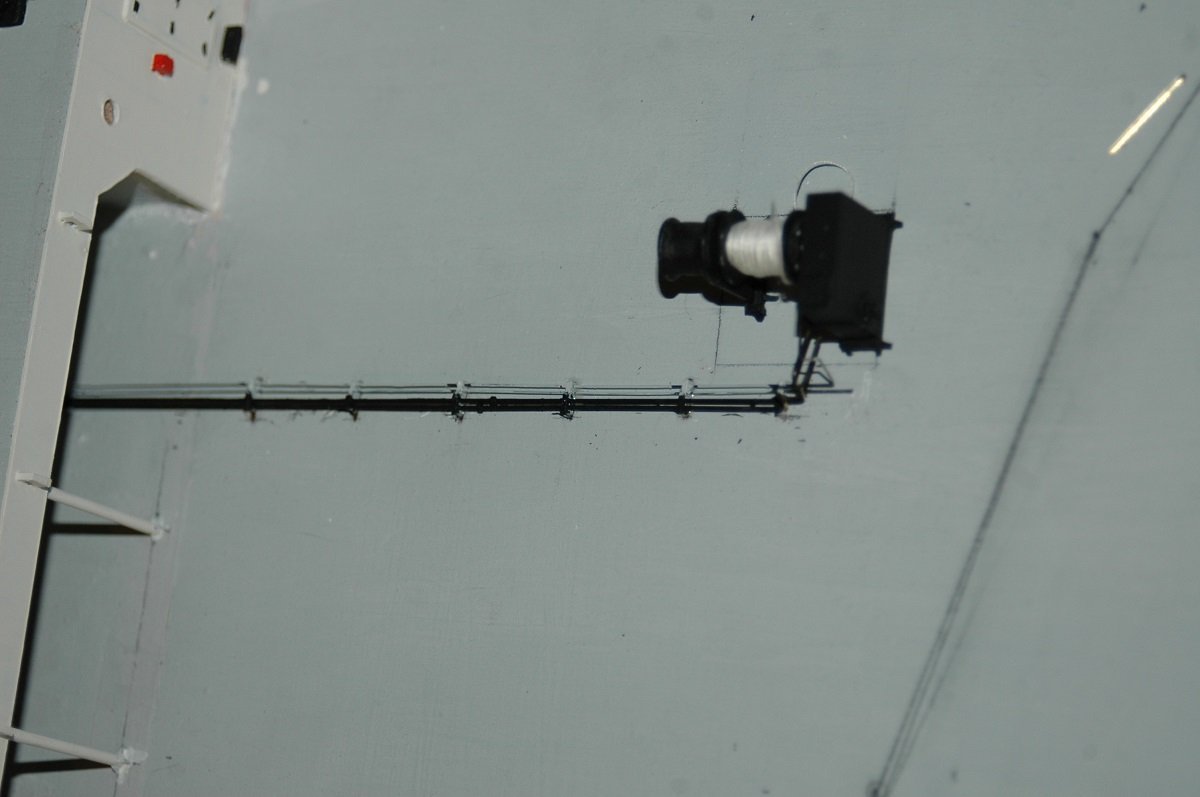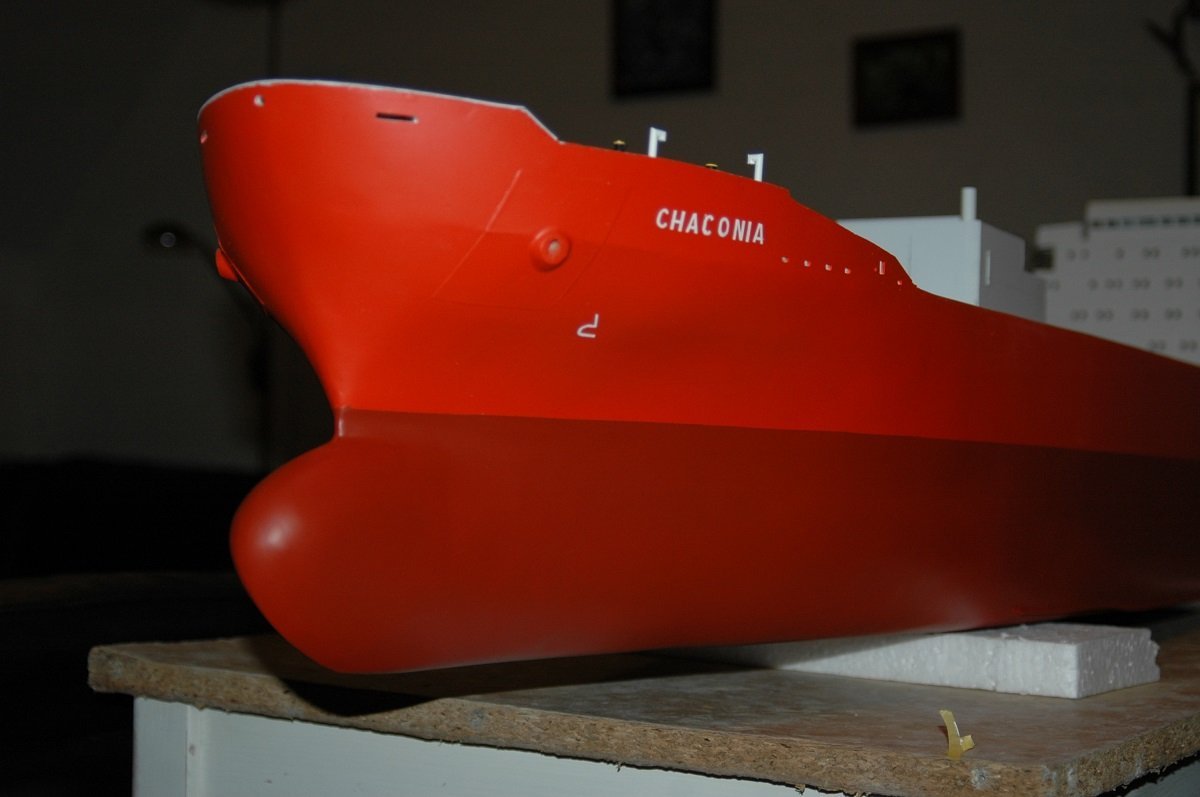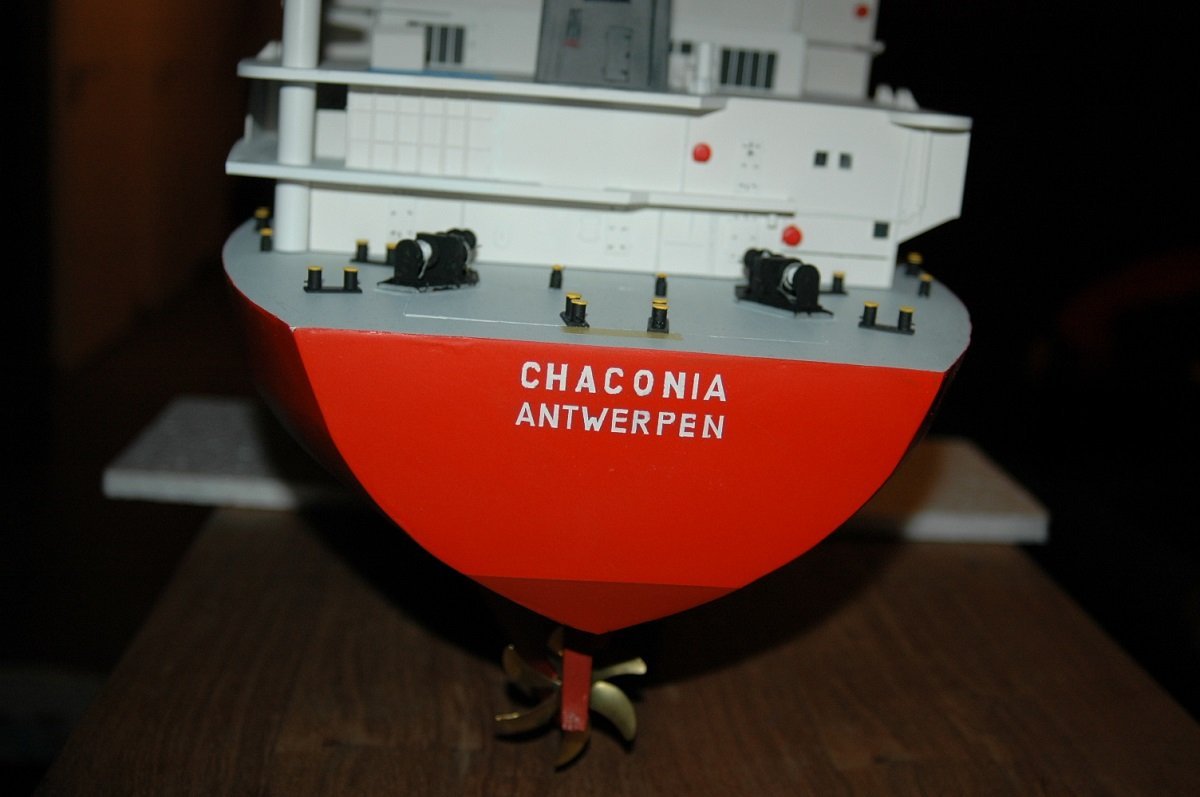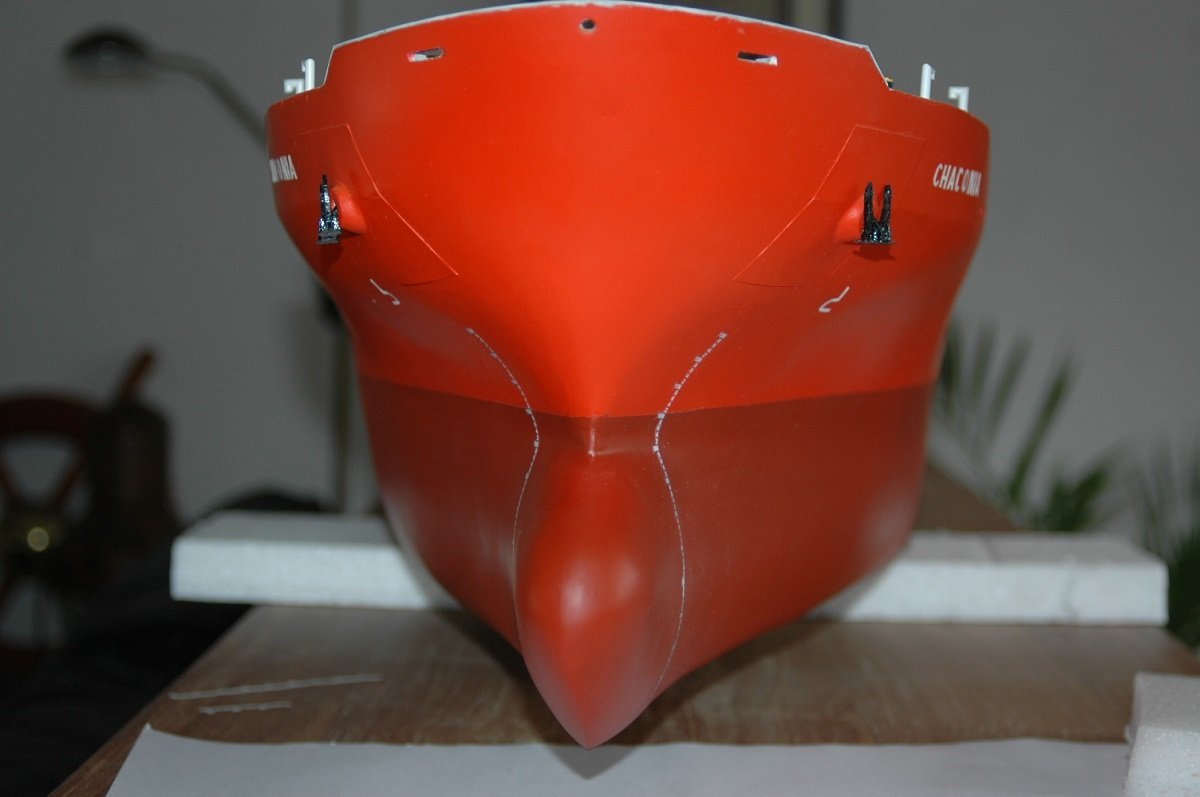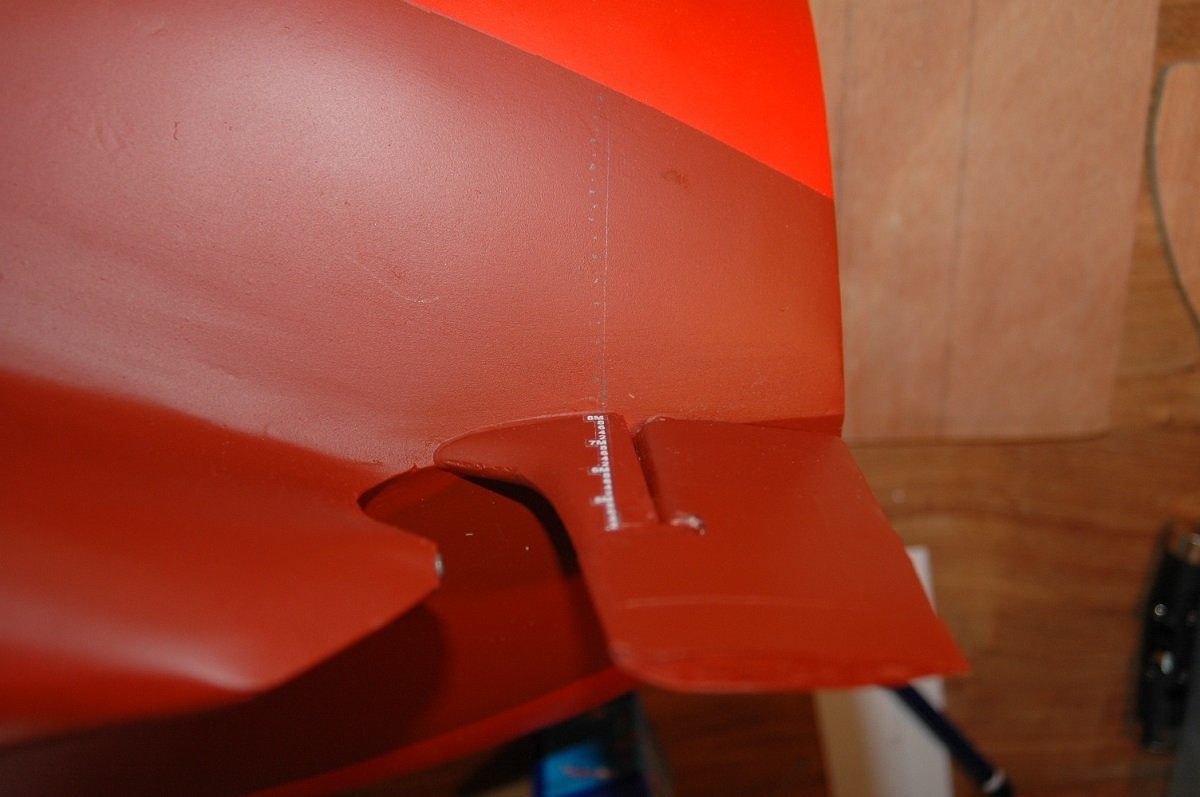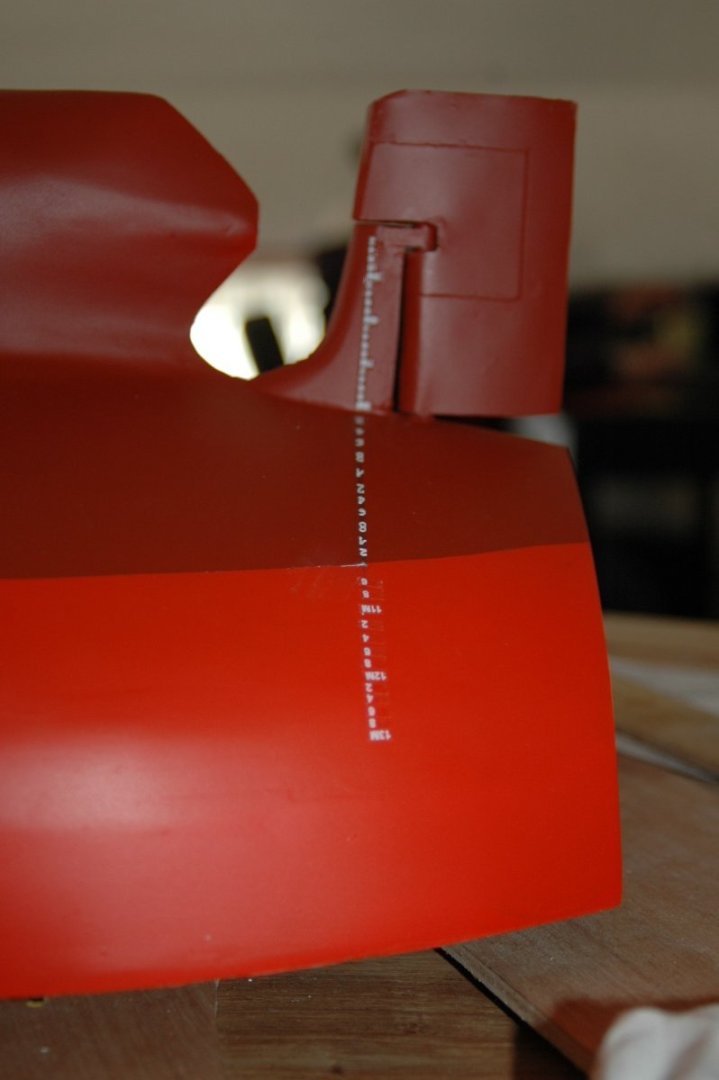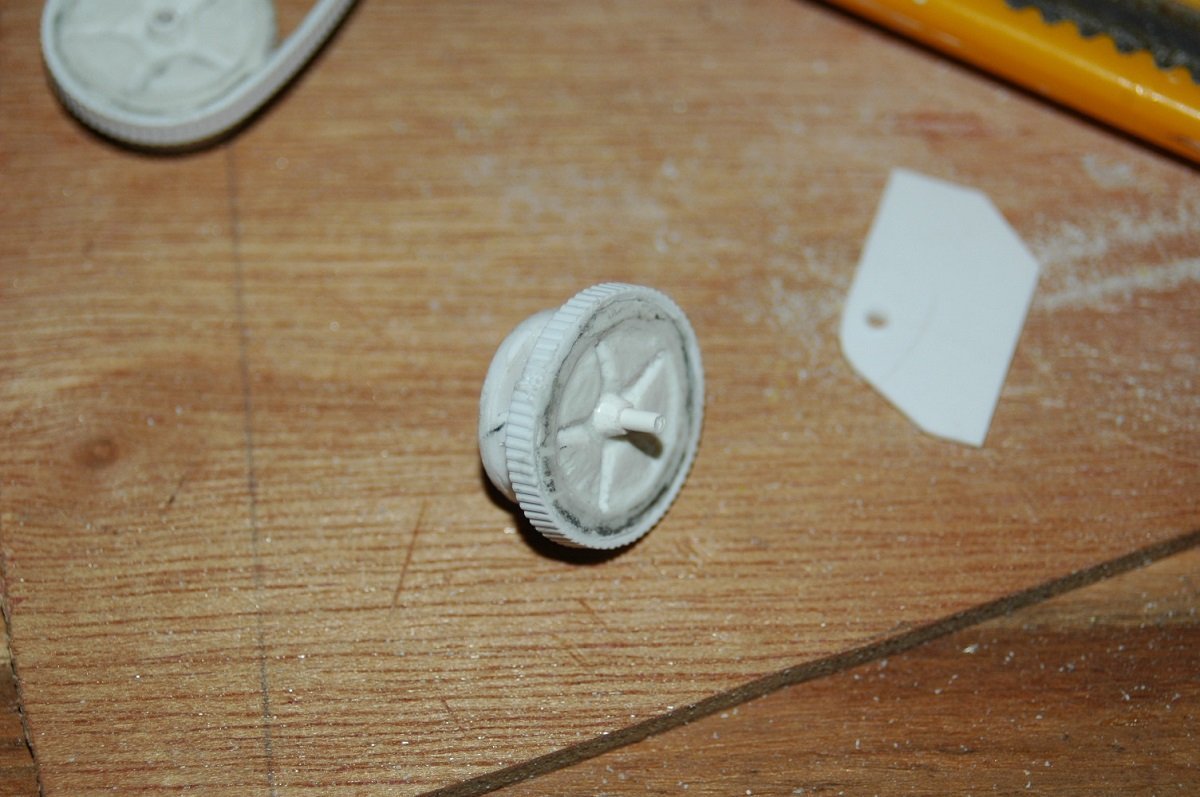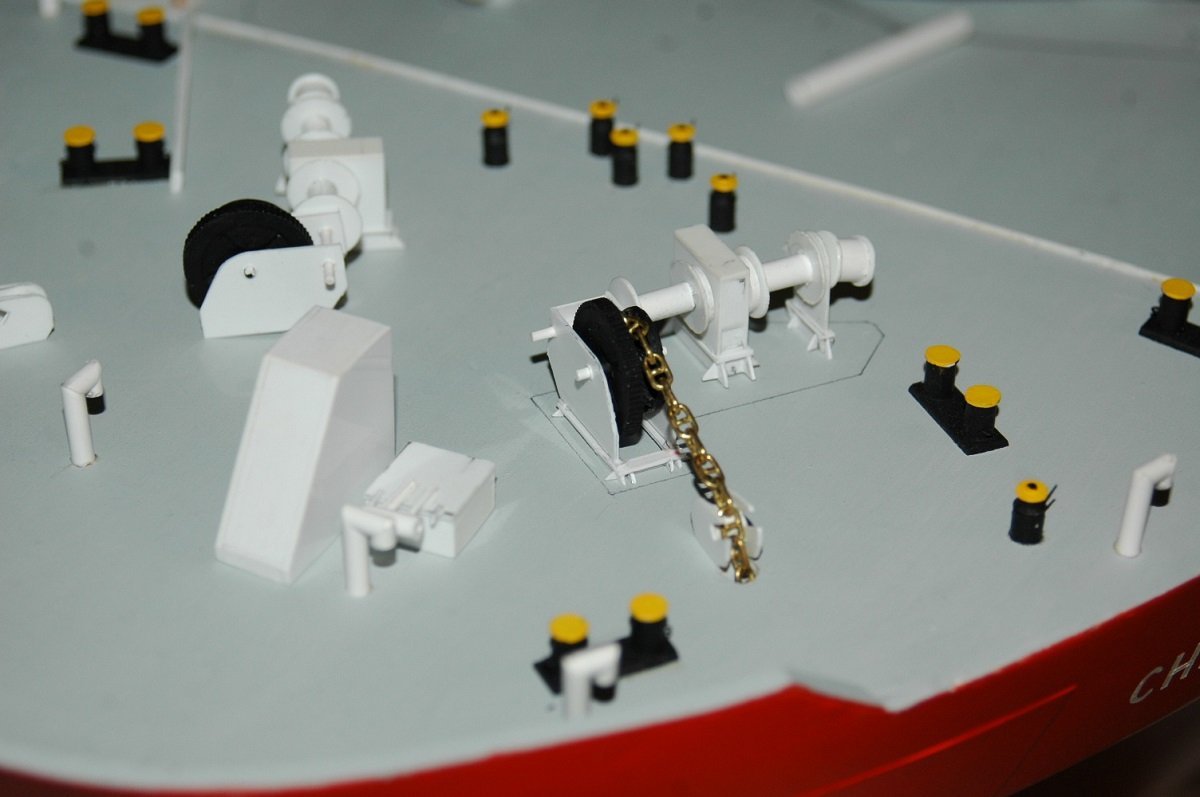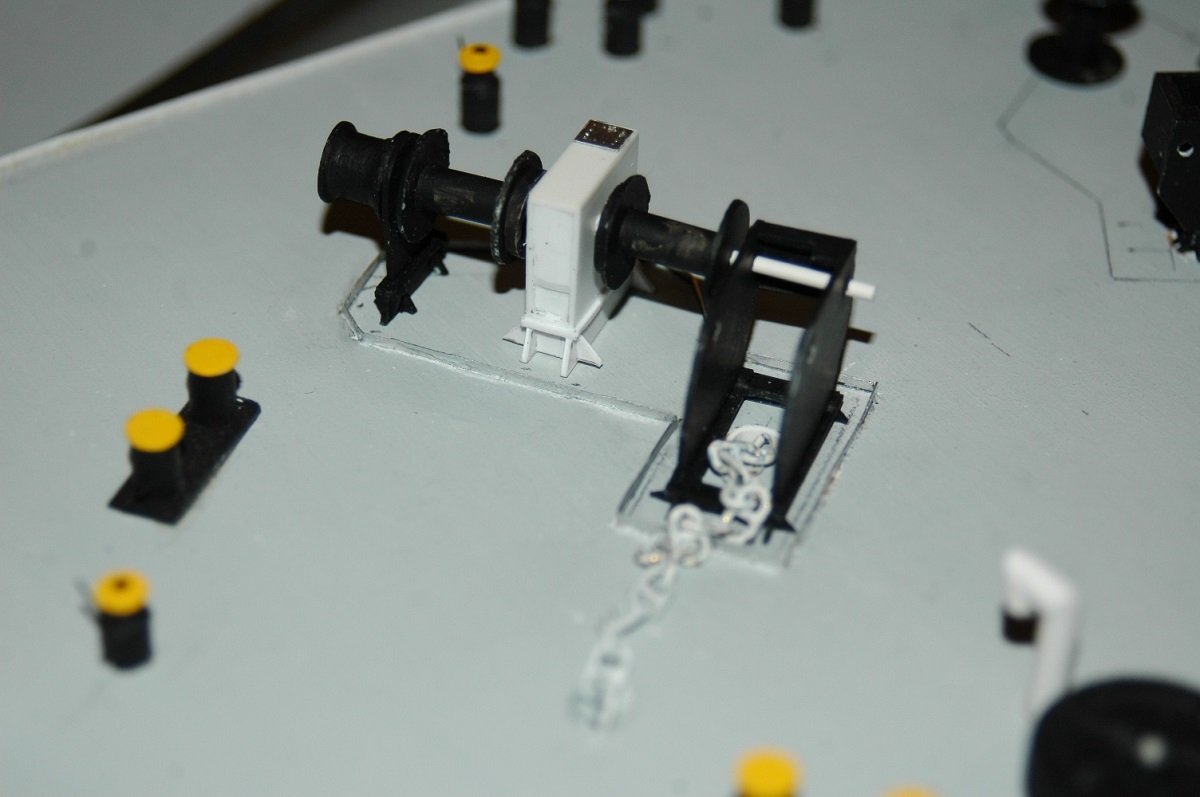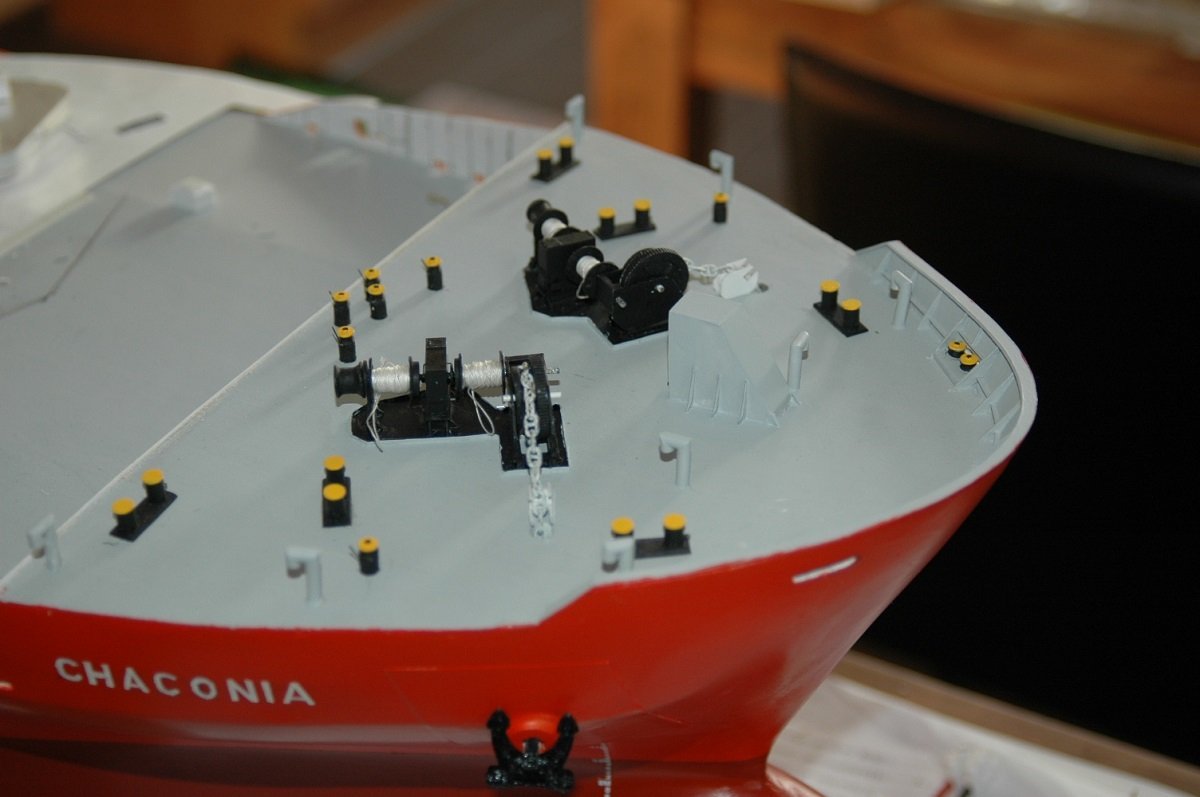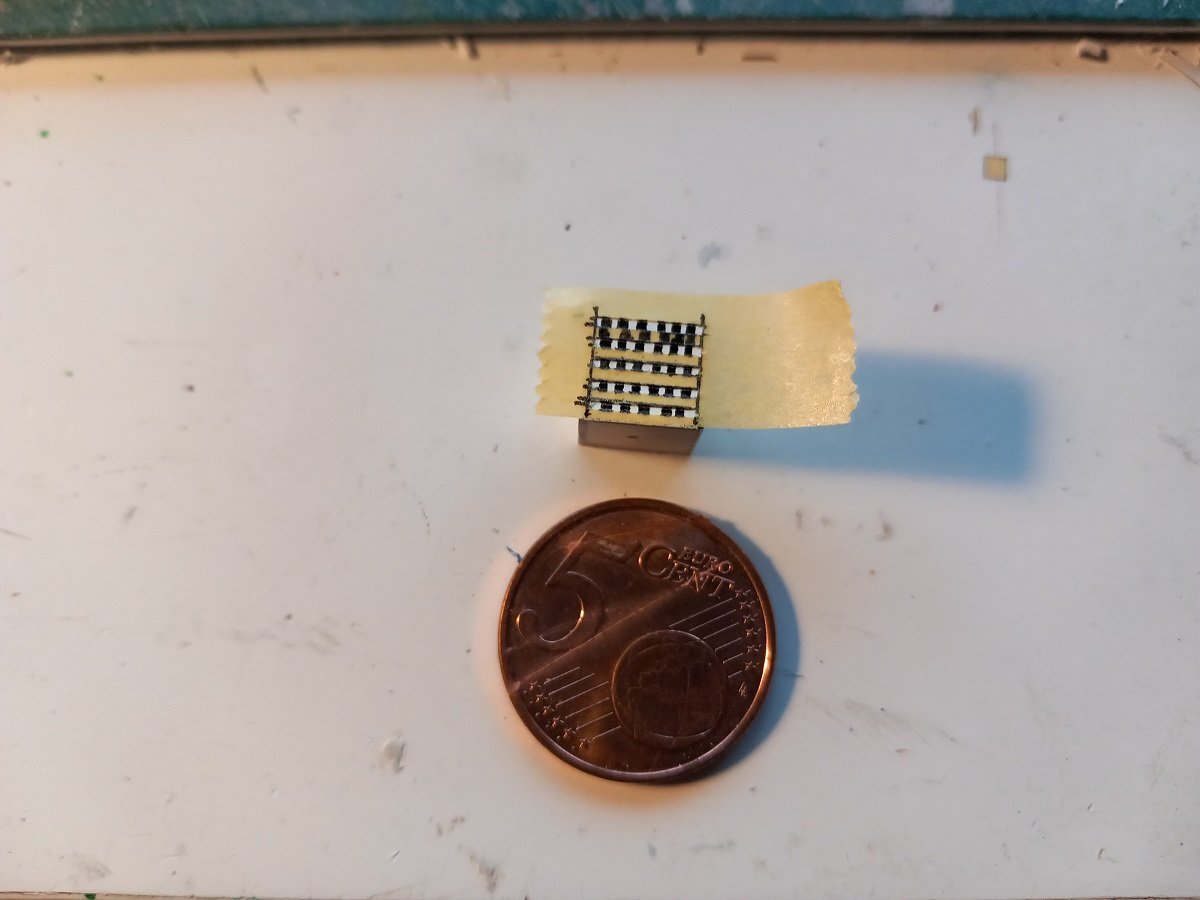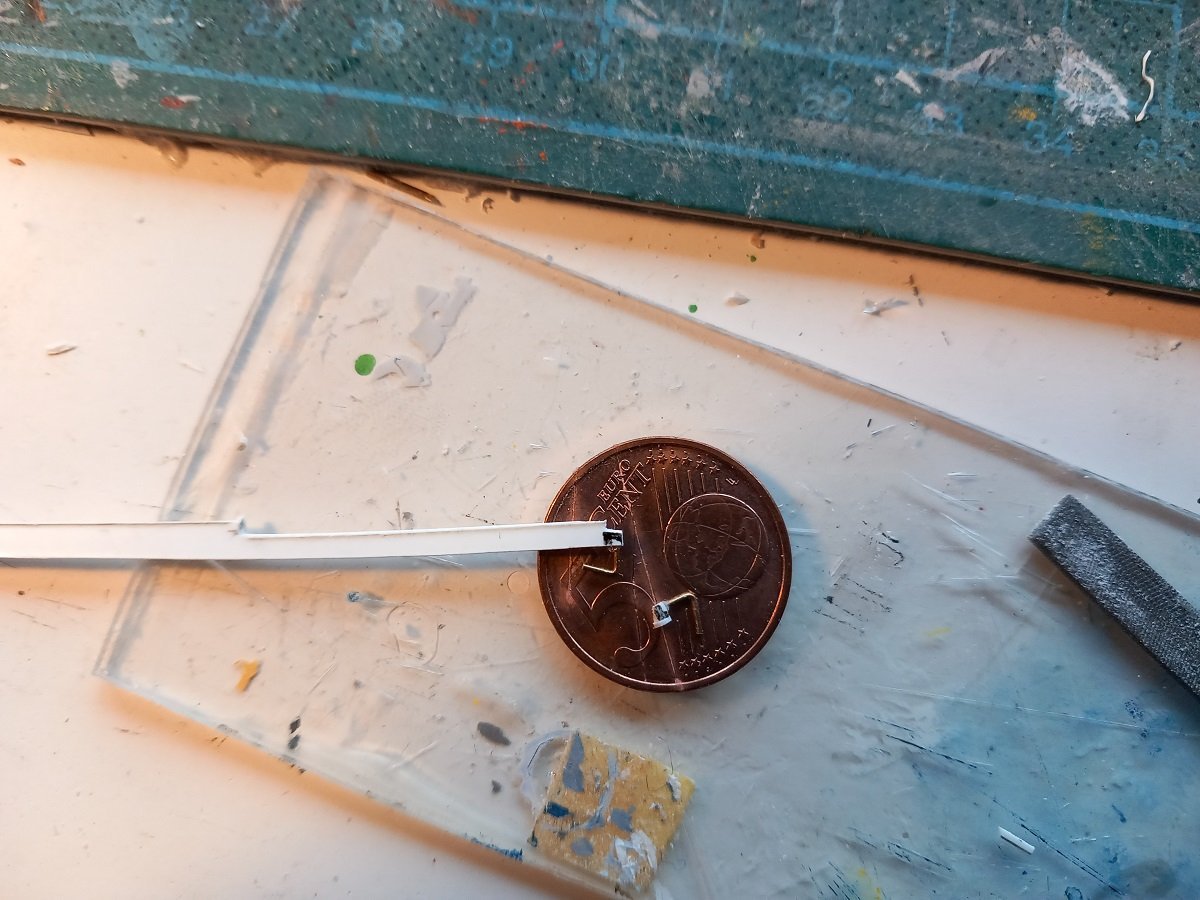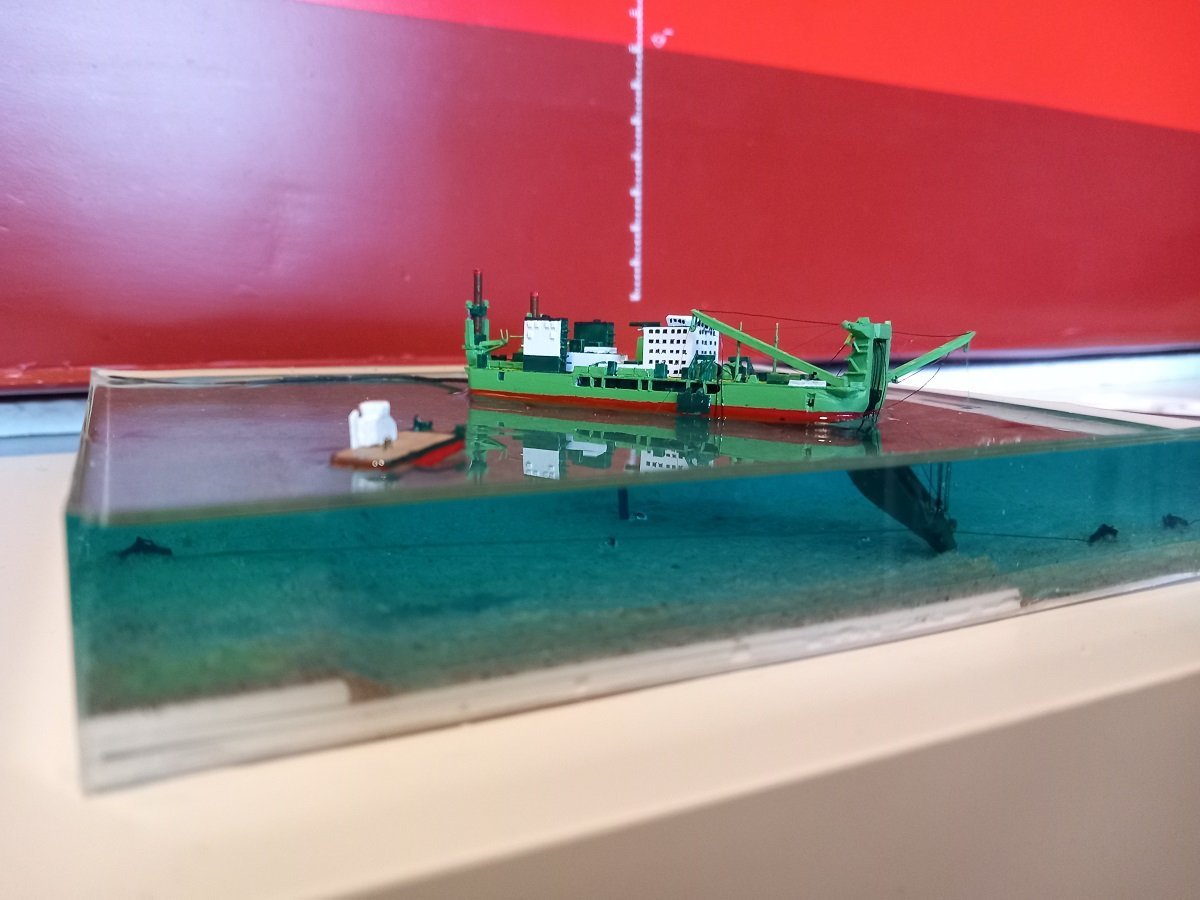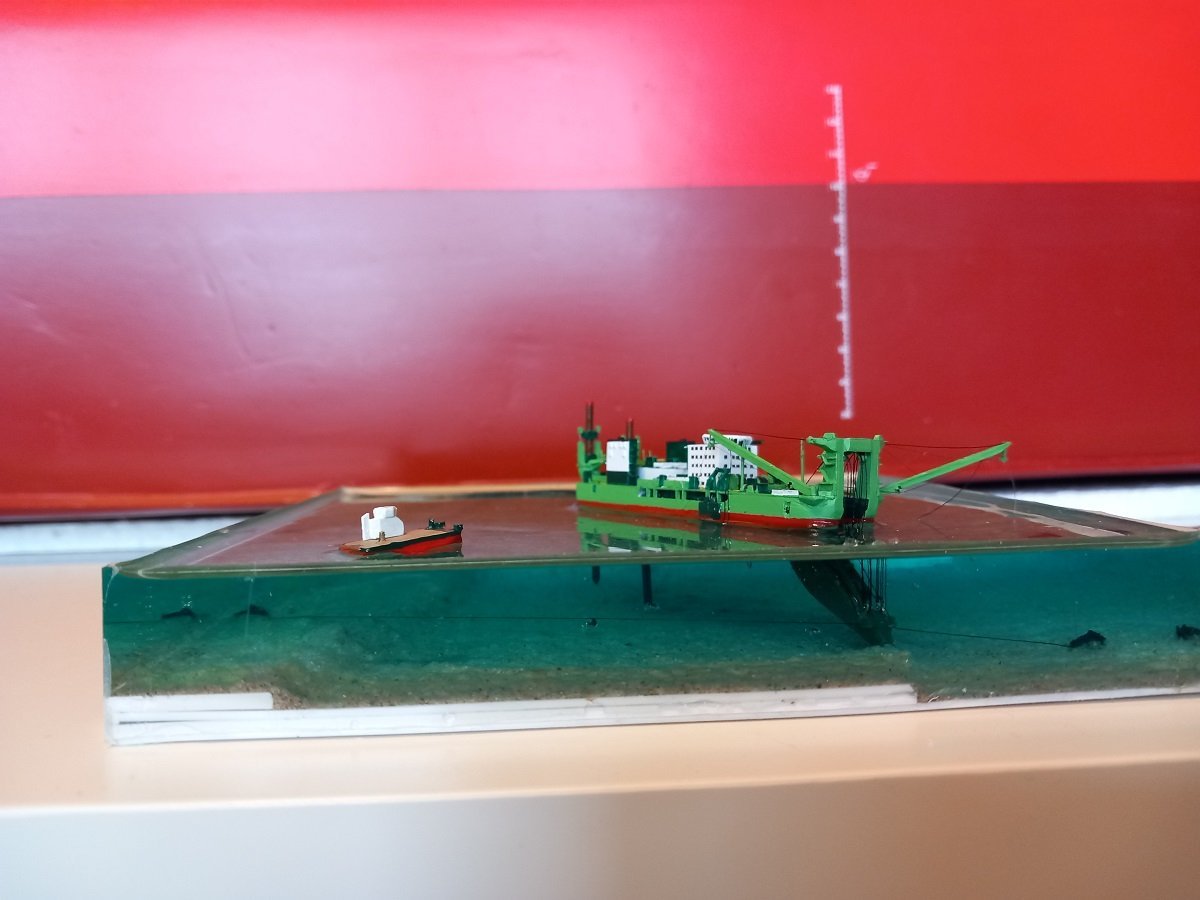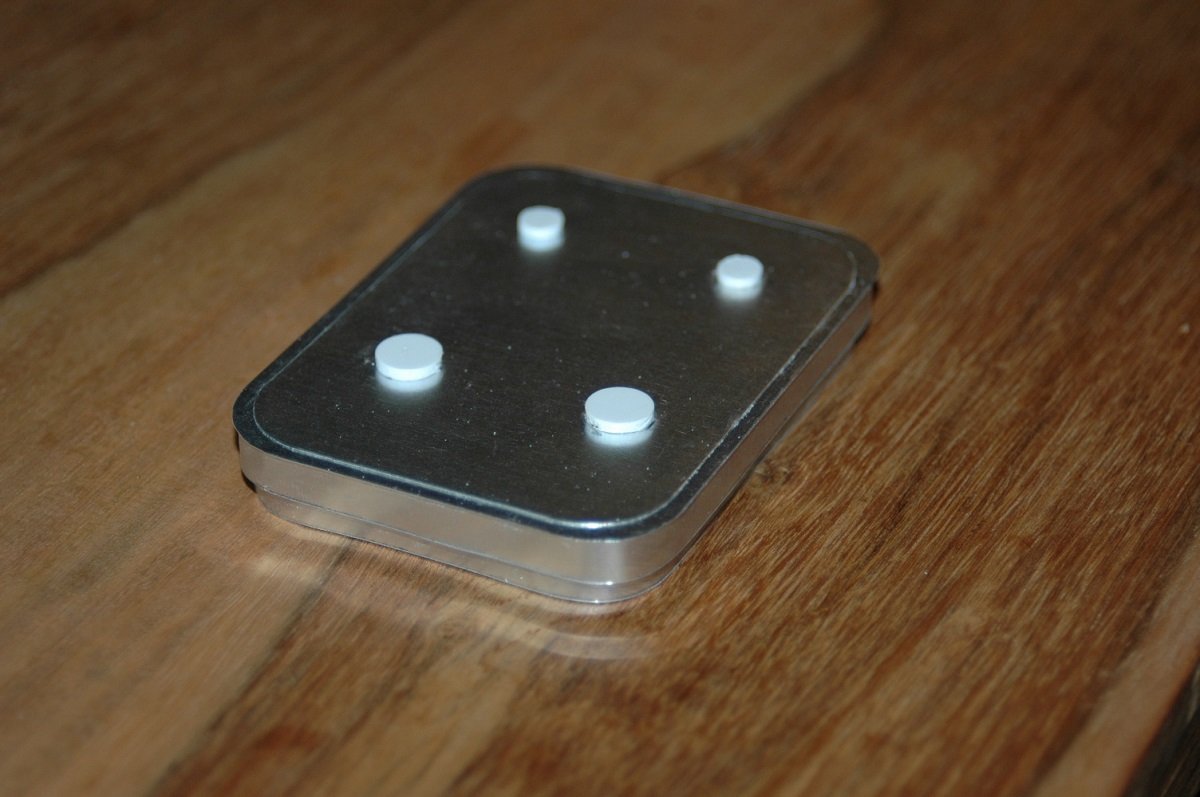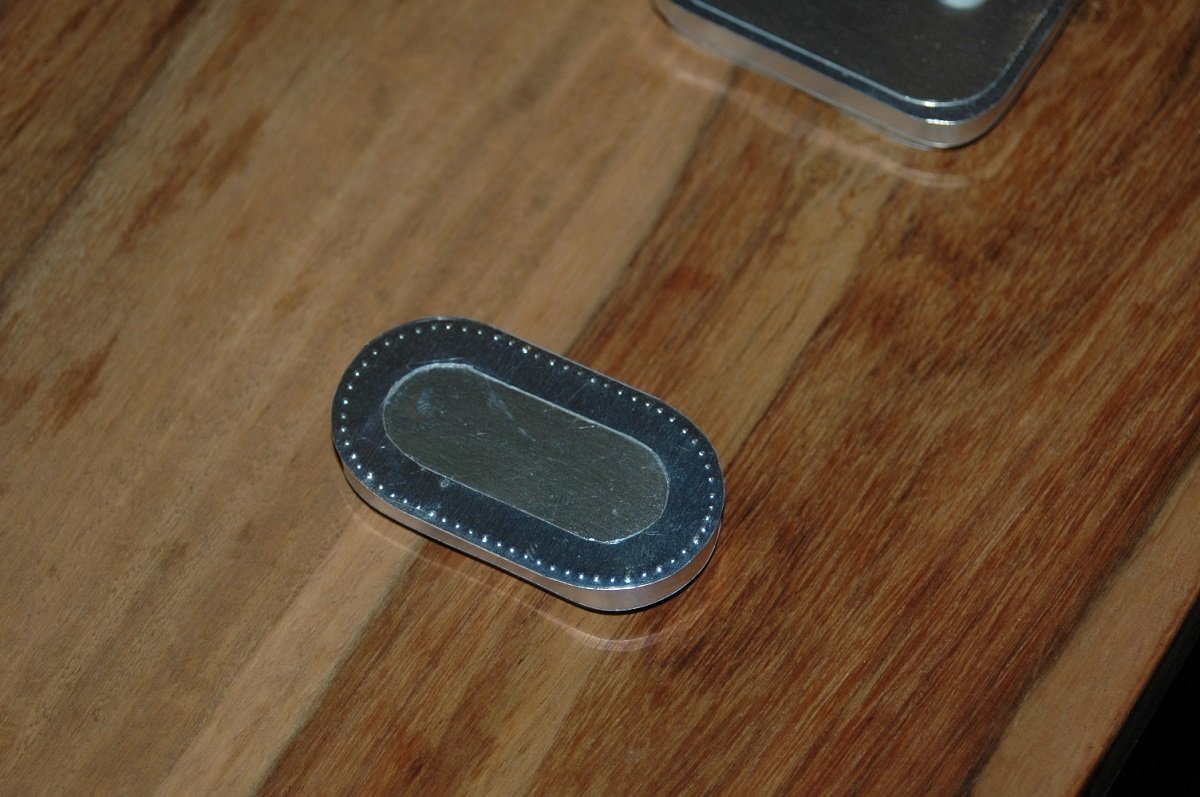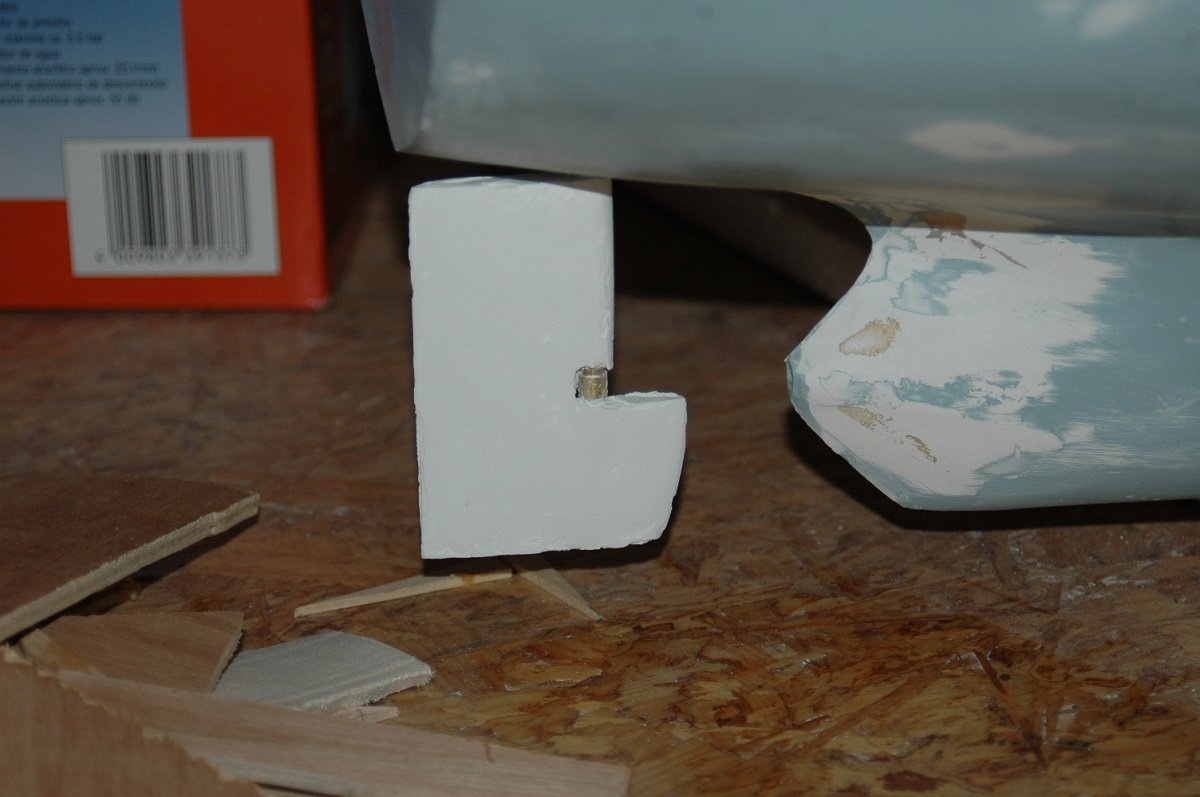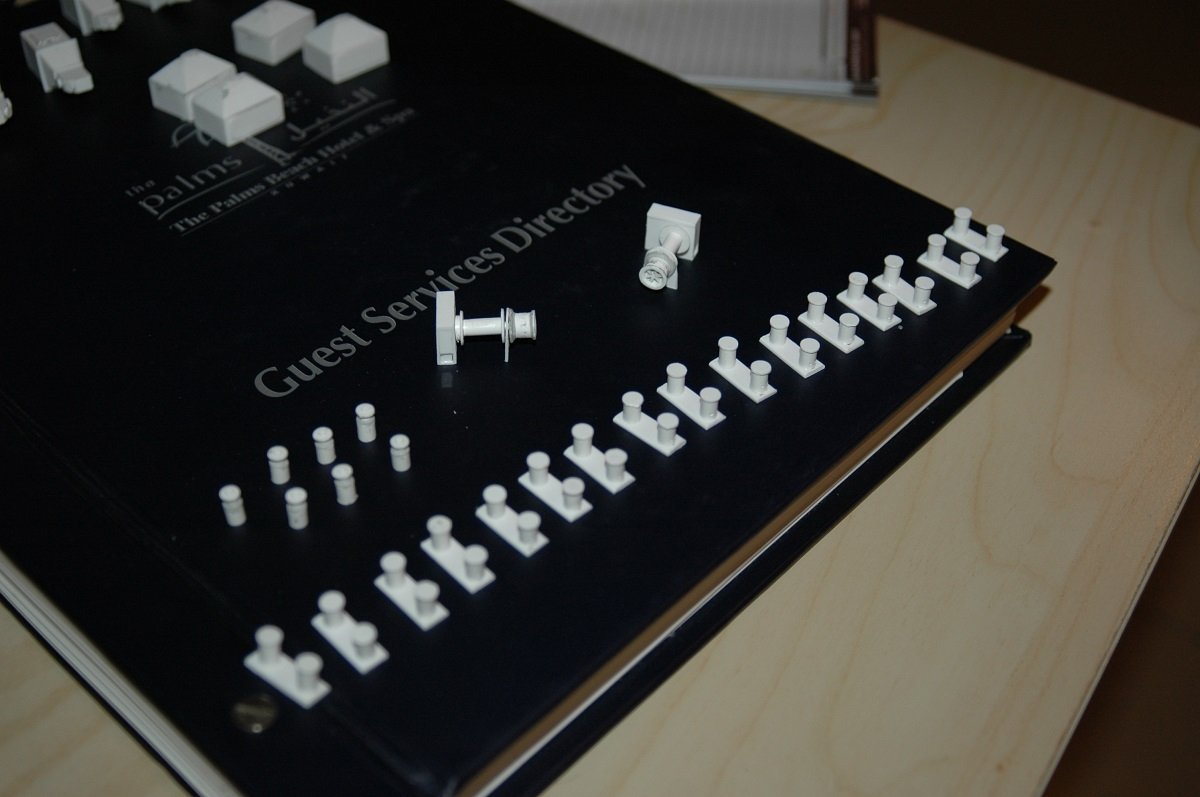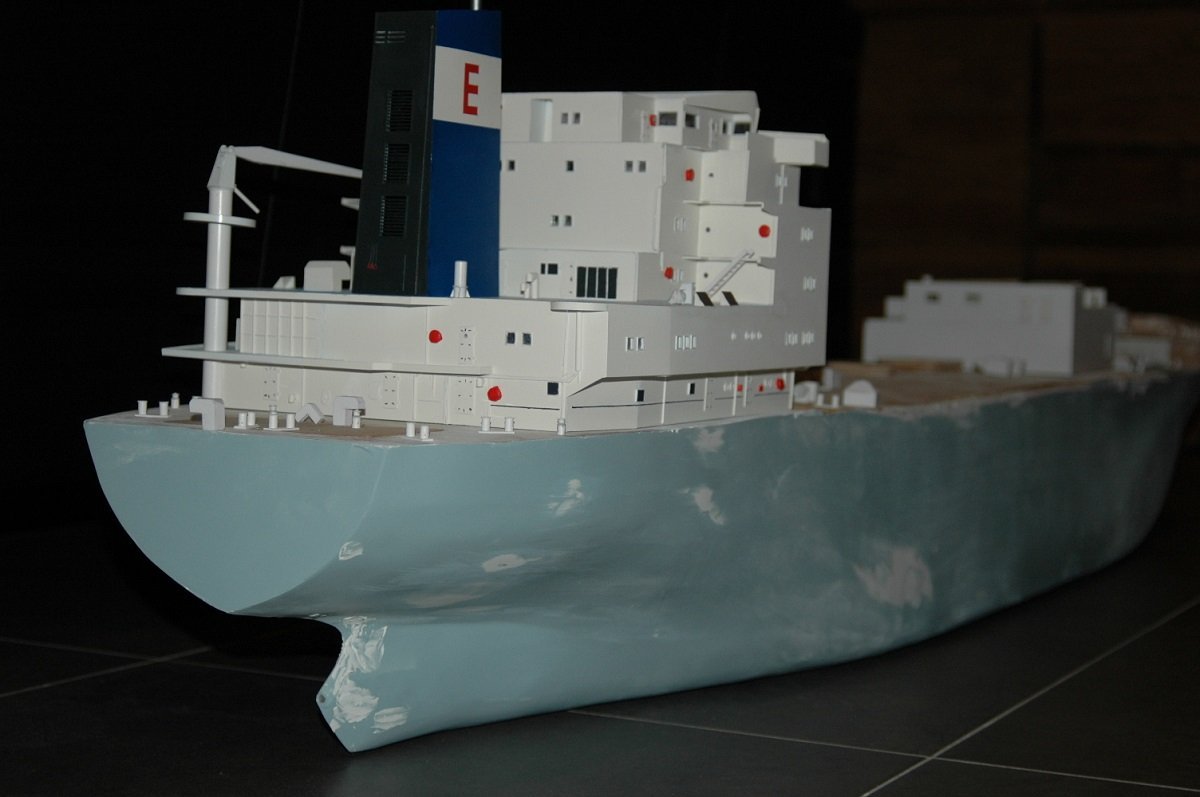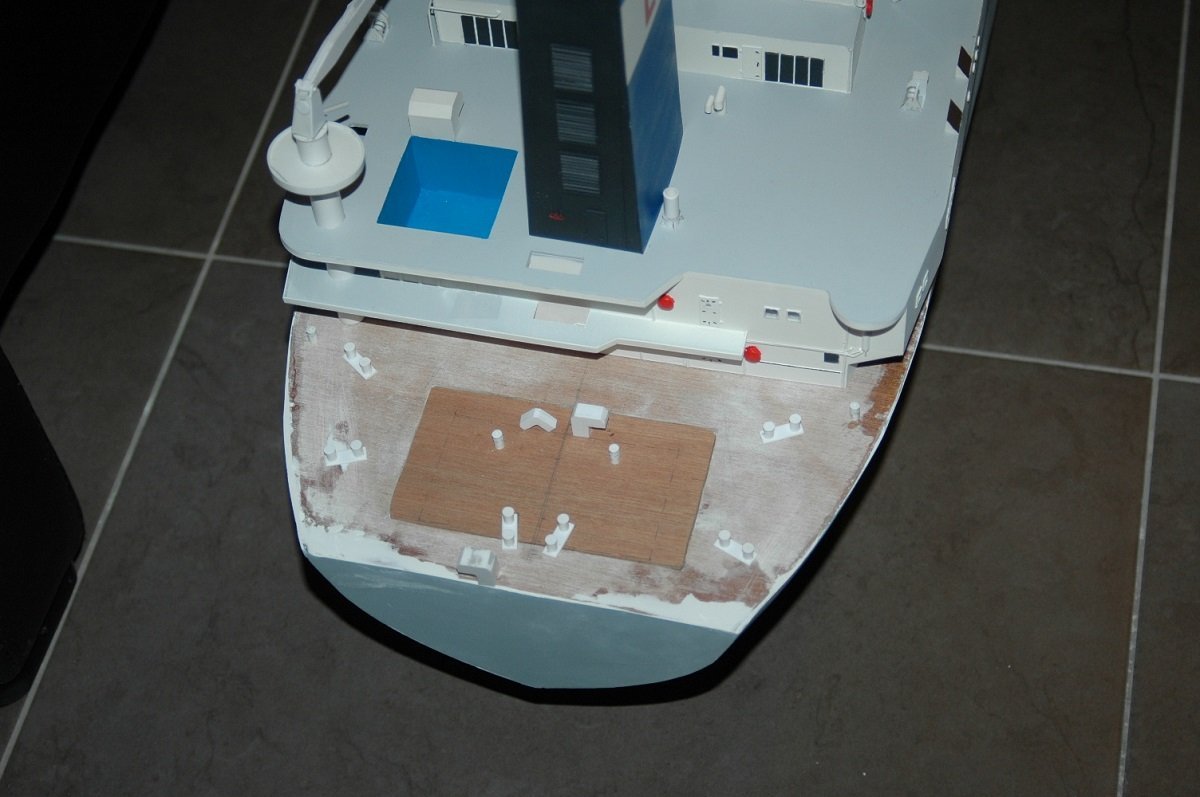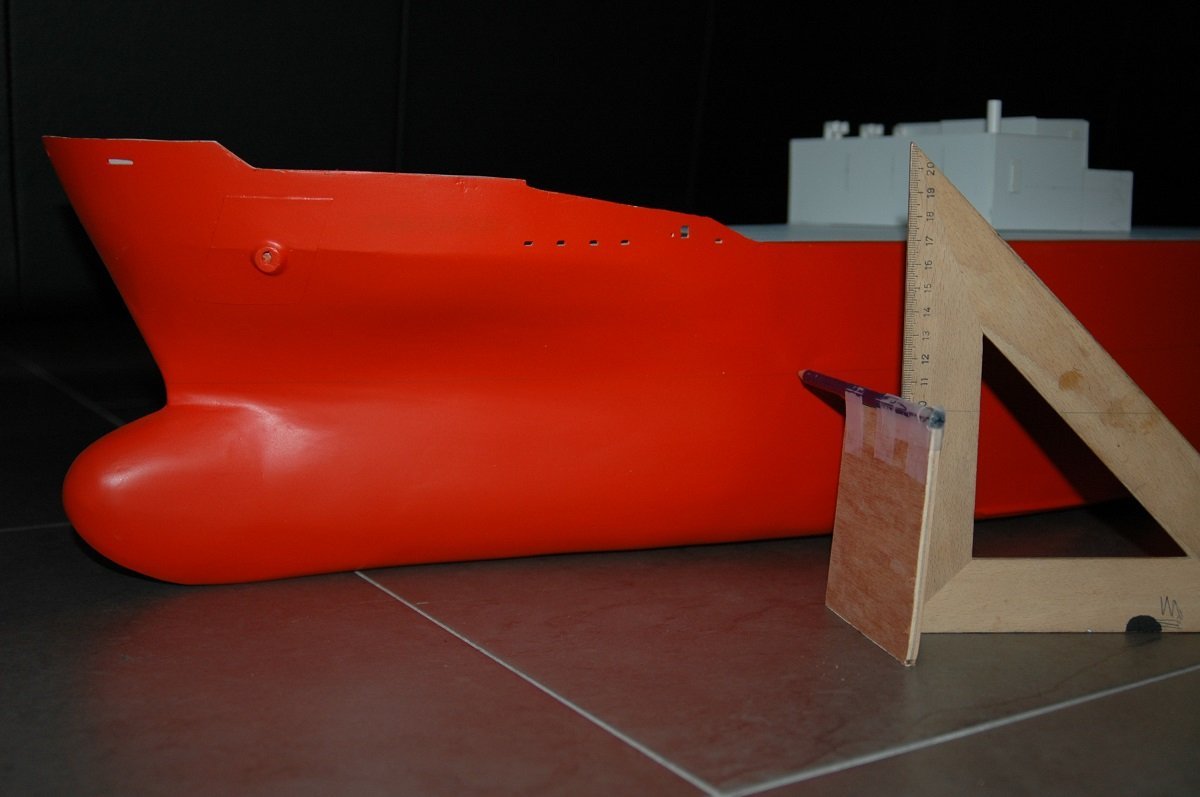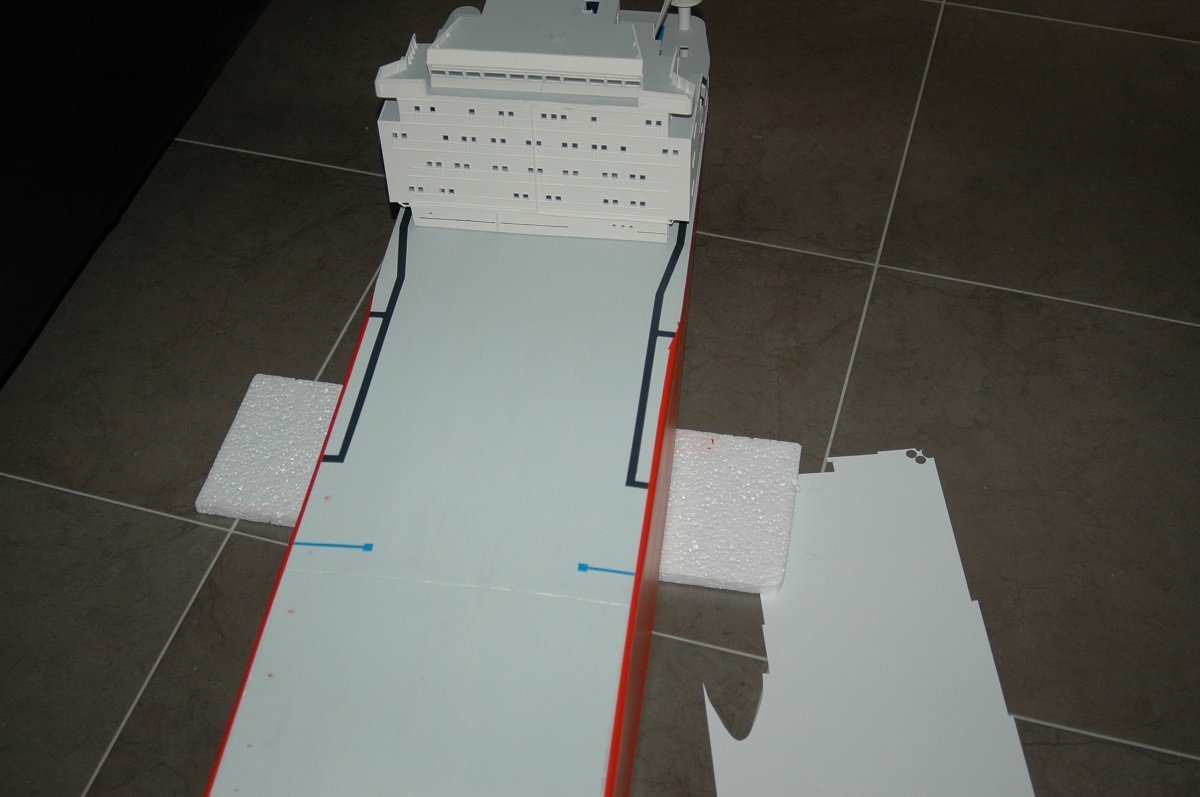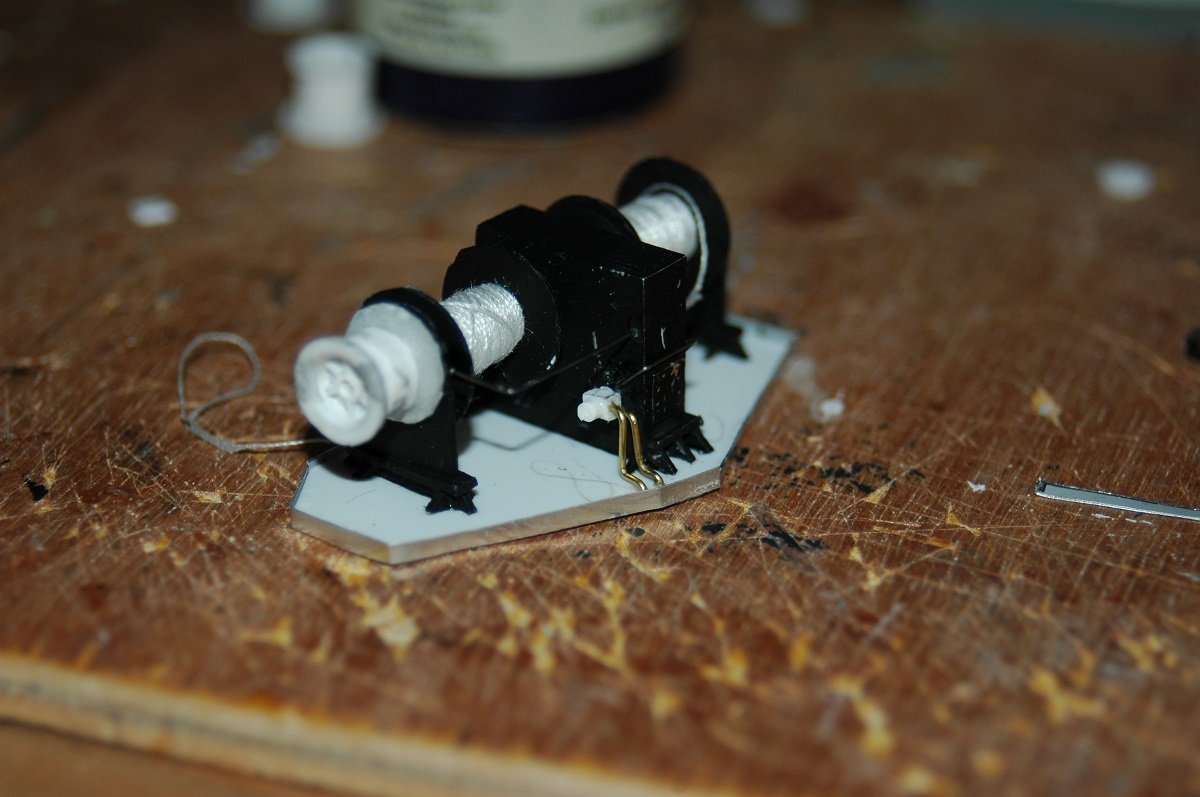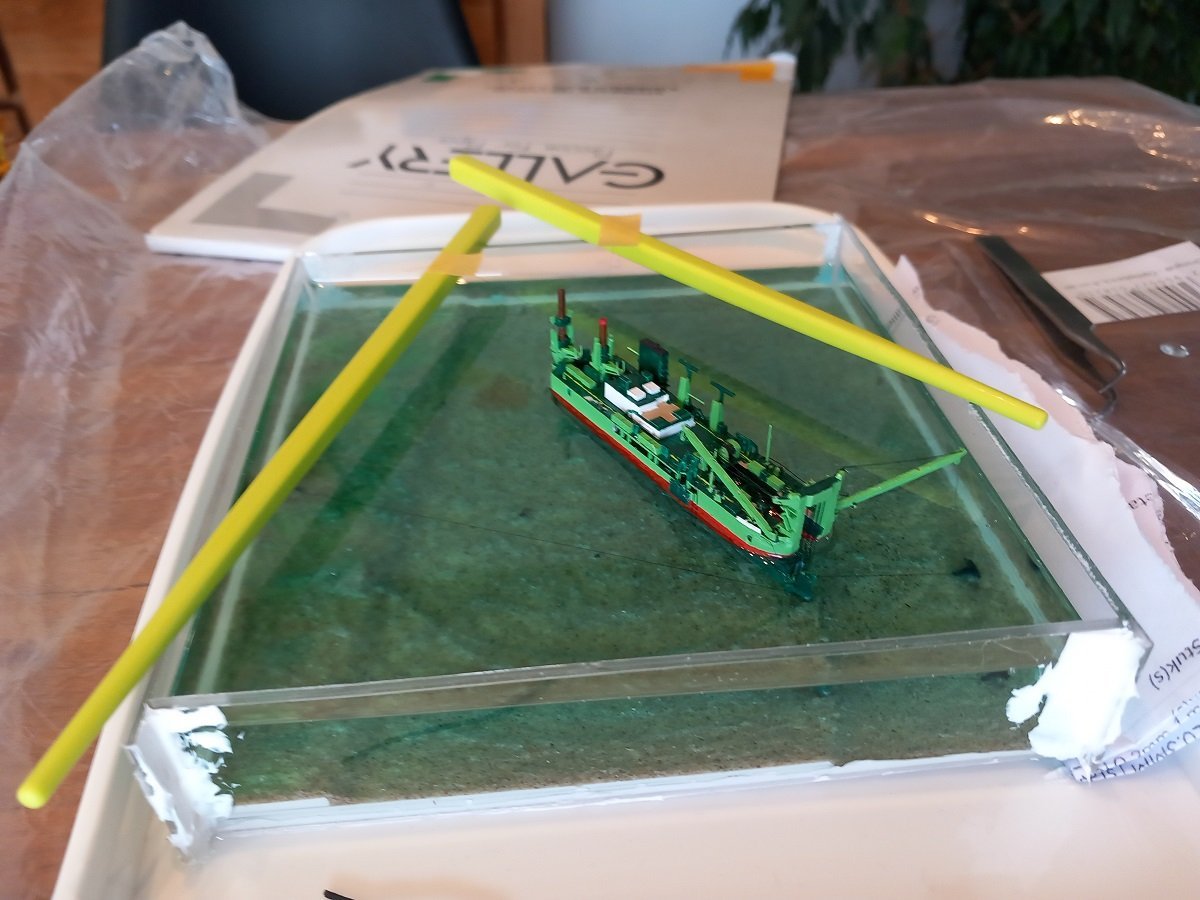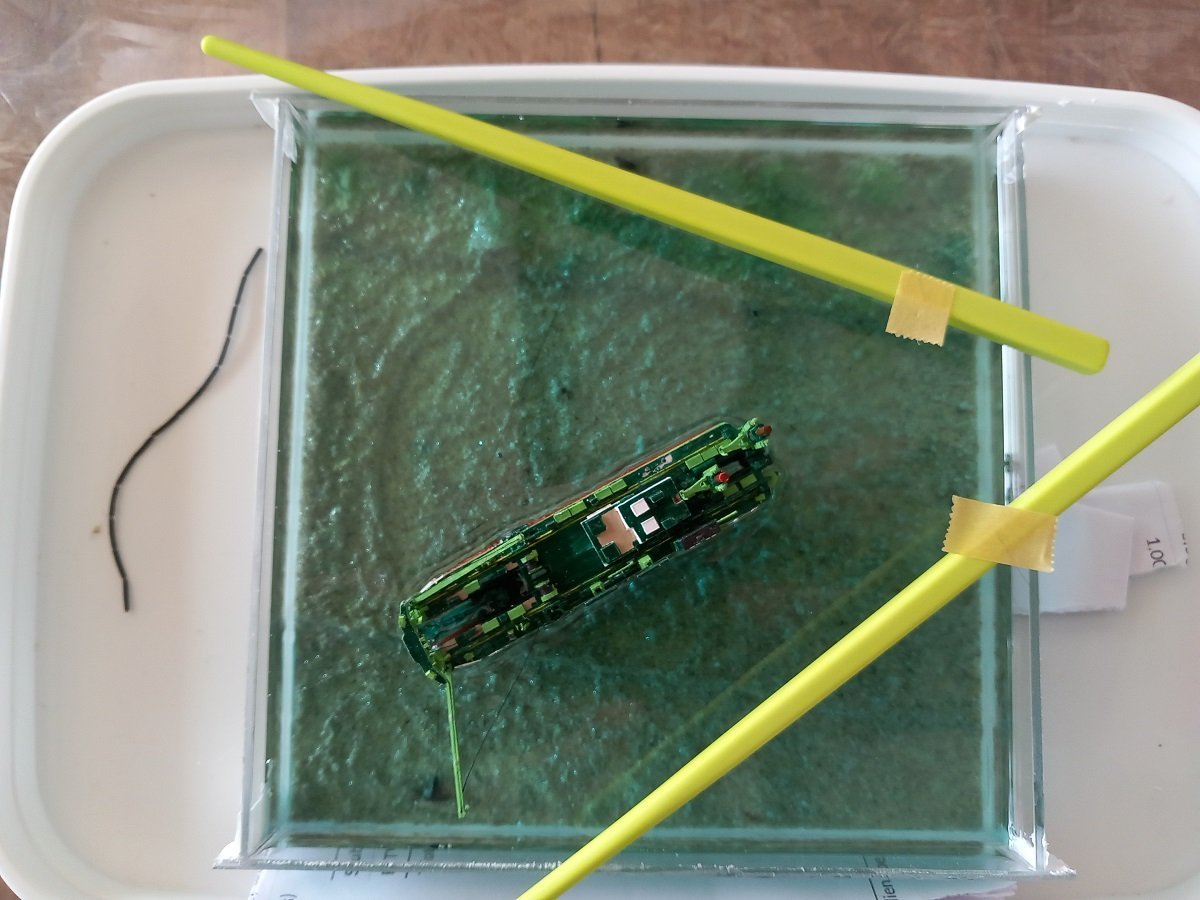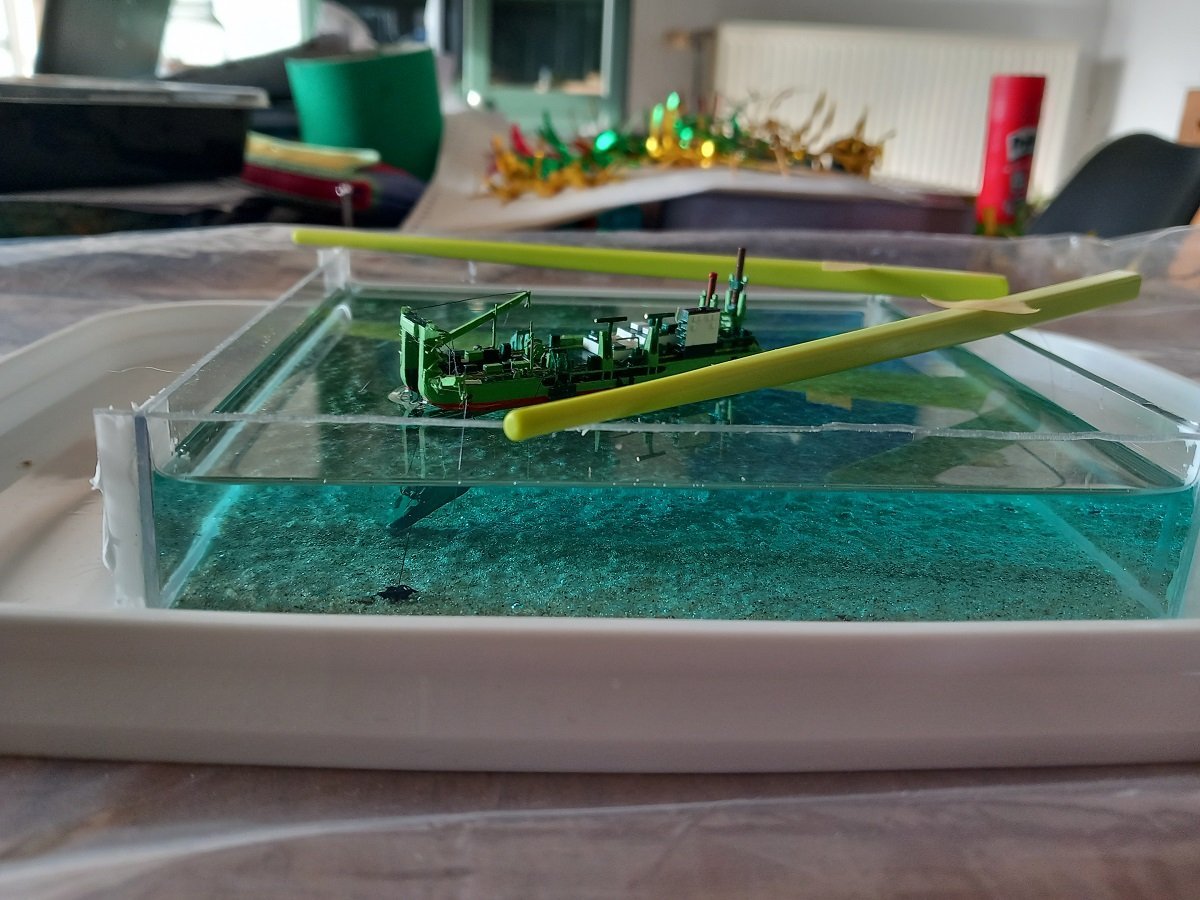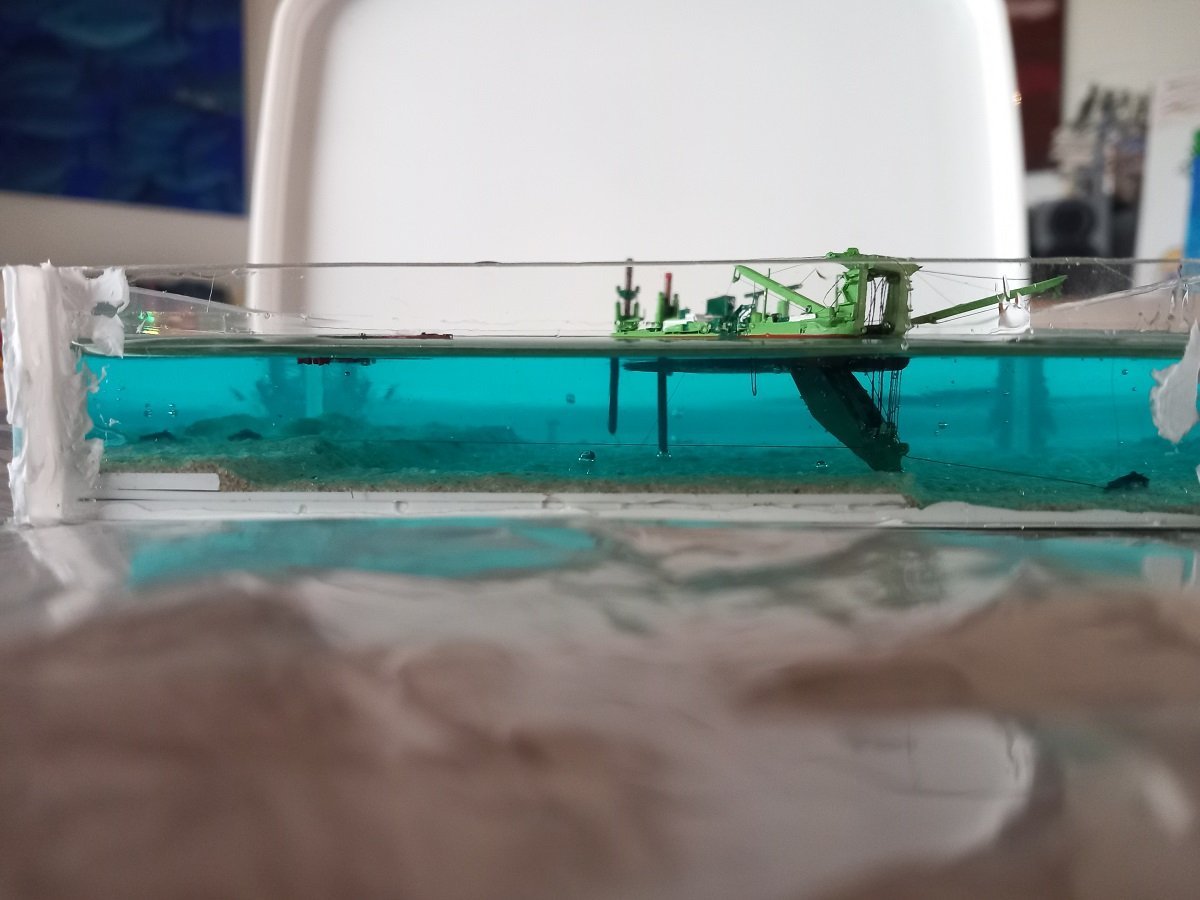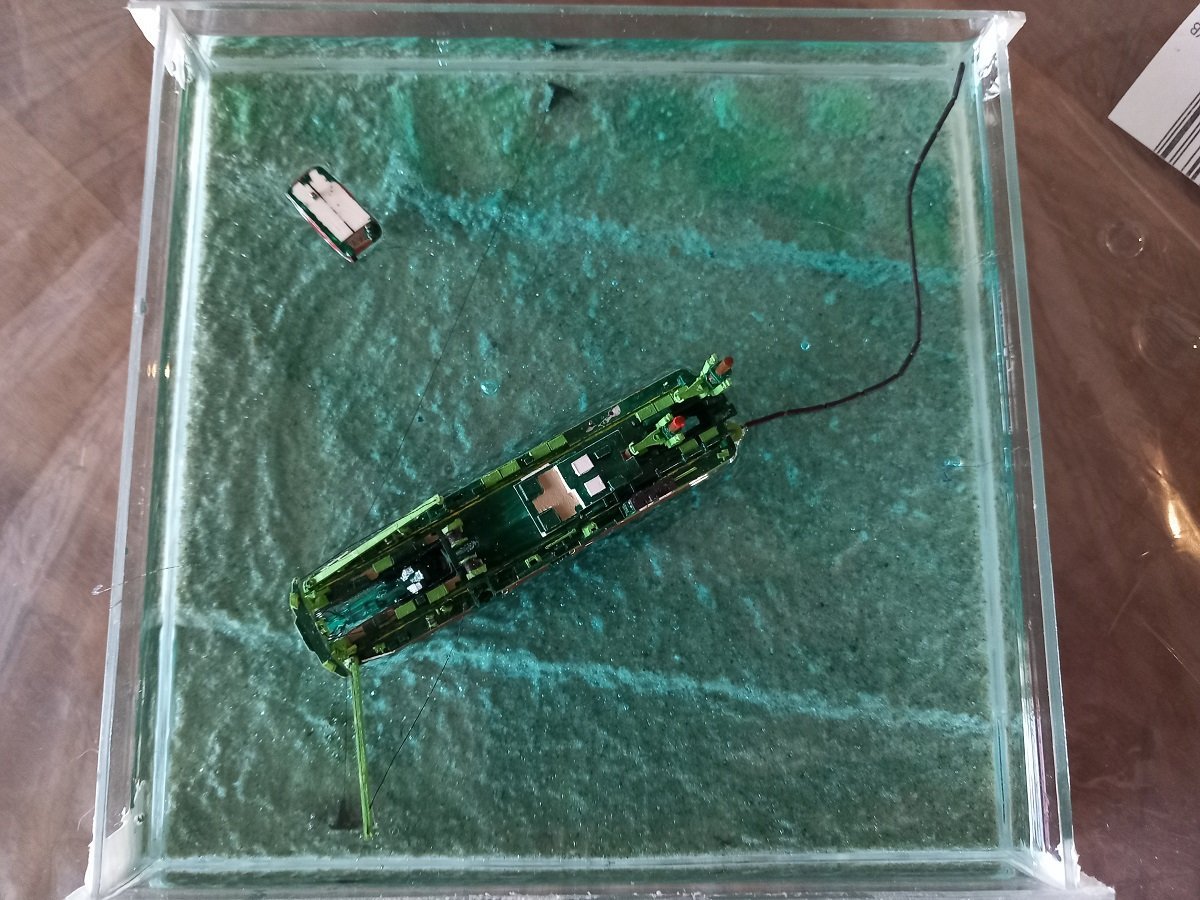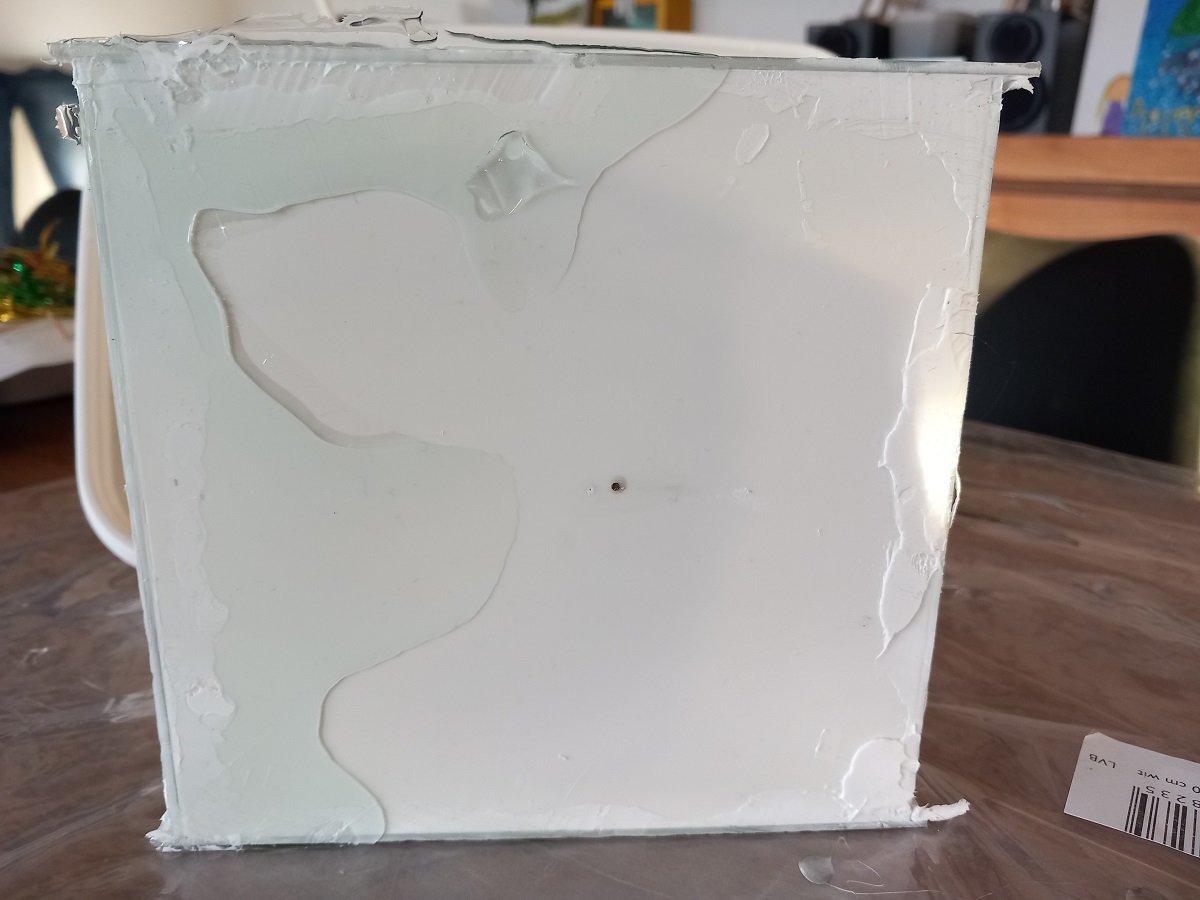-
Posts
624 -
Joined
-
Last visited
Content Type
Profiles
Forums
Gallery
Events
Everything posted by Javelin
-
Hi Nils, I've been collecting various telephone and electronics wires. Some of them have tiny copper wires, but with a stainless steel look, inside. They go to less than 0.1mm diameter and can be turned into a single wire with a 0.2 -0.3mm diameter. I used a drill with something of a sliding weight on the other end to turn them. They are not springy as the ones Phil mentioned. On the other side, I think the rope you used has a certain "wire" look to them and look very realistic. I doubt many people would notice the difference. We only notice because of the close-up pictures, so I'd leave it as it is. Wires are generally also greased and/or dirty on ships, so they don't really look like steel in many cases. From a distance they appear black rather than shiny.
- 330 replies
-
Thanks for the comments and likes. @Ian_Grant, I only have a 4 channel transmitter, of which I only use 2 channels. I had a smoke generator in mind, with a valve system so I could send it either to the funnel or aft vent mast. I do have the generator, and a computer fan to drive the smoke, but I cancelled the idea in favor of first making progress on the vessel itself. I'll probably switch this transmitter to another vessel I bought afterwards, that one does have a bow thruster and 2 propellers and rudders, so I can use the full 4 channels on that one. As for today, more piping works. First the base of the hose handling crane and some boxes for pressure gauges and indicators. I actually did make the gauges inside and put a small transparent window in the doors, just like the real thing. They'll be mounted on the tank domes. Vapor dome piping in progress. You can see the small strainer etc. on the condensate line. This small line is the return from the reliquefaction plant (compressors) to the tank. It's either sent to the bottom, when the tank is loaded, or sprayed on top, to keep the tank cold during the ballast voyage. This creates of course more piping and valves. You can see the top and bottom manual valves on the dome here. And here a closer view at the pump dome. Just after the pumps, there are manual discharge valves. I had to put the "body" of those valves on the piping before installing of course. And here is the crane base in position, it appears the jib I made has the wrong shape. I built it from the plans, but judging from pictures that wasn't the correct shape. You can also see the pump dome being readied for piping installation. The flanges are there as well as the discharge valve bodies. Mounting the catwalk supports in this area was probably a mistake. It helps to line up things, but I guess just marking them would have been a better plan. At this moment I'm hitting them and breaking them off all the time.
-
Sad to have missed this one. Great result for a first build! Also quite a rare subject/kit.
- 11 replies
-
- Convulsion
- Caldercraft
-
(and 2 more)
Tagged with:
-
Seems I made a mistake in the chronological order. On previous picture, she probably was at 22kg weight. The first trial happened a few months before that. In this case she was about 18kg if I remember correctly. I first tried without accommodation block or midship hatch, just in case... Once I was sure it staid afloat, I added the beginning of the accommodation block. In second picture you can see the lead battery standing near the backside of the midship hatch. I chose a regular lead battery as they are cheap and weight definitely isn't an issue. It appears that I then continued on that bridge including the masts. Next time I'd probably use more brass for these masts. And then the continuation of last post with the piping. The difficulty is that I have the nominal diameter of some pipes, but that's of course not the same as the actual outside diameter with the insulation added... I therefore tried a few different estimated diameters for all piping, then tried to fit them in the pipe rack to determine whether it would fit or not (and adjusted them where required). Once the diameters were determined I had to pick a starting point. I chose the aft tank, then started connecting the piping and worked my way forward. This is the aft pump dome, where the liquid pipe is connected inside the base of the pumps. The pumps will then be built up on top of that connection (just like the real thing). All pipes are also color coded, you can see some of that in the picture above this text.
-
Isn't that framing-being-visible issue something caused by the kit instructions? I see exactly the same in Darius's Pegasus...
- 254 replies
-
- Victory Models
- Pegasus
-
(and 3 more)
Tagged with:
-
I'll leave the sailing stuff to sailors, but from a practical point of view, I was wondering if you could actually connect the center of your hinges (Kūanueneu) to your platform and insert it as one piece? Or is the platform also too large to pass the neck? It would save you the trouble of holding the hulls while trying to aim that platform straight on top of it. You could also mount stopping pins on the bottom of the platform so everythings ends up nice and straight. (I can make a drawing if it sounds like a plan or if it would make things more clear)
- 174 replies
-
- Waa Kaulua
- bottle
-
(and 1 more)
Tagged with:
-
Now, now Glen, do I hear a challenge there? 1/500 is definitely doable 😁 In any case, time to continue on this one as I want it finished by next week. I started with the acrylic sea on top of the epoxy. Normally I'd add some acrylic paint with the gel, but I don't want to lose too much light to the bottom and since the epoxy is already colored, I just went for regular gel. First was to determine something of a swell. Considering the scale, I need to keep it low. I mixed the acrylic gel with some water, as the heavy medium is otherwise very difficult to handle. I made some raised edges that would be the tops of the swell, they'll help to hold the rest of the gel in the next phase. Once those "lines" were dry, I started filling the area in between with pure gel. At first I made strokes in the opposite direction from the assumed wind, to fill up the "shadow" zone of the swell. Afterwards, I reversed. Due to the raised edges, the shadow zone stayed nicely filled while the top of the next wave could be raised a bit. Once that was done, I made small raised ridges representing the wind waves. Due to the thin layer of acrylic, you can already see that the starting point was drying quite well by the time I reached the other side. I also made a slightly different pattern in the lee of the vessel and floating line. And by this afternoon it was nearly fully dry Still some opaque areas that are drying, but the general idea is there. The streaks are a bit too deep, but I can live with it for now. I only need to add the neuring buoy near the anchor of the floating line and perhaps some "dirt" on the floating line as well. In the meanwhile I've also made the rescue boat and lifeboats. I will still try to add some windows to break the even orange. They'll be a nice contrast on the ship as well. I've been adding some masts as well. We'll see how far I'll go with the detailing, but after the cutter platform and crane, I think I'll consider it finished.
-
After adding some details to the poop deck, it appears that I made the first sea trial at around that same time. I believe somewhere after 2-2.5years of construction. I picked a local piece of canal, where I had a more or less decent access to the water level. Although we have lots of water, it's not really allowed to use it for RC boating. It's also generally quite wild and not accessible. There were some yachts alongside in this canal, but nobody called the police, so I guess I was lucky. I believe she was around 18 or 20kg in this trial. After that I went back to the yard. Time for more outfitting. Time to start the piping. Not all piping is of the same diameter and I had to find some solutions depending on the diameter of the pipes. Normal styrene rod is generally used, but when bending it, you often get stretching, flattening etc. If a certain diameter was only available in hollow rod, I inserted copper or brass wire and make a separate bend. By filling the tube, it didn't flatten during bending. The wire inside also helped to maintain the bend, so the styrene wouldn't bend back. For larger diameters I used a pipe bender tool to bend it, then slightly overstretch to compensate for the returning effect of the styrene. And in one of the medium diameters that I had to use a lot, I used electrical wire. I made separate bends, so I could simply connect lengths of tube at both sides of the bends, this allowed for easy adjustment of lengths as well. The first step was of course putting transverse beams over the "cable trays" to form the second layer. The piping would then go on top of those beams. After the forward tank, I moved aft to the second tank, just behind the deckhouse. In the background you also see other tools that I use a lot. There is a pipe cutter, which helps to cut the styrene rods straight. And you also see the leather punch for belts. I use it to make flanges and circles of different sizes. You can punch through 2mm styrene with it, so it's quite usefull for different thicknesses as well. The electrical wire used for bends in 2.5mm piping. I strip part of the insulation so I can use the copper wire to connect to the tubes as a centering pin. And the pipe bender tool next to a few bends.
-
Thanks Phil, As you may remember I also thought about finishing it back in 2020. I did a small effort then, the mistake was that I took the obvious easy things first. I started doing some railing on the accommodation block and assumed I'd "get into the mood" to carry on. Eventually I ended up at the same road block. This time over I've started by handling that road block first, starting by making quite detailed plans before starting. Back to the updates. This is about 2 years after starting the build. Testing of the drive. The propeller is indeed spinning in these pictures. I had to adapt the framing a bit to line up that motor as good as possible. You can also see a small hole drilled in the outer tube of the shaft. This was made to be able to oil the tube. I eventually made a small tube rectangular over that hole, it makes things easier for oil and gives a slight addition pressure. Since I didn't have much experience, everything was a trial. It worked quite ok. The hull did act like a soundboard during this dry run. In the water, the sound disappears. Funny enough they are the only merchant ships I ever saw with a 6-blade propellor... A bit strange as an even amount of blades creates strong vibrations as there are always 2 blades passing the rudder at the same moment. This is somewhat compensated by the use of a skewed propellor, but a peculiar choice nonetheless. I believe it was done to reduce the propeller diameter and therefore minimum draft of the vessel. Due to the variety of the cargo, it meant that these ships would only sail at design draft when loaded with a very heavy cargo (I believe VCM was the heaviest), while they were very far from that draft when loaded with ammonia. The limiting factor was always volume rather than weight. I was also busy with the deckhouse at that moment. On those ships, the Cargo Control Room (CCR), was placed on top of the compressor room. A strange arrangement that was quite uncomfortable during operations, since you had those whining compressors just behind you. It was done for practical purposes, since most valves were manual, so adjustments for the pumps and and flows to the tanks were all performed on the tank domes. With the CCR in the center, you were always close to those tank domes. The second reason, a much more important reason, was the avoidance of an air lock. The compressor room is a hazardous space, with possible gas leakage. The motors driving those compressors were not intrinsically safe (not safe to work in gas hazardous zones) and were therefore placed in a separate motor room. If the entrance of that motor room is inside a gas hazardous zone, you'd need an airlock for it. It also has a relative overpressure ventilation, while the compressor room has a relative under pressure ventilation which meant that any gas leakage would be directed to a safe place outside instead of leaking towards that motor room with its potential ignition sources. By putting that cargo compressor room on top, the motor room entrance inside that CCR, they didn't need an airlock (with sensors and separate ventilation etc.). On modern vessels, most valves are hydraulically or electrically controlled and the CCR is therefore simply inside the accommodation block. The above is also mostly the explanation for all the mushrooms and goose necks you see around this deck house. Unfortunately I painted the text, with moderate success. Nowadays I'd simply cut a stencil with my stencil cutter, but I didn't have that back then and I'm not going to redo all of this.
-
Professor Maximus looks suspiciously much like a Penguin. Since he could solve the epoxy problem, I even thought about putting a tiny penguin in my diorama. Unfortunately it's not possible to make a recognizable scale-penguin in 1/2000. Would have been a nice one to put on the multicat deck. @Thukydides, thanks for the explanation. It indeed seemed to behave like that. I scored the sides of the dio a bit, but will leave a small edge as that will allow me to have a good boundary for the acrylic gel. It doesn't explain why the rigging got loose though. The best solution would have been to keep the top part loose and tighten it afterwards I guess. But that would have been difficult with so many wires at different places. I finished the multicat Auxilia by now. You can also see the mess of epoxy around it. This was caused when I inserted it too soon and it started sinking. When I pulled it out, the gelly epoxy got stuck to it and made a mess. It sort of forces me to put acrylic at the top for the was. I made a test on a spare piece of epoxy. I might detail the mast a bit more before painting, but I consider her finished. I'm currently building the cutter platform, which is the platform on the fore part of the gantry. This platform is used to change teeth on the cutter or the change the cutter as a whole. The lower part can fold up and the whole thing can be moved upwards for sailing, to avoid it getting damaged in the waves. I'm also busy detailing the funnels with exhaust pipes and masts.
-
Not to mention it's a great way of getting them interested in 3D printing and CAD design. I'd probably be using it as well if I had easy access like that.
- 536 replies
-
- Quadrireme
- radio
-
(and 1 more)
Tagged with:
-
And some more detailing. Start of the pipe racks on deck. Unfortunately they didn't use any pre-assemblies or standardized things yet. All the supports seem to be just put wherever they had to be put. I tried to replicate it as correct as possible, based on all the pictures I have. Then the first thing was the lower tier on these racks. Generally those are electrical cables and hydraulics, I decided to simplify that a bit by using a thin plate, which is actually there on the real thing as well, and put sewing thread on it to represent those cables. It would look a bit empty if I didn't do that. Here you see the "lid" of cargo tank 2 at a 90° angle on top of the hull. Part of the manifold drip trays are extending over the edge. Back then it seemed a good idea to camouflage that seam a bit, by having as much equipment overlapping it as possible. Nowadays I think that was a stupid plan. Things hamper from time to time when removing or installing the hatch. This sometimes results in damage or tearing off parts. You also see the ballast tank entry hatches appearing around the vessel. As mentioned I'm going inside out and bottom up. The Vent mast, to release overpressure from the tanks in case of emergencies, is just temporarily there. This is to line up things, but I keep it removable, so that it doesn't hamper any detailing work afterwards.
-
I used the the page in the first picture with the marked bolts as a template. I then overlaid it on the litho sheet. The bolts were then individually punched with a sewing needle through the paper. Only then I cut out the hatch. Litho is also quite easy to file, so you can file around the edge of the hatch to have it nicely centered around the bolts. The paper can be reused for more hatches. I do believe that at a later stage I drew some in Paint, sized and printed the templates.
-
perhaps not a bad idea to put some kind of stopper on the hinging parts, so you can pull the hulls apart till they reach that mechanical stop and up perfectly parallel? Not sure if it's required, but I hate to think that they end up not being parallel or one a bit more ahead of the other. As you know it's a mess when trying to work with two hands through a bottle neck. Anyway, an inventive and interesting way of construction.
- 174 replies
-
- Waa Kaulua
- bottle
-
(and 1 more)
Tagged with:
-
Thanks Keith, is that judging with your good eye or the bad one? 😁 As mentioned in the beginning, you can fix everything, it just took much longer than it probably should have. Next going aft was the wave breaker on the main deck forward. As you can see there was an "original design" and then some extension on starboard to protect the ventilation fans. A lot of dry fitting to get everything arranged. Those ventilation fans are still not glued into place. I still need to do some work on the center part and I want to avoid resting my hands on anything more outward. And my very old-school way of putting bolts on steel hatches. And yes, even the amount of bolts is correct.
-
And here is the access hatch aft, underneath the accommodation block. On the bottom is the motor and then I made a level on top for the radio receiver and ESC. I don't think I left the motor like this, I think it's aligned better, but I'd have to check. Haven't looked at that for a while. You can see a small metal plate in front of the access hatch. This is part of a door magnet system, the other part is glued inside the accommodation block, it keeps it nicely in plate. Also the accommodation block fits nicely around the coaming to stay in position. For releasing the magnet, I tilt the back of the accommodation up and hinge in on the front edge, which releases the magnet from the plate. And slowly made my way aft from the forecastle. You see the mooring winch in place and the outline for the wavebreaker that protects the forward tank equipment. Close-up of the detailing. A spare anchor seat, although I don't think she ever carried a spare anchor. The mooring winch hydraulic lines (yes, I know, I probably overdid that...🤪) Currently I'm trying to put 2 parts per day on this ship. There's an enormous amount of stuff to be placed. Which is why I stopped back then. However, by forcing myself to build and/or put 2 parts on the ship each day, I'll slowly make my way. Some parts take a long time to build, some less, however when time is too limited, I shift from a larger, more complicated piece, to a smaller one that's manageable within my available time. In the end, all parts have to be made after all...
-
Time for a larger update. Finalizing the hull. Since I had only built 1/700 scratch builds at that time, I had no way of adding names or lettering to a model. This model required it of course. So after some thought I decided to cut masking tape and paint the name etc. For the draft marks I bought some vinyl draft marks from BECC in the UK. I then built the anchors. For the aft marks, I had to improvise, considering the curve of the hull. So I cut up the vinyl ones, divided them to where they were acceptable, and then filled up the missing ones on the strongly curved part by painting. Second part of this update is the mooring station forward. As I was busy with the anchors, I decided to finish that part first. Part of the windlass. If I remember correctly, I first cut the circles, then carved the inside, and then laid a strip of Evergreen (clapboard or something with a similar groove) around it. In the upper left corner you can see the other wheel in progress. Lining up the whole thing. You can also see the evolution of the entrance to the forepeak/Bsn store in following pics. The little frames are made of litho again, as it's sturdy and narrow, perfect for this kind of detailing. Not sure where I got the anchor chain, but I do remember it's slightly over scale for this ship.
-
Thanks Thuky and Glen, Since this hurdle was passed, it's time to finish this thing. First was something I dreaded for a long time... Putting windows on that accomodation. Decided to make a tiny mask from a piece of masking tape, with just the upper and lower boundaries of the windows, so I could at least have them straight. I then used a fine tip marker to put the windows between those boundaries. Since I was free in positioning the windows, I could use the same mask for 3 sides. Only on the aft I couldn't use it since I had already placed the outside decks there. Apart from the accommodation, I only have to put lifeboats, crane, the cutter platform forward, and the masts and exhaust pipes on the Spartacus. Most of the work is remaining on the multicat. I gave the superstructure a coat of white and started building its two heavy cranes. They are telescopic cranes without a wire. The hook is directly connected to the extendable jib. Since she is underway in the diorama, the cranes all fully retracted and folded in sea fast position on deck. A typical case of keeping a handle, I drilled a 0.5mm hole in a 1mm thick piece of styrene, then cut further to shape. I then glued the "jib" in that hole and the last action is to rease the tiny crane body from the piece of styrene. I then glue it to a 1.5mm dia x 0.3mm thick base plate. The foundation of the cranes was already glued inside the hull before, I used those to keep a hold of the hull during pouring. Here you can see the rigging that got loose between the gantry and the ladder and the anchor boom and the anchor hoisting wire. I believe overall the epoxy shrank and pulled the vessel down a bit. The wires inside the epoxy are straight/tight, but once above the "water" it all got loose. Also the edges of the epoxy block are somewhat raised, which, I believe, means the center shrank during curing. Not much, but at this scale...
-
Hi Andy, that won't be necessary, I'm currently employed on a vessel built in 2019 and before that I was on a vessel built in 2016/2017 (and before that on a series of vessels built 2006-2012). The last two I followed up during construction in the yard and took them out of the yard later on. That's exactly where my doubts have originated. I believe Chaconia also had the stairwell construction of A60 already. The whole series of LPG tankers were built in the beginning of the 80's, with '70's technology, however they'd have to comply by the rules of those days and I do believe that fire integrity was already a requirement back then. Today's update is some of the detailing on the vessel. Each cargo tank was equipped with a "gas dome" or "vapour dome" and a "pump dome" containing all gas connections as well as the filling line of the tank and manholes for tank entry. The pump dome being aft, containing the 2 cargo pumps, the level gauge and the bulkhead valve. The tanks are split in 2 longitudinally, for stability reasons, but there is a valve in the separating bulkhead to equalize the level in both sides of the tank. The top of the tanks, where normally the vapour phase of the gas would be, is also connected. I made the main structure of those domes from wood, but clad it with Litho plate, a very thin aluminum plate used in the printing industry. I also found a picture of the rudder under construction. The rudder is basically a brass plate on a brass rod, I then put a top plate for the shape and filled it with epoxy car body filler. Before all that, I added a ring, where the rudder support would come. The ring can turn independent from the rudder stock, and will be built into the support. (if that makes any sense) And here you see some mooring equipment. In the upper left corner you see 4 dry powder boxes, which are mounted on deck and contain fixed dry powder tanks for fire fighting. In the far left upper corner you see the start of the ventilation fans. Each tank had 2 large ventilation fans (with heating) installed near the vapor dome. These were used to heat up the tanks and gas free them for entry. And a detail shot of the mooring winch. The ones in previous picture were mounted on a plate with the drip tray around it, since they were for the aft section, the bottom plate is used to hide part of the rudder access hatch. The other winches are mounted directly on deck, without bottom plate, also with a drip tray around them.
-
Yes, the sides of the block are rounded, that's why it's there. Ropes like this would very rapidly get cut over a sharp straight angle/edge due to the movement of the vessel. The rounded sides of the block eliminate the sharp top edges of the mast cap. In any case, a brilliant build so far! Very impressive work.
- 587 replies
-
- Indefatigable
- Vanguard Models
-
(and 1 more)
Tagged with:
-
Thanks John. That's exactly what I mean, I don't see that improvement in interior lay-out corresponding with your stated requirements. If I look at ships built after the year 2000, in most cases I have no idea what your alternative route would be in case there was a fire in your alleyway. If you are in a forward cabin nowadays, I don't see you reaching any escape door or staircase (in most cases there is only 1 staircase after all). I assume that to comply with regulations, they see the second transverse corridor (which was lacking in the older vessels) is considered an alternative, but in reality that second corridor, since it doesn't have any doors, will fill up with smoke equally fast as the other one. So if I'd have the option to go through the front window instead of going in a corridor filled with smoke, without really having an idea where the fire is located, I'd opt for that front window. It's dangerous yes, but passing through a smoke filled corridor, potentially ending up near a fire source, is more dangerous still... Some more accommodation finishing. You will also see later on, that the sides of the accommodation are used to protect the lifeboats from any deck fire. Something that isn't being done nowadays neither. Probably it's the larger beam of ships that prevents it, but it was quite a good idea at the time. It also appears the same accommodation blocks (and modifications of it) were used on other types of vessels built by this yard (Boelwerf at Temse). The small hatch in below picture is an access to the rudder itself. The servo powering the rudder is mounted below the accommodation block, but the rudder itself and its connected linkages are below this hatch. It was blended in later on with filler for a better fit with the surrounding. I assume I was waiting for the weather at that time before continuing on the hull. After the initial coat of bright red, I marked the waterline to continue with darker red as anti-fouling. I also immediately made the markings on deck, as they'd be difficult to do once the detailing had started. I then started detailing with the mooring equipment. First I did the forward and aft mooring areas. And the I started with the central, cargo part. Generally I started from the bottom upwards and from the center outwards to avoid interference while mounting and detailing things. Here is one of the mooring winches. This is where I put myself into trouble. Starting with this level of detailing, you force yourself to maintain this level on the whole ship, and eventually that's what bogged me down and stopped the build (not before continuing for a few years though).
-
Very nice work indeed Nils. Love that rivet detail on the plating, gives that little bit extra that differentiates it from a "factory made" model.
- 330 replies
-
So, although you were all mislead by me finishing that Sea Installer and updating the Chaconia topic, I've actually performed the Epoxy pour on this one as well 😁. So, new epoxy arrived and I didn't waste much time. It started well, smooth, little to no bubbles. However, the foggy looking areas you see in the pictures were actually there. It's not a camera distortion or anything. There seemed to be turbulence and turbidity caused by the chemical reaction. After a while, small bubbles did form again on the bottom, however they came up quickly and I punctured them with a small piece of 0.3mm steel wire. When things got more solid, I helped them to the surface to pop there as well. Unfortunately the whole process took longer than I anticipated, and I had to go out of the house for a while. When I returned some bubbles had formed on the bottom and the piece of wire didn't succeed to get through to them anymore. It is what it is, I do believe those bubbles are formed as part of the reaction and not really coming from cavities in the sand... (in the failed attempt in the glass jar as shown before, there were also a lot of bubbles and no sand on the bottom after all). I also discovered that styrene models don't float on epoxy. I attempted to "mount" the multicat several times, but it sank pretty fast. Funnily enough you really can't escape physics. The after part, with less volume (=buoyancy), always sank faster, creating a trim on the multicat. However, I then decided to wait much, much longer and wait untill the epoxy was nearly solid before inserting that multicat. The floating line I didn't even try until at the very end, since it's electrical wire, it definately would sink. Here everything is already solid. The green sticks in previous pics were there to hold the anchor cable for the floating line and the wire between the anchor of the floating line and a small neuring buoy. That buoy and wire are used to retrieve and reposition the anchors when the dredger moves. The floating line was positioned so it would touch that anchor cable. And here's the reason I put inside that plastic lid (yes, it's standing on its side for the picture, it's really solid 🤪). The small leak actually occured when I was trying to lift it on the side. The vessel has a serious list, I was trying to compensate that by tilting the waterline. That would have looked odd, so I accepted the list. The anchor boom is out after all, so she would have a list in this action (however, not as severe as it is in the model). The leak stopped when the base plate was put on the lid again, so I didn't really lose much inside my box. The blue colour has somewhat ligthened the sandy bottom and gave a nice contrast with the side wires under water. Although I'd need the acrylic gel to touch up a few places and hide a few faults in the epoxy surface (and perhaps hide the air bubbles a bit), I'm now in doubt whether I would put acrylic on top or if I keep it like it is...
About us
Modelshipworld - Advancing Ship Modeling through Research
SSL Secured
Your security is important for us so this Website is SSL-Secured
NRG Mailing Address
Nautical Research Guild
237 South Lincoln Street
Westmont IL, 60559-1917
Model Ship World ® and the MSW logo are Registered Trademarks, and belong to the Nautical Research Guild (United States Patent and Trademark Office: No. 6,929,264 & No. 6,929,274, registered Dec. 20, 2022)
Helpful Links
About the NRG
If you enjoy building ship models that are historically accurate as well as beautiful, then The Nautical Research Guild (NRG) is just right for you.
The Guild is a non-profit educational organization whose mission is to “Advance Ship Modeling Through Research”. We provide support to our members in their efforts to raise the quality of their model ships.
The Nautical Research Guild has published our world-renowned quarterly magazine, The Nautical Research Journal, since 1955. The pages of the Journal are full of articles by accomplished ship modelers who show you how they create those exquisite details on their models, and by maritime historians who show you the correct details to build. The Journal is available in both print and digital editions. Go to the NRG web site (www.thenrg.org) to download a complimentary digital copy of the Journal. The NRG also publishes plan sets, books and compilations of back issues of the Journal and the former Ships in Scale and Model Ship Builder magazines.

